VOLUME 115/11 | DECEMBER 2023

PROSPECT AWARDS
CRITICAL MINERALS

VOLUME 115/11 | DECEMBER 2023

PROSPECT AWARDS
CRITICAL MINERALS

United. Inspired.
With Epiroc’s Rig Control System (RCS), the Pit Viper series can be configured with scalable Automation features such as AutoDrill and AutoLevel. It can be run with the operator off the drill, as well with the optional BenchREMOTE package, enabling one operator to run one or multiple units. RCS provides the foundation to add new functionality and options later without a major rebuild of the machine and autonomous drilling can be implemented with almost no human interaction with the drill.

TOM PARKER
tom.parker@primecreative.com.au

The International Mining and Resources Conference (IMARC) celebrated its 10th iteration in late 2023, bringing together professionals from all corners of the global mining sector to network and share ideas.
IMARC also gave mining equipment, technology and services (METS) companies a platform to showcase their offerings, with an expansive exhibition hall filled with decision-makers looking for solutions to their mining quandaries and inconveniences.
Australian Mining caught up with several major METS players at IMARC 2023 to chat about their offerings and takeaways from the conference.
ABB – a leading mining technology player – highlighted how collaboration will be critical in achieving electrification outcomes, while Epiroc showcased collaboration in action, with its Roy Hill autonomous haulage system (AHS) project on full display at the conference.
The Brokk 500 demolition robot turned heads in the IMARC exhibition hall, while SafeGauge unveiled the MultiTool Pro to audiences for the first time.
And when METS companies weren’t showcasing innovations to make mining a safer, more productive and sustainable industry, there were panel discussions and networking events happening around the clock.
For a mining professional, this really was the place to be.
A week on from IMARC, the Australian Mining Prospect Awards took place in Brisbane, providing the opportunity for the best and brightest in the resources sector to be recognised for their excellence.
This edition celebrates all the winners from the night, with some notable honourees including the Roy Hill operation in Western Australia as Australian Mine of the Year, Roy Watterson as winner of the Lifetime Achievement Award, and MMG’s Rosebery mine as Mine Project Success of the Year. Head to page 34 for the full wrap.
Being the final issue of 2023, Australian Mining also tapped a number of major figures within the resources industry to discuss their achievements from the year just gone and forecast what’s ahead for 2024.
The likes of FLSmidth, Epiroc, Liebherr and Dendra provide their perspectives, exploring everything from the decarbonisation opportunities within mineral processing, the future of automation, and the growing importance of progressive mine rehabilitation.
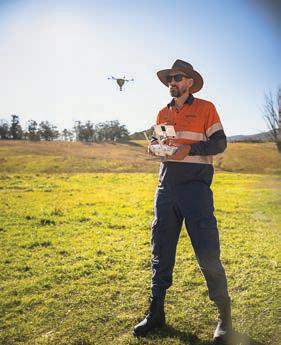
KELSIE TIBBEN
CHIEF EXECUTIVE OFFICER
JOHN MURPHY
CHIEF OPERATING OFFICER
CHRISTINE CLANCY
MANAGING EDITOR PAUL HAYES
EDITOR
TOM PARKER
Email: tom.parker@primecreative.com.au
ASSISTANT EDITOR
ALEXANDRA EASTWOOD
Email: alexandra.eastwood@primecreative.com.au
JOURNALISTS
OLIVIA THOMSON
Email: olivia.thomson@primecreative.com.au
Tom Parker Editor
Email: kelsie.tibben@primecreative.com.au
CLIENT SUCCESS MANAGER
JANINE CLEMENTS
Tel: (02) 9439 7227
Email: janine.clements@primecreative.com.au
SALES MANAGER
JONATHAN DUCKETT
Tel: (02) 9439 7227 Mob: 0498 091 027
Email: jonathan.duckett@primecreative.com.au
DESIGN PRODUCTION MANAGER
MICHELLE WESTON
michelle.weston@primecreative.com.au
ART DIRECTOR BLAKE STOREY
blake.storey@primecreative.com.au
significantly in recent years as industries like mining acquaint themselves with the company’s approach to ecosystem restoration. This year has been particularly noteworthy, with Dendra advancing a major project in the United Arab Emirates while continuing to extend its offerings to mining operations across Australia. In fact, co-founder and CEO Susan Graham called 2023 a record year for several of its Australian customers – something made possible by the company’s unique RestorationOS platform. Dendra’s growth strategy is to build scale into whatever work it does. Technology improvements have enabled Dendra to achieve scale improvements by a multiple of 10, including scale improvements by a multiple of four in 2023.
Cover image: Dendra

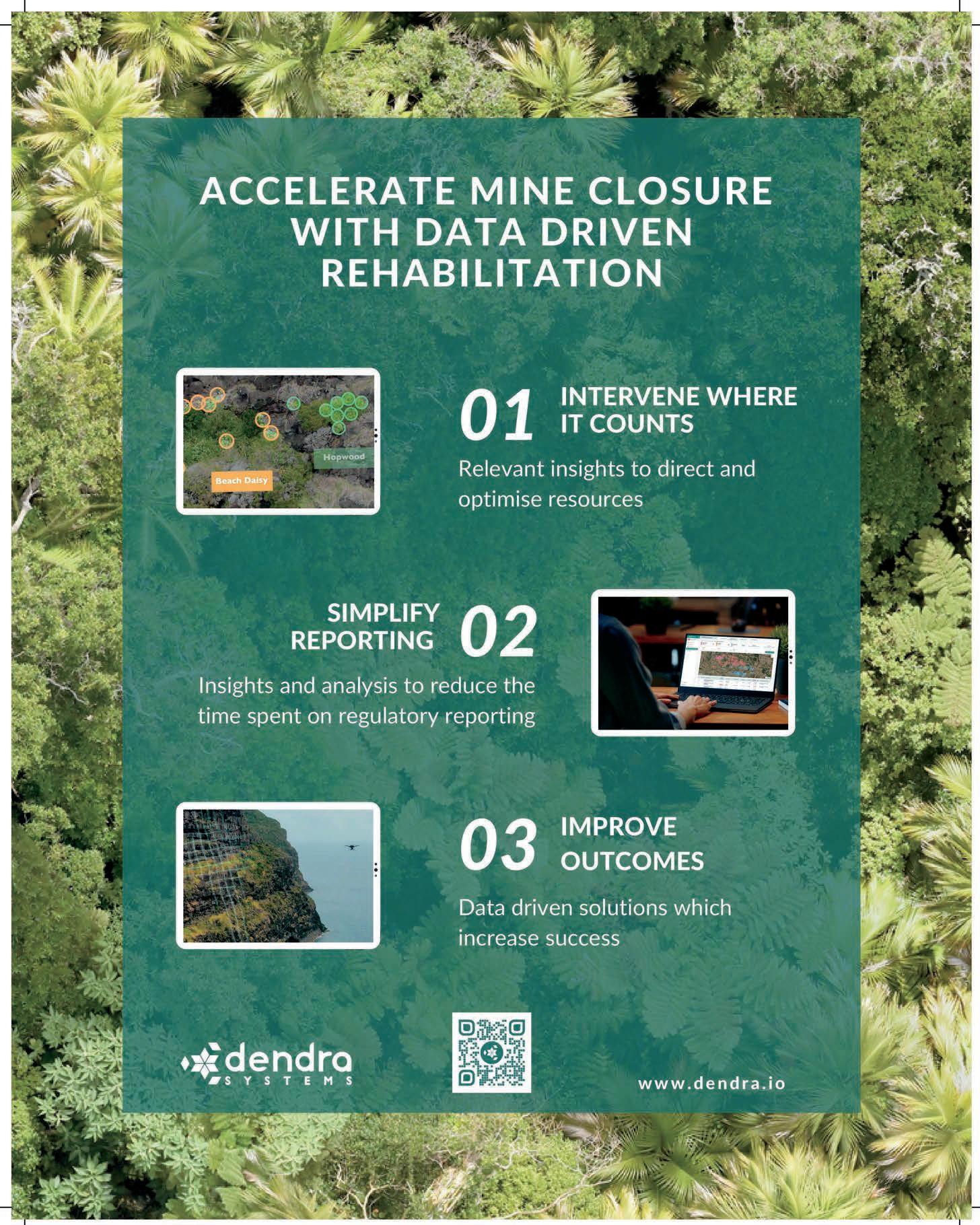



Overcoming a critical conundrum
When industry leaders came together in Sydney for IMARC 2023, the Australian critical minerals sector was a major topic of discussion.
8 INDUSTRY OUTLOOK
A transformative year
As the Australian mining sector gears up for 2024, Australian Mining reflects on positive changes made in five key areas of the industry during 2023.
10 INDUSTRY OUTLOOK
Epiroc 2030
Epiroc is making mining operations safer through automation, fewer drill bit changes, and faster evacuation times.
14 INDUSTRY OUTLOOK
Dendra’s record year
Australian Mining sat down with Dendra Systems co-founder and CEO Susan Graham to chat about the company’s 2023 growth spurt.
28 INDUSTRY OUTLOOK
Tackling cybersecurity head on
As organisations across the globe battle the threat of cyber-attacks, Vocus is determined to ensure its customers can safely weather the storm.
31 INTERNATIONAL MINING
PNG into the spotlight
Now operating under new ownership, the PNG Industrial and Mining Resources Exhibition and Conference is set to take the Pacific nation by storm in July 2024.

32 IMARC
A sprawling mining celebration
Australian Mining caught up with several major players at IMARC 2023 to chat about their offerings and takeaways from the conference.
34 PROSPECT AWARDS
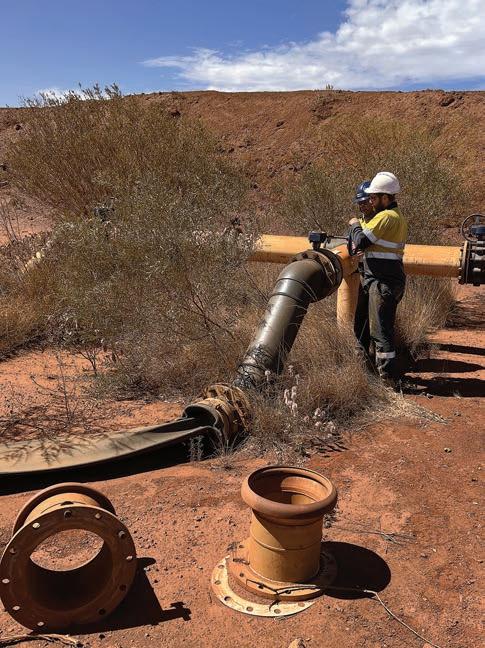
Going above and beyond for the industry
The Australian Mining Prospect Awards returned to Brisbane this year to celebrate the best and brightest of the country’s mining sector.
64 WATER MANAGEMENT
Driving success in underground dewatering
The Flygt Bartail range is Xylem’s new solution for the harshest underground dewatering applications.
REGULARS
3 COMMENT
98 EVENTS
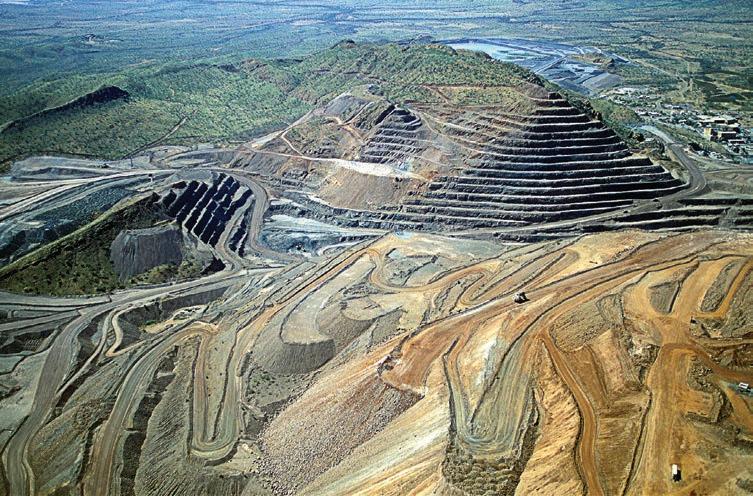
Australia is home to much of the world’s supply of critical minerals. These minerals, such as cobalt, lithium and tungsten, are hot commodities as they play a vital role when it comes to the clean energy transition.
But what is considered ‘critical’ varies between jurisdictions, even between states in Australia. Copper, for example, is considered a critical mineral in South Australia, but has not made the country’s national list.
Minerals added to the list enjoy favourable government policies and access to grants, such as the Federal Government’s newly boosted $4 billion Critical Minerals Facility.
Despite its importance, the Australian critical minerals sector has challenges to overcome, including the complexity and prolonged timelines associated with developing these projects, something many feel can be buoyed by government support.
The 2023 International Mining and Resources Conference (IMARC) acted as an important platform for critical minerals discourse.
EXPEDITING ACCESS TO MINERAL TENEMENTS WILL ENSURE PROJECT TIMELINES ARE ACCELERATED.
SYDNEY TO DISCUSS THE AUSTRALIAN CRITICAL MINERALS SECTOR.
Australian Mining was on hand to document some of the discussions.
When asked what should define a critical mineral, Wyloo chief executive officer (CEO) Luca Giacovazzi said the answer had to do with utility.
“Just like the steam engine drove the industrial revolution, and the combustion engine sparked the development of the oil market into the multi-trillion-dollar industry it is today, I think we’re at the beginning stages of an energy metals revolution,” Giacovazzi said during a panel discussion at IMARC 2023.
“When we think about critical minerals, it’s about playing into that revolution – that shift towards decarbonisation and electrification that’s happening in the world – and asking what metals we need to actually support that shift.”
But Australian Strategic Materials managing director and
CEO Rowena Smith said there was more to the equation.
“I think that supply chain vulnerability is an important component of what constitutes a critical mineral,” she said during the same panel discussion. “The reality is there’s a long list of metals that are critical to modern technologies. If you added them all together, it would be a very long list, but some of those have already got very strong and established supply chains.
“And if we’re talking about government policy being focused on supporting critical minerals growth in Australia, I think it’s important that we’re disciplined about choosing the ones most in need of that support.”
When it comes to government support, miners have raised concerns about project timelines.
“Getting access to ground for exploration at the moment is a major roadblock in Australia,” IGO chair Michael Nossal said. “First you have to negotiate with the stakeholders involved in getting access to a site. Once you’ve been through that, there are traditional landowners and other community stakeholders involved.
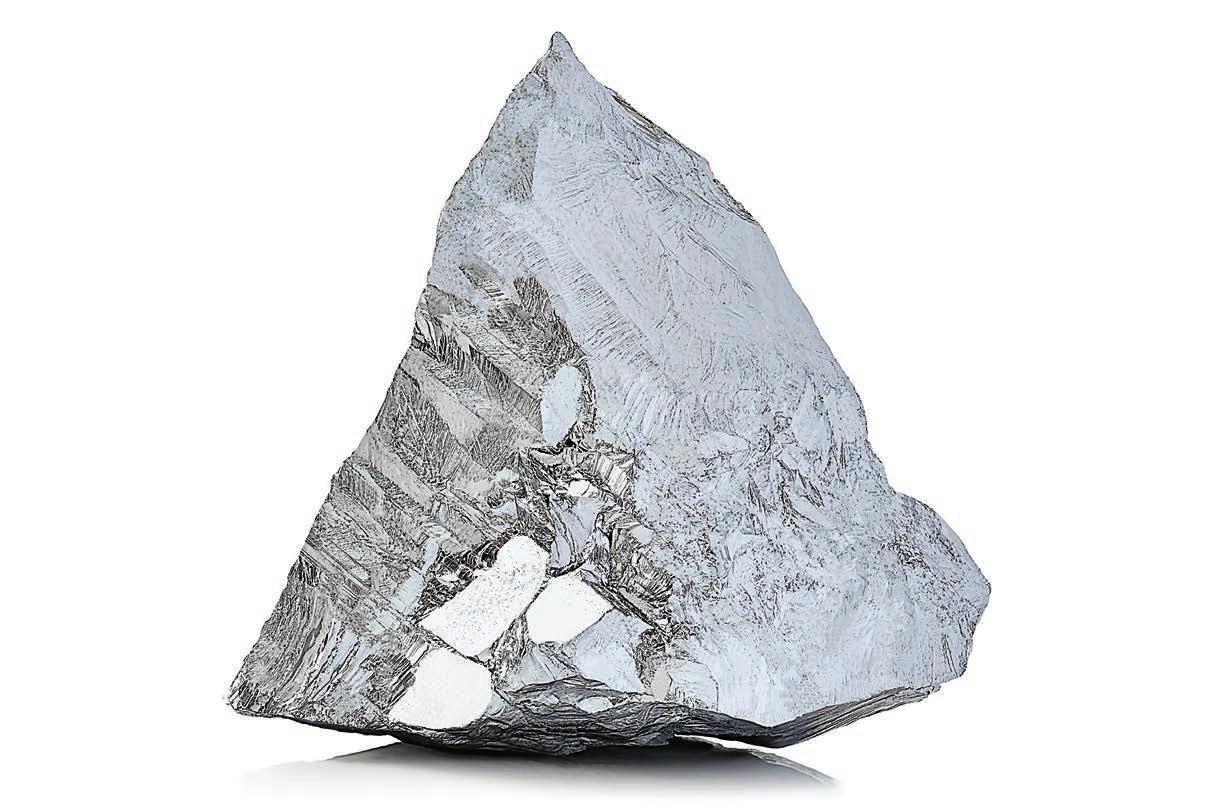
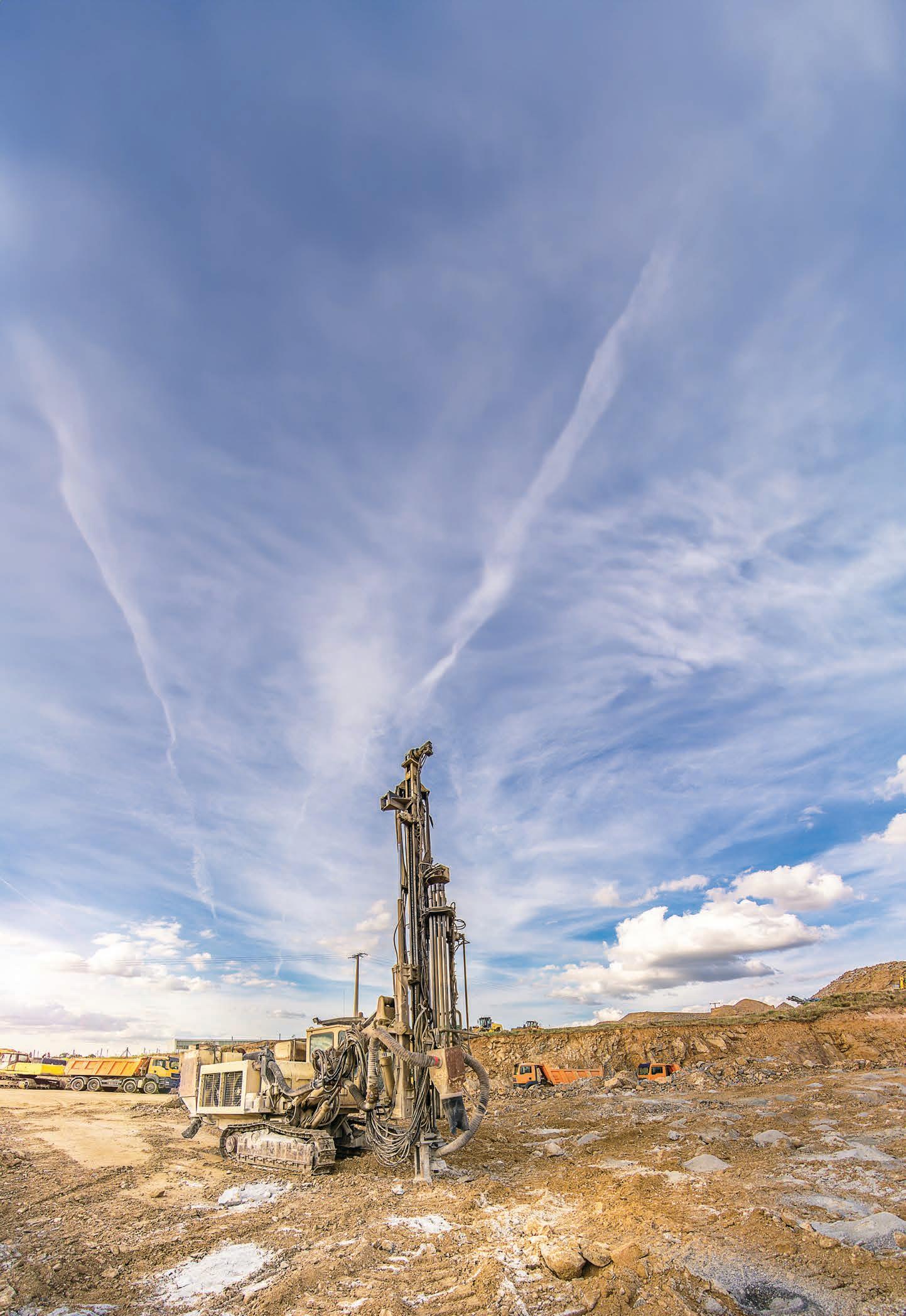

“Then you have to find the mineral and work up to a resource before you get
“I think it would be very valuable for the government to look at ways to shorten the permitting timeframe.”
Resource Capital Funds Australia managing director Brett Beatty also shared his thoughts on the need to accelerate timelines for critical minerals
“A conventional copper mine takes nearly 20 years to develop from discovery through to full production,” Beatty said. “The reality is critical minerals are more
“They’re harder to finance because the pricing is opaque, and there’s a qualification period for some of these products that can take many years. It can be quite complicated and timeconsuming to break into a supply chain.
“I’m not surprised that people are frustrated that things aren’t happening quick enough, but I think the reality is this will take us some serious time and planning to work through these challenges.”
Smith agreed, adding her belief that it is also important for the government to support more advanced projects with
“Our critical minerals project in Dubbo, New South Wales, is 15 years in and has navigated a lot of these hurdles,” Smith said.
because the larger OEMs (original equipment manufacturers) have got very ambitious carbon net-zero targets.
“One of our major hurdles is: can we commit our operations to these zero-carbon deadlines in line with what the OEMs want? That’s why access to low-cost renewable power is critical for these projects.”
While critical minerals are essential components for modern technology, the process by which they are recovered is just as important.
Manufacturers – driven in part by customer sentiment – are more frequently looking to lower carbon emissions through their supply chains. This falls under the broader environmental, social and governance (ESG) umbrella, which is critically important to the modern market.
Transparent mining is a component of this situation, with customers wanting manufacturers to ensure the materials they use are responsibly sourced.
“People have been wondering if there is a way to prove the provenance of metals using blockchain and other technology, but it’s very difficult to do,” Giacovazzi said.
between the cost of going downstream in Australia versus the cost of going downstream internationally.
“It’s a difficult task, but there are clever ways of doing it. There are lots of different incentives, like production tax credits, that you can use.”
Given Australia has long been a raw material supplier, onshore processing has been a hot topic in the local sector in recent years. Nossal said downstream processing in Australia is not just a matter of cost, but expertise.
“If you look at something like downstream processing of lithium in Australia, there hasn’t been very much of it,” he said. “And what we’re finding is there’s not a lot of in-built expertise in the country around chemical processing.
“The skill base needed for processing is also another roadblock and something that the government can assist with in terms of immigration policy and skilled migration.”
The challenges associated with critical minerals are many and will require considered cooperation between the industry and government to address, both nationally and abroad. Despite the challenges, the potential payoff for the country is significant.
“Another way to accomplish this is for countries like Australia to go downstream and produce a finished product that you can then sell to an OEM who can then tell their customers that they’re using a very clean form of nickel.
“We have an opportunity to strengthen the midstream. We must play to that strength – and play fast.” AM AS
“We’re now at the point where we’re looking at offtake agreements and funding. That’s the point where infrastructure becomes really important
“Where we need government to play a big role is in balancing the scales
“This is the golden age for critical minerals,” Smith said. “It’s an opportunity that requires us to act. If we leave it for five years and think that we’re going to be able to establish ourselves in time, then we will have missed that opportunity.
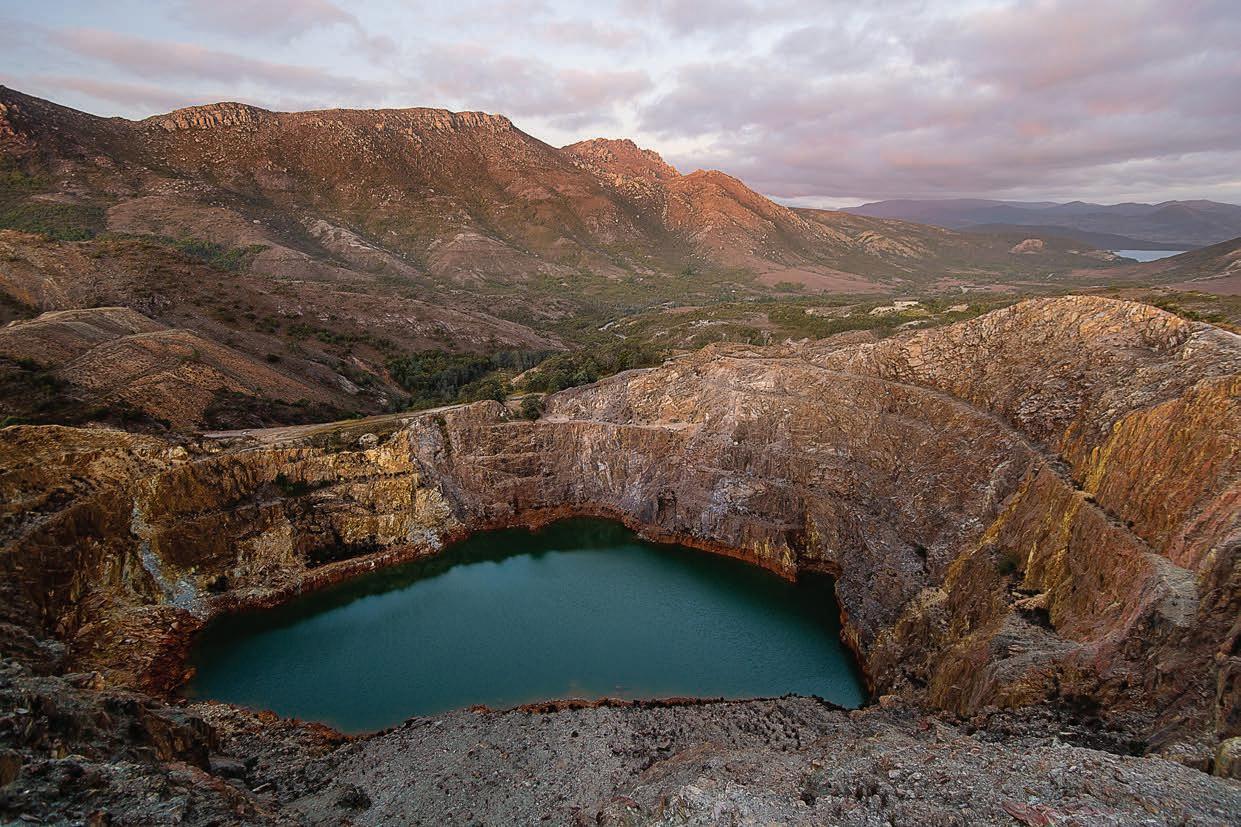
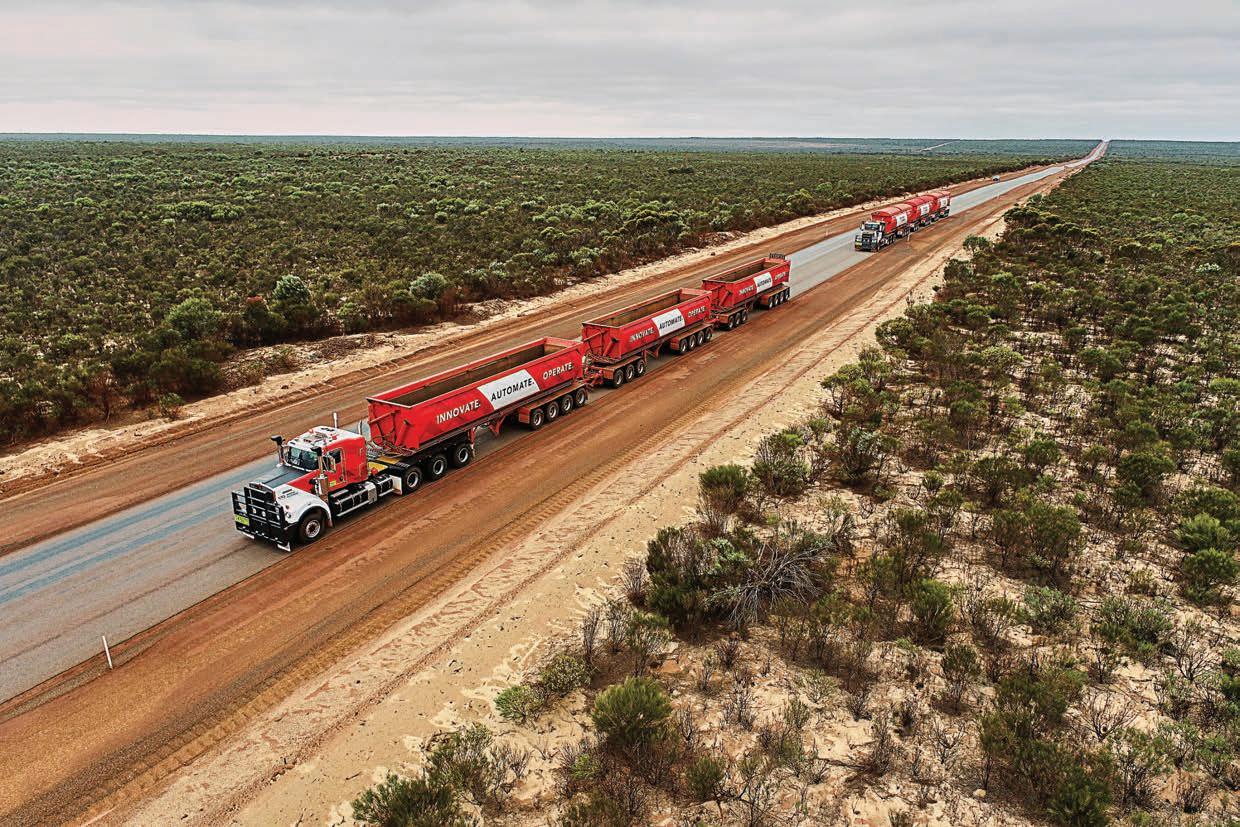
THE AUSTRALIAN RESOURCES INDUSTRY HAS HAD A BUMPER YEAR. AS THE SECTOR GEARS UP FOR 2024, AUSTRALIAN MINING REFLECTS ON POSITIVE CHANGES MADE IN FIVE KEY AREAS DURING 2023. THE WORLD’S FIRST FULLY AUTONOMOUS ROAD TRAINS FROM HEXAGON WERE DEVELOPED FOR MINRES’ ONSLOW IRON
Throughout 2023, mining companies and governments introduced new legislation, technology, and safety measures to work towards implementing greater environmental, social and governance (ESG) efforts.
This trend was especially true in Australia, and is expected to continue into the new year.
According to business management consultants Ernst & Young, ESG will remain the greatest business risk and opportunity facing the global mining and metals sector in 2024 for the third year in a row.
Australian Mining takes a look at how the Australian mining sector has used 2023 to prepare itself to meet greater ESG transparency, among other trends.
The critical minerals boom reached new heights this year, most notably through the release of the Federal Government’s Critical Minerals Strategy.
Introduced in June, the Critical Minerals Strategy aims to grow Australia’s critical minerals wealth by providing a framework that the Federal
Government will use to guide future policy decisions.
“The new Critical Minerals Strategy outlines the enormous opportunity to develop the sector and new downstream industries which will support Australia’s economy and global efforts to lower emissions for decades to come,” Federal Resources Minister Madeleine King said.
“While the potential is great, so too are the challenges. The strategy makes it clear our natural minerals endowment provides a foot in the door, but we must do more to create Australian jobs and capitalise on this unique opportunity.”
To support the strategy, Australia’s critical minerals list is expected to expand in the new year.
With minerals such as lithium, tungsten and vanadium already on the list, King said minerals like bauxite, iron ore, coking coal, copper and nickel are Australian commodities that are crucial for the global energy transition. However, she didn’t confirm that these commodities would be added to the list.
“Our critical minerals list is different to some other nations. Other nations craft theirs on what they have, what’s scarce and what they can’t get, whereas we’ve got most of it. So it’s crafted on
another basis of what is of geostrategic importance for us and our neighbours,” King said at the Australian Financial Review Energy and Climate Summit.
“We also have to consider our region and our partners because they’re an important part of our prosperity. That’s always going to figure in it.”
While industrial relations reforms such as the ‘same job, same pay’ and ‘closing loopholes’ bills made a splash during 2023 – and will most likely continue to do so in 2024 – the Aboriginal Cultural Heritage Act 2021 reverting to the Aboriginal Heritage Act 1972 had a strong effect on the Western Australian mining sector.
The catalyst for the Bill change was the May 2020 Juukan Gorge incident, when Rio Tinto blasted two sacred rock shelters while exploring for iron ore.
To prevent similar incidents from happening in the future, the WA Government introduced the Aboriginal Cultural Heritage Act 2021 in December 2021. The Bill came into effect in July 2023.
Under the legislation, WA landowners were required to check if cultural
heritage sites were present on the land before undertaking anything which may compromise the sites.
However, following public workshops, education sessions, and consultation with key stakeholders, the WA Government decided to revert back to the Aboriginal Heritage Act 1972, with some key amendments.
The restored legislation’s amendments included the newly formed Aboriginal Cultural Heritage Council taking on the role of the committee that was established under the 1972 Act to make ministerial recommendations.
Proponents and native title parties were also given the same right of review for Section 18 decisions, with clear timelines and an ability for the WA Premier to call-in a decision of ‘state significance’ to act in the interests of all WA residents.
Section 18 refers to the part of the Act that states the minister must provide approval for every action undertaken at the site.
When a Section 18 has been approved, it is a requirement for the owner to notify the minister of any new information about an Aboriginal site.
“The Juukan Gorge tragedy was a global embarrassment, but our response was wrong, we took it too far, unintentionally causing stress, confusion and division in our community,” WA Premier Roger Cook said in August.
“The complicated regulations, the burden on landowners and the poor rollout of the new laws have been unworkable for all members of our community – and for that, I am sorry.
“The original intent of the legislative change nearly two years ago, was to prevent another Juukan Gorge – and (the WA) Government will deliver on that commitment.”
In September 2023, the amended legislation opened for public consultation.
This year has seen an emerging pattern of mergers and acquisitions (M&A) as ASX-listed mining companies fought to expand their portfolios.
Perhaps the two biggest mining acquisitions seen in 2023 were BHP’s takeover of OZ Minerals in May for $9.63 billion, and Newmont’s acquisition of Newcrest in November for $26.2 billion.
OZ Minerals and Newcrest are both Australian gold and copper mining companies that were taken over by major global miners. Copper notably has a variety of end uses in a green economy, whether it be through electricity distribution, electrical equipment and devices, industrial machinery, wind turbines, solar panels and, of course, powering electric vehicles.
BHP chief executive officer (CEO) Mike Henry said the takeover of OZ Minerals would provide growth opportunities around the world.
“This acquisition strengthens BHP’s portfolio in copper and nickel and is in line with our strategy to meet increasing demand for the critical minerals needed for electric vehicles, wind turbines and solar panels to support the energy transition,” he said.
“Combining our two organisations will provide options for growth, bring new talent and innovation to unlock these resources in a sustainable way.”
Newmont CEO Tom Palmer echoed similar sentiments regarding Newmont’s acquisition of Newcrest.
“This milestone represents a pivotal and historic moment in our strategy to create the world’s premier gold and copper company by consolidating Tier 1 assets in the world’s most favourable mining jurisdictions,” he said.
Sibanye-Stillwater acquiring New Century Resources for $120 million and Mineral Resources (MinRes) acquiring Norwest Energy for $497 million.
This year also saw Wyloo Metals acquire Mincor Resources for $760 million, with Ring of Fire Metals, Wyloo Metals and Mincor now unified under the brand name Wyloo.
equipped with an autonomous haulage solution provided by Hexagon.
The world’s first fully autonomous road trains were designed and developed for MinRes’ Onslow iron project in WA.
The trains are expected to help in removing the risk of driver fatigue, increasing fleet availability, lowering operating costs and reducing fuel use and emissions.
has these types of road trains operating 24–7, pulling this quantity of material on a 365-day basis.
“Hexagon couldn’t have achieved this successful milestone without MinRes and vice versa.”
As the end of 2023 approaches, so too has the deadline for mining companies to comply to the Respect at Work Act.

The Respect at Work Act was introduced in December 2022, and required employers to adopt proactive measures to prevent sexual harassment, sex-based discrimination and related victimisation. This covers not only the actions and behaviour of the employer, but also their employees and others who work for them.
Under previous laws, employers could be held vicariously liable for sexual harassment and discrimination where they failed to make all reasonable steps to prevent the behaviour from occurring.
While this is still the case, the new legislation enforces a positive duty on employers to take reasonable steps in eliminating sex-related discriminatory behaviours in the workplace.
This means employers need to proactively take action to prevent unacceptable behaviour relating to sexual harassment in their workplace, regardless of whether a complaint has been made.
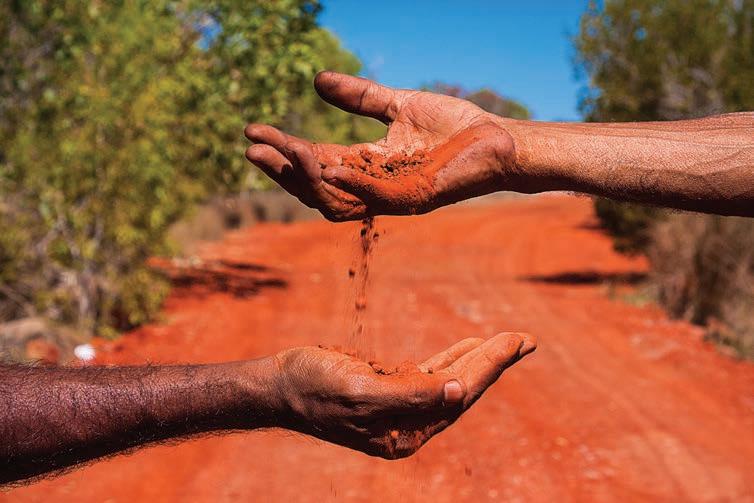
“Once complete, our combined business will feature ten, Tier 1 operations supporting decades of safe, profitable, and responsible gold and copper production, with best-in-class sustainability performance.”
Other noteworthy transactions that took place in 2023 included
Many new innovations were created in 2023 to assist mining companies in meeting global climate goals, while simultaneously reducing maintenance and production costs and increasing workplace safety, productivity and efficiency.
A key example of this was MinRes’ agreement with Hexagon. In July, MinRes announced it would purchase a fleet of 120 fully autonomous road trains
“The ability to see a road train that’s pulling over 300 tonnes, three trailers over a 120km road, and to be able to take that from a mine site to port without having to put in any infrastructure like conveyors or rail ... is exciting,” Hexagon mining division chief technology officer Robert Daw told Australian Mining earlier this year.
“All of these solutions and expertise come together to create that world-first. We’re not aware of anywhere else that
As part of the changes, the Australian Human Rights Commission (AHRC) has been empowered with the ability to inquire into, and report on, issues of systemic unlawful discrimination or suspected systemic unlawful discrimination.
Owing to the gravity of the changes, employers have been given a oneyear grace period to demonstrate this positive duty of care. That door closes on December 13 this year, at which time the AHRC will commence its new responsibilities.
“Australia must take active steps to prevent unlawful workplace behaviour before it even begins,” AHRC president Rosalind Croucher said in August.
“With one in three Australians reporting they’ve been sexually harassed at work over the last five years, leaders of organisations and businesses play a pivotal role in setting the benchmark for best practice in preventing harassment and discrimination in Australian workplaces.
“This is a significant moment for leadership. Implementing the positive duty is an opportunity for Australia to change the places in which we work – to be safe, inclusive, gender-equal, and free from sexual harassment and discrimination.”
As the mining industry gears up for another big year in 2024, the progress of 2023 shows the sector is atoning for its shortcomings and growing as a result. AM
EPIROC IS MAKING MINING OPERATIONS SAFER THROUGH AUTOMATION, FEWER DRILL BIT CHANGES, AND FASTER EVACUATION TIMES.
The future of the mining industry lies in sustainable practices; but sustainability goes beyond reducing carbon footprint and adopting circular economic principles. A major of component of sustainability is safety.
In Deloitte’s ‘Tracking the Trends’ report for 2023, the consulting company identified safety as the foundation for a secure organisation.
“Generally speaking, fatality rates have been steadily declining across the industry as the mining sector places an increasing emphasis on physical safety,” the report stated.
“Mining and metals leaders who can seamlessly integrate and have genuine engagement, action and advocacy for all aspects of safety will lead their organisation towards a more sustainable, secure, resilient and prosperous future.”
Epiroc knows that ensuring workers get home safe is the most important part of any mining operation. That’s why the original equipment manufacturer (OEM) has set itself the 2030 target of zero injuries across its mining operations.
The path to achieving such a lofty goal is threefold, involving increased automation of hazardous machinery, fewer drill bit changes, and shortened evacuation times.
Automated machinery helps keep workers away from the frontlines of mining operations, minimising human contact with potentially hazardous equipment. Epiroc is a market leader in automated drilling, loading and hauling technologies.
When it comes to drilling operations, drill rod changes have been known to be hazardous, requiring operators and offsiders to work close to powerful machinery.
One of the latest tools in this space is Epiroc’s Explorac RC30 Smart drill rig, which automates the rod changeover component of drilling operations. While the drilling is still guided by an operator’s trained hand, automated rod

changeover allows workers to stay out of the line of fire.
“Operating a drill rig used to be a two-person operation, with the operator working in tandem with an offsider to sequence rod changes,” Epiroc global product manager – surface exploration David Benton told Australian Mining
“The Explorac RC30 Smart automates that process, allowing the machine to do a full rod changeover sequence with the push of a single button. This is a much safer way of doing things since there’s less opportunity for human error.”
Another example is Epiroc’s Pit Viper drill rig range for rotary drilling. Capable of completing an entire drill pattern autonomously without an operator on-board, the Pit Viper is 22 per cent more productive than a conventional drill rig system, with the added benefit of keeping workers safe in a control room.
Epiroc’s Boltec auto bolt reload (ABR) is another example of how the OEM is improving safety through automation.
The Boltec ABR is the first ever underground rock reinforcement drill rig of its type. Its main design feature is the fully mechanised bolt reloading system that automatically feeds bolts from a large carrier magazine to the feed magazine, all while the operator remains safe inside the cab.
Another angle of Epiroc’s 2030 zeroaccidents goal is improving safety by reducing drill bit changes.
One of the methods by which Epiroc achieves this goal is with the Powerbit X, a drill bit with a diamond protective layer that provides the drill bits longer

service life, meaning fewer changes and less exposure to hazards for operators.
And when it comes time to change drill bits, rigs such as the Pit Viper can perform this function automatically thanks to Epiroc’s automatic bit-changer technology, allowing operators to quickly make changes from the control room.
When working underground, ensuring miners are able to be reliably coordinated, especially in the case of an emergency evacuation, is a critical safety consideration.
Epiroc has revolutionised underground mine safety with Mobilaris Emergency Support, a real-time workforce safety toolbox that allows rescue leaders to better coordinate evacuations.
Mobilaris is a technology that visualises the live location of workers in a mine. The system can relay emergency messages through mine phones and related equipment such as the Mobilaris virtual tag and the Mobilaris cap lamp. Personnel can easily acknowledge emergency warnings with the click of a button, allowing rescue leaders to see who is aware of danger and who is not.
“Ensuring that evacuees are mobilising towards safety rather than the hazard and ensuring people are using the shortest possible routes to refuge chambers is heavily dependent on realtime information,” Epiroc product sales manager Andreas Prill said.
Mobilaris can highlight and prioritise individual personnel for rescue efforts where necessary, such as if they are unaware of the emergency, injured or trapped. The technology can even guide rescue personnel remotely in real-time.
“You can’t improve what you can’t measure, and you can’t measure what you can’t see,” Prill said.
“Real-time data allows for the removal of uncertainties and variables. This means mine sites can stabilise and then optimise operations, benefitting not just their ability to ensure safety but also the productivity of the mines.
“Knowing what is working and what isn’t in real-time is how safety and productivity is improved.”
With its Mobilaris Emergency Support, Epiroc is able to shorten evacuation times by 25–50 per cent.
And through its threefold approach to mine safety, Epiroc is paving the way for safe practices in the mining industry in pursuit of its 2030 zero-accidents goal. AM

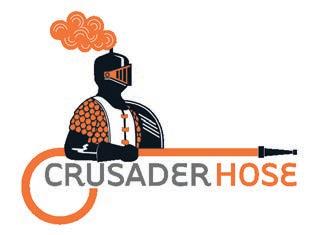


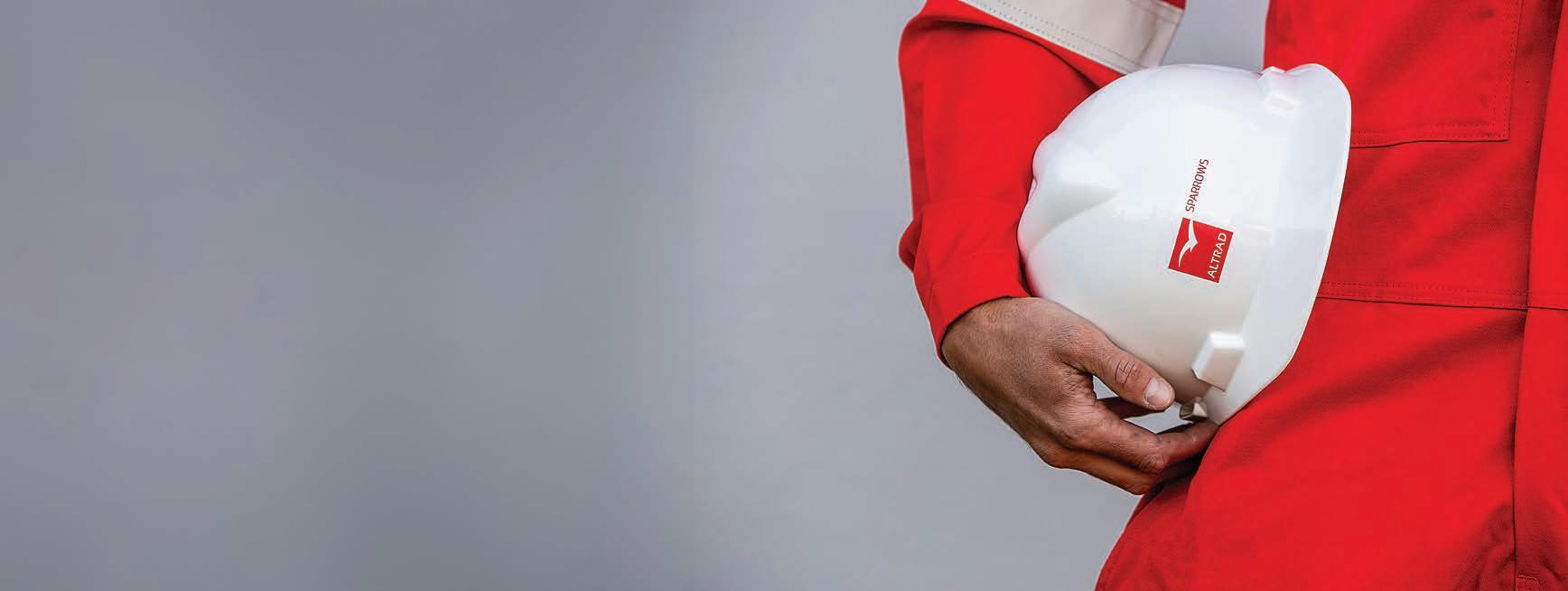
Prior to last year, Sparrows Group was widely known as a crane and lifting equipment contractor that specialised in Australia’s offshore oil and gas sector, while Altrad was one of Australia’s largest industrial service providers with a major presence in the global mining industry.
Altrad was previously unrepresented in the cranes and lifting space, but that all changed when it acquired Sparrows Group in 2022.
The merged entity, known as Altrad Sparrows, wants to bring its combined capabilities to the Australian mining industry.
“The Sparrows acquisition was largely a vertical integration strategic move that was designed to incorporate aspects of the business that Altrad hasn’t worked within, but compliments and supports Altrad’s existing capability,”
Altrad Sparrows cranes and lifting manager Australia Matthew Byles told Australian Mining
“Altrad has a heavy footprint in the WA mining industry, with significant contracts with many major miners. That experience, expertise and performance
in the mining industry will provide a pipeline to Sparrows, while adopting the new brand of Altrad Sparrows.
“We’re effectively combining Altrad’s reputation and mining footprint with Sparrows’ expertise in cranes and lifting.”
More specifically, Altrad Sparrows is looking to move into the overhead crane sector.
“We’re looking to apply our offshore record and expertise in project management, asset management, compliance and maintenance inspections, and the processes that come along with that,” Byles said.
“It’s very challenging for a company like Altrad Sparrows to get a large crane maintenance contract with a major miner because we haven’t had that presence until now. But providing turn-key solutions for new cranes, crane modernisations and overhauls, and endof-life assessments is where we have a high level of expertise and experience.”
Altrad Sparrows’ departments such as safety, quality and contract management are based in key areas of regional Western Australia, making maintenance easier for clients.


“Altrad has existing warehouse and maintenance facilities throughout the Pilbara, such as in Newman, Karratha and Port Hedland,” Byles said.
“That is a differentiator between us and the rest of the market because no other crane company in WA has multiple physical facilities anywhere in the Pilbara.
“This is important because mining clients prefer to have stock for things like spares on hand. For example, they might need to bring a hoist down off a crane and then to do an overhaul locally, as opposed to bringing it to Perth, which would incur significant more cost.
“We’re leveraging Altrad’s capability and their existing footprint in the mining industry with Sparrows’ capability, engineering, inspectors and technicians that we’ve currently got available in order to focus on high-end projects.”
Altrad Sparrows’ main objective for 2024 is to gain awareness and conduct the delivery of new crane projects, along with crane overhauls, compliance inspections, and project and asset management.
“We’ve already demonstrated these capabilities offshore with a reputation for world-class delivery, and we’d like to bring them onshore,” Byles said.
“Another differentiation is Altrad Sparrows’ consultative approach. Crane maintenance service providers should be an asset manager and advisor for their clients, not just a guy on the ground in boots and hi-vis who carries out maintenance every three months.
“The way that preventive and predictive maintenance has matured in industrial equipment, especially in mining industries, is you need to have someone who’s a consultant and adviser to the client, who can provide advice around end-of-life decisions, modernisations, and maintaining the equipment and ensuring it’s compliant.
“Altrad Sparrows has a large team of crane technicians and engineers readily available to deliver all aspects of crane maintenance.
“We want to bring that capability and transfer it to the mining industry.” AM



By utilising the latest technologies we provide an advanced combination of innovative solutions which optimise our customers mining operations performance, sustainability, availability and safety, around the globe.
• Wear parts and solutions for mineral processing, mobile and fixed plant operations
• Digital and equipment connectivity
• Asset condition and performance monitoring
• Design, engineering and manufacturing solutions

bradken.com We supply:
AUSTRALIAN MINING SAT DOWN WITH DENDRA SYSTEMS CO-FOUNDER AND CEO SUSAN GRAHAM TO CHAT ABOUT THE COMPANY’S 2023 GROWTH SPURT.
Founded in 2014, Dendra Systems has grown its footprint significantly in recent years as industries such as mining acquaint themselves with the company’s inspired approach to ecosystem restoration.
This has Dendra co-founder and chief executive officer (CEO) Susan Graham excited not only for the company’s future but also the future of sustainable mining worldwide.
“It’s been a record year for a number of customers joining us in Australia and benefiting from our unique RestorationOS approach,” Graham told Australian Mining.
“This is a reflection on our customers championing us and telling colleagues across the industry about how our approach has been able to help transform the way that they operate, and for them to achieve their own targets.”
Dendra’s RestorationOS combines ecology, data science, machine learning, and automation to restore biodiverse ecosystems at scale.
Within the Australian mining sector, this means harnessing Dendra’s drone
DENDRA’S SEEDING DRONES ENABLE AERIAL SEEDING FOR BIODIVERSITY AT SCALE.
technology, seeding solutions, endto-end digital platform, and domain expertise to progressively rehabilitate and restore mining operations.
Graham said technology improvements over the last nine years have enabled Dendra to achieve scale improvements by a multiple of 10. In 2023 alone, the company has achieved scale improvements by a multiple of four.
“This techno-economic curve that we’re driving, where we’re able to continually increase the scale capacity that we can operate, allows our customers to operate over much larger areas and restore larger areas more effectively,” Graham said.
“As part of our restoration operating system, we’re collecting data, we’re analysing it using the best ecology insights, including AI (artificial intelligence), to then provide actionable insights.
“Whether it’s actioning with Dendra drones that go out and do the seeding, or its actioning with the weed-spraying contractors, the erosion managers or the biodiversity specialists, there’s so many people involved in restoring an ecosystem, that
providing our RestorationOS platform enables the coordination of this very complex environment.”
Understanding that effective biodiversity management begins in the pre-mining phase, Liontown Resources recently engaged Dendra to monitor and survey a 2700-hectare area within its Kathleen Valley lithium project in Western Australia.
Dendra deployed its drone fleet to conduct a series of targeted surveys over existing and proposed land disturbance areas. By mapping and monitoring two priority flora species – Grevillea inconspicua and Hemingenia exilis –Dendra enabled Liontown to understand species’ abundance across the Kathleen Valley tenement.

CO-FOUNDER AND CHIEF EXECUTIVE OFFICER

Four weed species were also surveyed, alongside areas of erosion, habitat features, and legacy infrastructure.
“The drones collect high-resolution data, which is then processed through the Dendra platform, allowing us to determine not only current baseline data, but will also help us in the future to quickly identify any changes to Jones Creek, a culturally significant seasonal waterway and a Tjiwarl
songline,” Liontown said in its 2023 ESG (environmental, social and governance) report. “The technology will enable us to identify groundwaterdependent flora and reliant terrestrial fauna species, surface water movement, and monitor soil and sediment.”
Liontown has also gained important safety insights into its Kathleen Valley tenement, with high-resolution imagery identifying legacy infrastructure that may pose safety risks; for example, uncapped drill holes from previous


DENDRA HAS BECOME A KEY ENVIRONMENTAL TECHNOLOGY PARTNER FOR THE AUSTRALIAN MINING INDUSTRY.


future critical infrastructure such as determining a wind farm location based on biodiversity parameters like tree height classification.
Liontown credited Dendra’s ability to broaden and expedite ecological management.
“Traditional on-ground approaches to ecological surveys are slow and require a substantial amount of time to capture a small area of land,” Liontown said.
“Dendra’s platform and ecology-aware
characteristics of the entire Kathleen Valley project site, but also provide continuous monitoring so that we can see changes in the landform over time.”
Liontown has extended its use of Dendra’s technology to its Buldania lithium project in the Eastern Goldfields of WA.
Looking ahead to 2024, as Dendra evolves its RestorationOS platform, the company will continue to expand its mining customer base.
“We’re really excited about the new
“We’re opening up in two other major mining geographies, and we’ll be releasing some new platform features as part of our RestorationOS, which will mean customers will have new capabilities in terms of their experience.”
Dendra is also globalising, with a major contract in the United Arab Emirates (UAE) seeing the company redefine mangrove restoration, with a goal to restore 27 million mangroves within five years.
“We have just completed planting of a mangrove area that is more efficient than anybody has ever been able to plant before in the history of all mangrove restoration,” Graham said.
“We’ve established a Centre of Excellence for land restoration in the UAE, covering both large-scale arid and mangrove restoration projects. That will be used as a hub to export globally and allow us to restore mangrove ecosystems at a much larger scale than anybody else has been able to imagine.
“(The year) 2024 will be busy, and it will be a year of significant impact because of the scale we’re operating at and the number of people who are adopting this technology.”
As Dendra grows its footprint, Graham is seeing an Australian mining industry embracing ecosystem restoration more than ever, with increased regulation playing an important role.

“There are more than 50,000 abandoned mines in Australia, which
is because regulation hasn’t always supported industry best practice,” Graham said. “But what we’re seeing now is we’ve got increasing regulation and expectations from the regulator and community to improve practices.
“Then there are global expectations around ESG reporting and requirements where shareholders and their customers – in many cases the end consumer of these materials –have increased expectations around how land is rehabilitated and is reported on.
“And what we’re also seeing is global frameworks being developed, which the mining industry is really paying attention to, such as the Taskforce on Nature-related Financial Disclosures (TNFD).
“So we’re seeing this combination of regulation, ESG requirements and shareholder pressure, as well as global frameworks like the TNFD, leading the mining industry to have better practices and adopt technology to achieve better ecological outcomes.”
Facing heightened ESG pressures and more environmental regulation than ever before, Australian mining companies have the opportunity to solidify themselves as responsible operators in the eyes of not only their stakeholders and shareholders but also society as a whole.
It’s a new revolution, and one that Dendra can help facilitate quickly and efficiently. AM
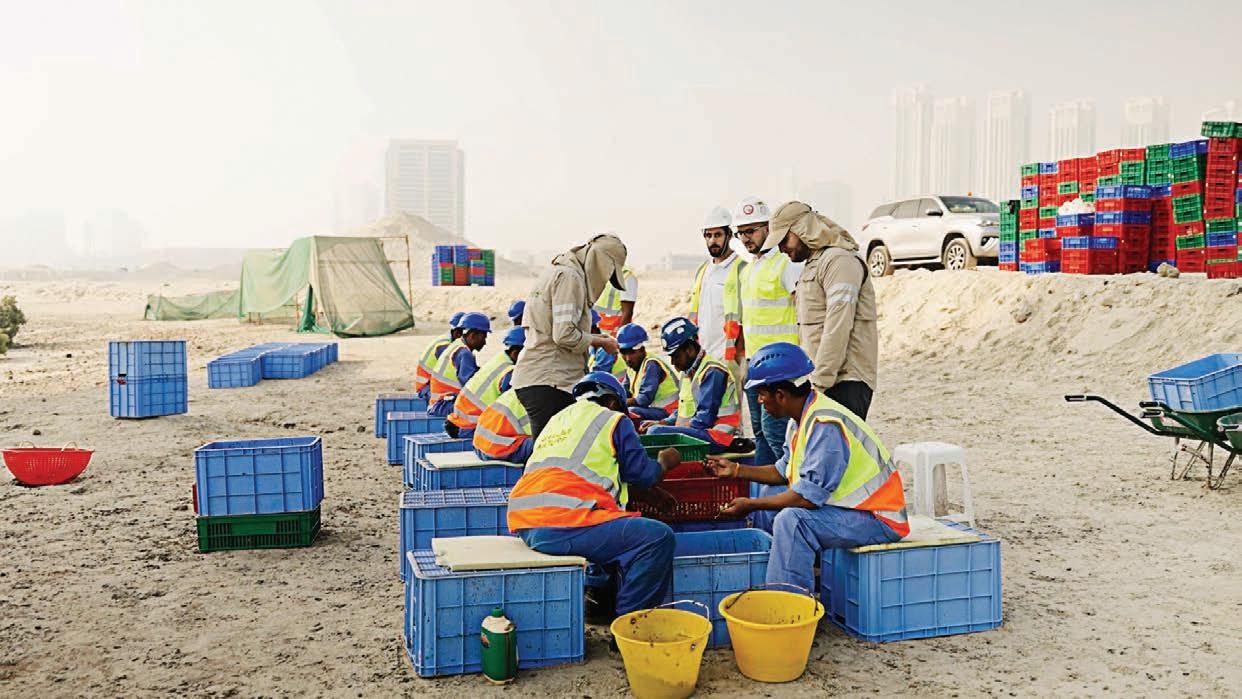
FLSMIDTH ASIA PACIFIC REGIONAL PRESIDENT JASON ELKS SPOKE TO AUSTRALIAN MINING ABOUT HOW THE RESOURCES INDUSTRY CAN BE A HARBINGER OF DECARBONISATION.
It’ll be transformational in 2024.”
When the Asia Pacific regional president of a multinational original equipment manufacturer (OEM) gives you a scoop, it’s worth taking it on-board.
Jason Elks, who is part of a team driving a new vision at FLSmidth, believes mining companies have a unique opportunity to lead the carbonneutral agenda and insulate themselves from the carbon tariffs underpinning the Australian Government’s Safeguard Mechanism.
Under the Safeguard Mechanism, companies that emit more than 100,000 tonnes of CO2-equivalent (CO2-e) per financial year will be required to buy Australian carbon credit units (ACCUs) to offset their carbon footprint.
In the 2023–24 financial year, ACCUs can be bought for $75 per tonne for every tonne a company goes above its 100,000-tonne CO2-e cap. This
FLSMIDTH HAS THE TECHNOLOGIES TO DRIVE A STEP CHANGE IN THE AUSTRALIAN MINING SECTOR.
increases annually with the consumer price index (CPI), plus two per cent.
For the mining industry, the best way of circumventing the Safeguard Mechanism isn’t just by introducing electrification in the pit, through new technologies such as battery-electric haul trucks and loaders, but also by scrutinising the efficiency of fixed plant.
“What we’re talking about is doing more for less – giving you more product for less CO2 per tonne,” Elks told Australian Mining. “We’re not saying we can eliminate CO2, but we can reduce the impact.
“The irony of that is if you look at the tariffs in Australia’s Safeguard Mechanism, it’s a per-tonne tax, and if you’re going to rank CO2 per tonne, fixed plant is the quickest and easiest way to give you a competitive advantage.
“And not many companies, bar a few companies we’re currently running trials with, are looking at it.
“It will be revolutionary.”
Esteemed for its mineral processing offerings, some of FLSmidth’s premium fixed plant include its REFLUX technologies, comprising the REFLUX Classifier (RC), REFLUX Concentrating Classifier (RCC) and REFLUX Flotation Cell (RFC), alongside its crushing, milling and grinding solutions.
The RC has become one of FLSmidth’s most advanced fineparticle, gravity-based separators, using minimal power and water to enable the recovery of more minerals more efficiently.
The product is core to FLSmidth’s broader MissionZero strategy, which is seeing the OEM work with mining customers on a partnership model to provide end-to-end solutions that aim to achieve zero emissions, zero water waste and zero energy waste by 2030.
“A primary focus of ours this year has been to work closer to the customer, move our inventory base closer to the customer, and de-risk their business,” Elks said.

FLSMIDTH’S REFLUX CONCENTRATING CLASSIFIER (RCC).
“So rather than selling a product to a customer, we’re more interested in being a part of the customer’s business and building their business.

“So if I say, ‘Do I want to sell you a crusher?’ No, I don’t. But if I say, ‘Do I want to help your company become a multi-billion-dollar business?’ Of course I do.


“We’re more focused on a partnership approach rather than product sales, and that’s what innovative customers demand.”
The partnership model sees FLSmidth meet with its mining partners monthly, brainstorming ways to optimise for today as well as the future.
“We work with customers on sixto-18-month rolling plans for supply and demand. We look at production schedules, we forecast needs, and we’re pre-empting what the customer base is looking for,” Elks said.
“This in turn allows us to bring our inventories closer to the customer, reduce lead times and therefore reduce risk.”
FLSmidth empowers its mining partners to work intelligently and proactively, considering the mediumand long-term opportunities rather than only operating in the now.
The OEM’s technologies enable miners to drive down emissions now, while orders can be made and processes put in place to decarbonise an entire flowsheet in the years to come.
“Decarbonisation is the answer, there’s no doubt about it,” Elks said.
“And we have to stop haul trucks from emitting diesel particulate – that’s one part of the puzzle. But that’s not going to happen until 2030–2035 when the battery technology catches up and capital equipment is changed out.
“Imagine if we could take 20 per cent off your CO2 footprint per tonne today. It’s not about what we’re innovating, we already have the technology available in some commodities now.”
With trials being conducted with some proactive mining companies,
FLSmidth’s vision for carbon-neutral mineral processing is coming to life.
Elks said the company is engaging miners operating in iron ore, manganese and coal before it builds out from there.
“We’re working with our mining partners to achieve greater beneficiation of their products, so less will go to waste, they’ll recover more, and they’ll ultimately have more saleable product,” he said.
“From studies we have conducted ourselves, supported by theoretical university papers, depending on the product and mine, we could recover up to 50 per cent of mine waste as saleable product.
“This would be revolutionary for a company’s footprint, their tailings requirements, and for reducing capital expenditure on the back end.
“It’s a multi-billion-dollar proposition for iron ore producers each year.”
To achieve a net-zero future, the Australian mining industry will need to ask itself some difficult questions.
Operational footprints will need to be cut significantly for Scope 1 emissions to be reduced, and measures such as the Safeguard Mechanism mean mining companies that don’t cooperate will be penalised.
The most effective decarbonisation plans will be implementing abatement measures now alongside medium- and long-term strategies.
This is where FLSmidth can help, with established beneficiation technologies that can drive down Scope 1 emissions per tonne now while converting mine waste into more saleable product.

industry is starting to have its ‘a-ha’ moment, but it’s going to take greater ambition if the sector is to grab its netzero imperative with both hands.
“This is my plug: between now and 2026, a transformation is going to happen in the Australian mining industry,” Elks said.
it will come from the suppliers, it will come from fixed plant, and it will come from mobile fleet manufacturers.
“We will transform the industry, but the miners have to come with us. They can’t just keep buying what they bought yesterday, or nothing will change.” AM
AS 2023 DRAWS TO A CLOSE, TOTALENERGIES TAKES A LOOK AT SOME OF ITS WINS THROUGHOUT THE YEAR, WHILE ALSO DETAILING WHAT 2024 MIGHT HAVE IN STORE.
Decarbonisation has long been a primary goal for TotalEnergies, and the company has found that 2023 events set the perfect stage to help get this message across.
“IMARC (International Mining and Resources Conference) 2023 was a great opportunity for us to showcase our multi-energy portfolio and our commitment to sustainable development,” TotalEnergies vice president – lubricants, specialties and B2B, Asia-Pacific Middle East, Vincent Minard told Australian Mining.
“We participated in speaking engagements and panel discussions, where we shared our insights and best practices.”
In Minard’s speech at IMARC’s Powering Mines with Renewable Energy Sources presentation, he said TotalEnergies is well-placed to help miners meet their net-zero goals.
“We have studied the various
decarbonisation roadmaps that the mining companies are developing and have noticed that they are not necessarily aligned in terms of products to be used, or the timing of when those products will be needed,” he said.
“At TotalEnergies we look at mining companies not as single entities, but as part of a local or regional eco-system, because we believe that by aligning the milestones on the roadmap we have the best chance of cost optimisation.”
TotalEnergies vice president – global mining, one B2B solutions, Dirk de Bruyn also spoke at the event.
As TotalEnergies continues to invest more in decarbonisation and mining, the company has seen its clients shift toward achieving operational excellence with low-carbon energies.
“We have a wide footprint and presence in over 130 countries, which enables us to transfer knowledge and expertise across different markets and sectors,” de Bruyn said.
“At TotalEnergies, we recognise the
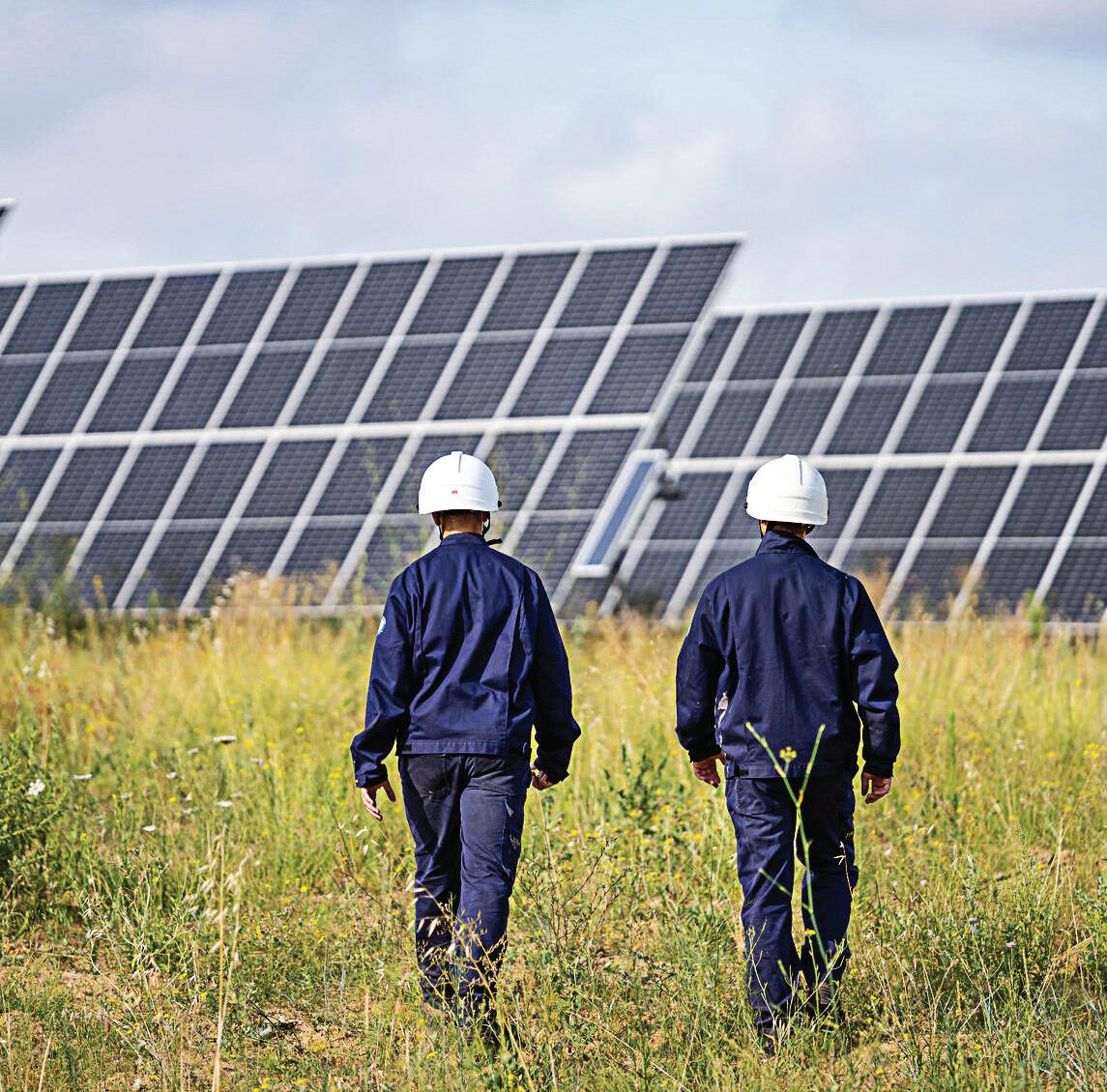
challenges facing the mining industry today in understanding what roadmap they can follow to meet their net-zero objectives.”
With 2025 on the horizon, TotalEnergies is looking into what the mining industry needs and how the company can best support the journey to net-zero.
“There is a lot of work being done on battery-electric vehicles, full electric vehicles, hydrogen or natural gas, and everyone is wondering which new energy
TOTALENERGIES IS EXAMINING HOW IT CAN BEST SUPPORT THE MINING INDUSTRY’S JOURNEY TO NET-ZERO. TOTALENERGIES HAS SET ITSELF AMBITIOUS
will emerge as the winner in mining,” de Bruyn said.
“But we don’t believe that this a race where there will be only one winner.
“With the wide range of equipment in mining, coupled with a range of different life-of-mines and a mix of geographical locations, each with their own local policy and regulations, there is a likely to be a mix of solutions, and even this mix is likely to change as we transition through the options between now and 2050.” AM

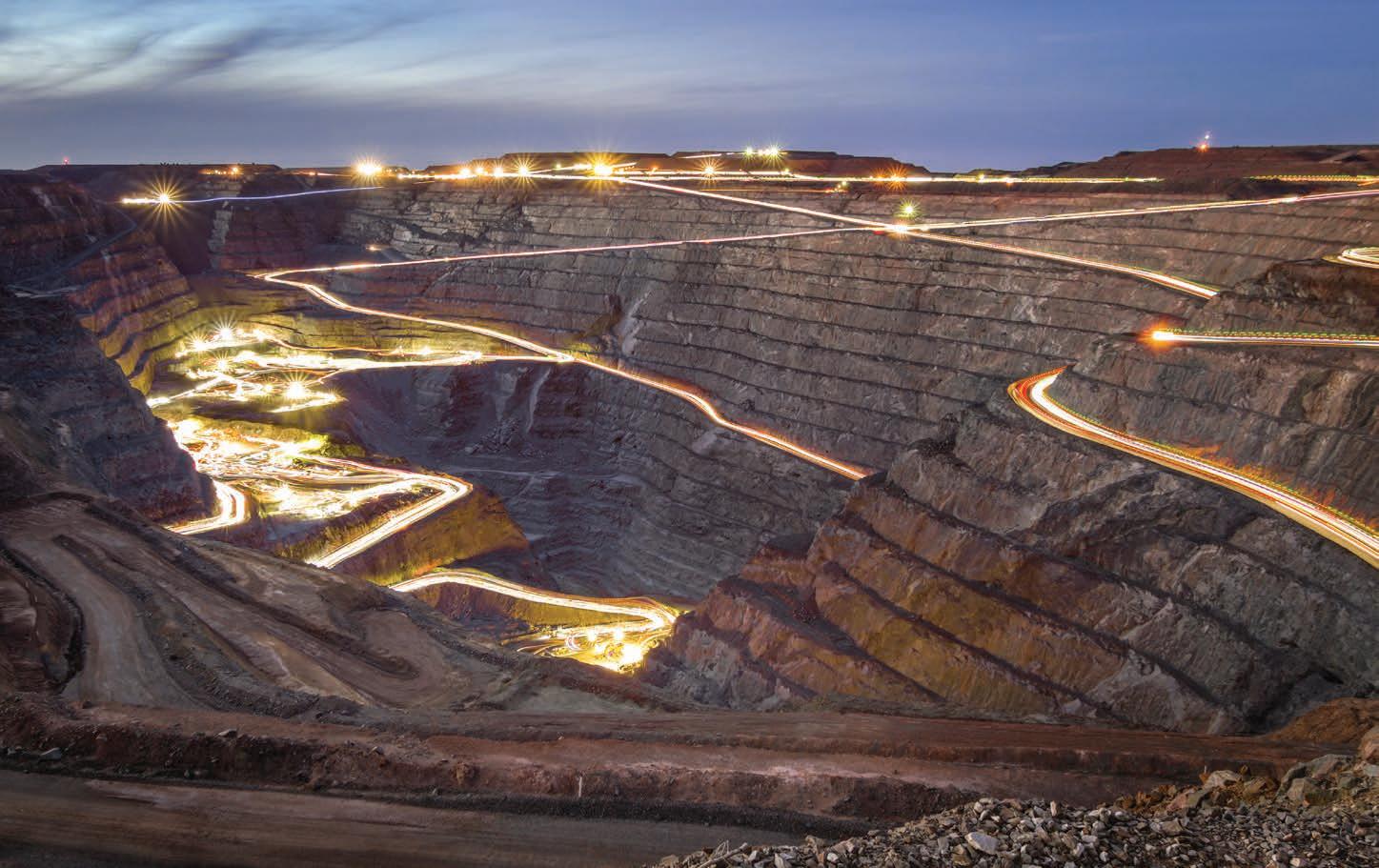
The global merger of Regal Rexnord and Altra Industrial Motion into Regal Rexnord IPS ushers in a new era in Industrial Powertrain Solutions. Renowned brands with world class powertrain products delivering end to end


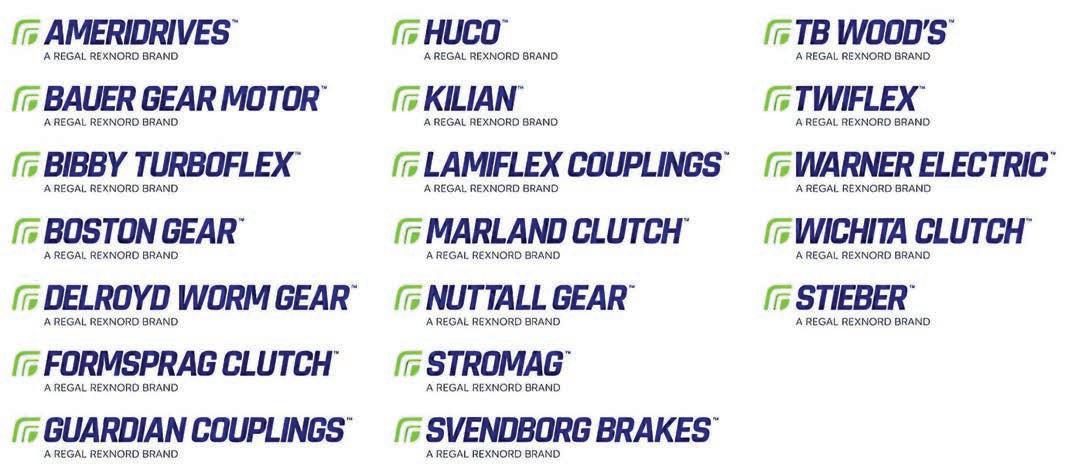











LIEBHERR HAS ALWAYS WORKED TO SUPPORT ITS CUSTOMERS WITH CUSTOMISED SOLUTIONS – AND THAT INCLUDES BUILDING THE BIGGEST EVER LIEBHERR BUCKET FOR THE BIGGEST LIEBHERR EXCAVATOR.
October 13 2023 saw the first of Yellow Iron Fleet’s Liebherr R 9800s roll off the build pad at Atlas Campaspe in central New South Wales, ready to go to work.
The mine, owned and operated by Tronox, has an approved life of 10 years with significant reserve upside. This consists of more than five million tonnes of heavy mineral, which will be processed and sent to Tronox’s pigment plants to produce high-quality titanium dioxide, a bright white pigment that adds brilliance and opacity to a range of everyday products.
In addition to being the first of its kind for Yellow Iron Fleet, this R 9800 is also a first of its kind for Liebherr.
The excavator comes fitted with a custom designed and built backhoe bucket, the largest Liebherr has ever built at 55m3 and the only Liebherr excavator bucket of this size.
The bucket was proudly designed and manufactured by Liebherr-Australia in collaboration with the customer Yellow Iron Fleet.
technical leader Martial Vicq explained the team designed the bucket, working
under certain constraints to ensure the best outcome for machine and customer.
“The overall design is based on the designs of the closest-sized bucket we have, beginning with the parametric design. Then we work with the customer to adapt the new bucket to their needs,” Vicq said.
“From start to finish, the design process, adapting all the dimensions and ensuring the bucket met all fabrication tolerances and ISO standards, took about two weeks.
“But in those two weeks there were many things we had to consider when designing a bucket this large. These include the machine this bucket was to go on, the weight of the bucket, and the physical build process in the fabrication workshop.”
The first consideration for Liebherr was the R 9800’s digging envelope.
“The standard R 9800 bucket, at 47.5m3, is already close to the upper limit of the R 9800’s digging envelope, and now we wanted to put an even larger bucket on it,” Vicq said.
“This meant we had to think of a way to increase the size while remaining
the inside bucket width from 4300mm to 5100mm, a boost of 18 per cent, meant the capacity of the bucket could be increased from 47.5m3 to 55m3, or 16 per cent.
Outside of this change on the fabrication floor, the final thing to consider was the weight of the bucket and what the machine could feasibly handle.
Each Liebherr machine is built to a specific rated suspended load (RSL), and going over the RSL limit could increase the risk of machine instability and reduced component lifetimes.
“We know the weights of various excavated materials and we know the weight that the machine can support,” Vicq said. “Using those bits of information, we were able to design the maximum-size bucket that would fit on the machine while still being productive.”
Increasing the bucket width meant it would be too wide for the standard twoplate bucket roll, which meant there had to be a change on the fabrication floor.
The bucket roll (or the rear roll section) on standard Liebherr buckets is
process for the R 9800 called for three plates rather than the standard two.
Day shift team leader Colby Jachmann from Liebherr-Australia’s fabrication team explained how the increased width impacted the build process.
“Of course, the main difference for this bucket, compared to the other buckets we build, is the sheer size of it,” Jachmann said.
“We have never built anything this big before, so it was a fun challenge for a lot of the team.
“When it comes to putting the bucket together, really the only change was just that we now had to weld three parts together to make the bucket roll. Having three plates does not compromise the strength or integrity of the bucket.”
The final designs came together and were sent to the fabrication workshop in Adelaide, where work began on putting together this mammoth bucket in early April.
Over the course of the build, the Adelaide fabrication teams put in over 2000 man-hours and used 975kg of welding wire. The finished bucket weighs in at around 47 tonnes,

LIEBHERR-AUSTRALIA’S LARGEST EXCAVATOR BUCKET, AT 55M³, FOR YELLOW IRON’S FIRST R 9800 AT TRONOX’S AUSTRALIAN MINERAL SANDS MINE.

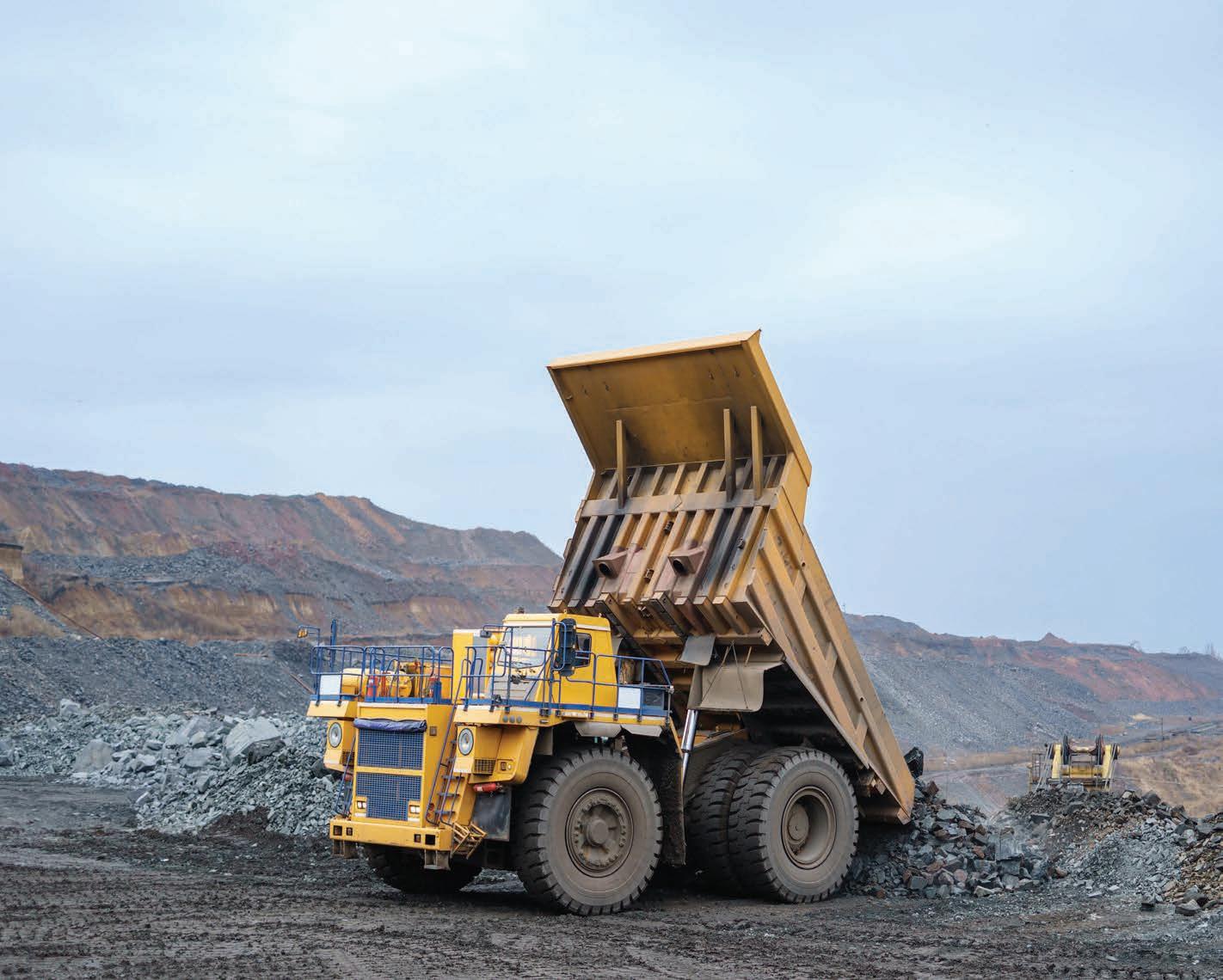



In the realm of mining operations, bund walls serve as crucial safeguards against potential truck rollovers at the tip head. However if your bund wall isn’t compliant, it can instead slow productivity and heighten dangerous safety risks such as trucks traveling over exposed edges.
Decoda’s BundAware™ system utilises LiDAR technology to assess the angle, height, and proximity of bund walls - offering immediate in-cab notifications and enabling
drivers to proactively relocate to a more secure position near the bund wall.
The platform includes real-time heat map tracking analytics of non-complaint bund walls to facilitate prompt rectification and continuous improvement.
By building bund awareness, BundAware™ also builds mine site safety, compliance, productivity and profit.
ASSET KNOWLEDGE OF CONNECTED SYSTEMS HAS BECOME MORE COMPLEX WITH THE RAPID RATE OF TECHNOLOGY ADVANCEMENT. DAD ENABLES THE TRANSITION TO A DIGITAL MODEL OF ASSETS.
As the owner of one of Australia’s leading electrical, control and safety system engineering companies, I&E Systems, Dermot Kennedy was no stranger to the world of documents and the time-consuming and costly work practices of his industry.
It became clear to Kennedy in the early 1990s that the design, delivery and management of complex systems could be done better.
“To invent a paradigm shift, you must have the technical engineering knowledge to do it,” DAD director of relationships Jim Stancombe told Australian Mining.
“The concept of DAD came to life on an electrical upgrade project in Western Australia. In the first instance, the asset owner had a severe blind spot when it came to their complex electrical and control systems.
“Errors in design documents left undiscovered will have exponential cost impacts the later they are found. In a digital model, errors are discovered much more rapidly due to the nature of collaborative and inherent self-checking.”
Seeing the asset owner’s problem as a potentially universal one, Kennedy conceived the software solution called DAD and in 1998 began to develop the tool.
Successfully utilised in over 200 projects, DAD has been used by some of the world’s leading companies on major projects across a range of industries. From small $50,000 projects to large billion-dollar undertakings, the DAD software solution reduces baseline costs by over 50 per cent.
But the DAD team aren’t content to stop there.
“The thinking behind how to detail the way systems work and how to manage asset information has rarely been challenged, yet technology has advanced significantly,” Stancombe said.
“The current document and asset management trends lean toward the digitisation of existing processes without consideration of why the processes exist and if they are still valid in a digital space. This is particularly the case in engineering and asset management.”
The team behind DAD is committed to transforming the way the resources industry works by disrupting the traditional supply chain.
As a transformational change to the fundamental capture and dissemination
DAD REPRESENTS THE COMPLEXITIES OF MODERN SYSTEMS IN A SIMPLE, DIGITAL WAY.

DAD EMBODIES ALL ASSET LIFECYCLES OF COMPLEX SYSTEMS, FROM DESIGN TO DECOMMISSIONING, AND CAN BE INTRODUCED AT ANY STAGE – THE EARLIER THE ADOPTION, THE MORE BENEFIT TO THE OWNER.”
of system information, from sets of drawings and documents to a digital model, DAD is not a like-for-like replacement.
“Our tagline is ‘it’s about time’ and this is where the significant savings come from, cutting time by working smarter than the current documentbased practices,” Stancombe said.
Traditionally, the supply chain is built around document-focused work practices between design, delivery and operations teams that work in silos.
These methods can be expensive and time-consuming and may result in information becoming more inaccurate and therefore less valuable as it’s passed
though the silos, meaning that what is delivered is not suitable to the needs of the downstream users.
“Our niche is disrupting the traditional supply chain to enable digital transformation in system engineering and asset management,” Stancombe said.
“DAD embodies all asset lifecycles of complex systems, from design to decommissioning, and can be introduced at any stage – the earlier the adoption, the more benefit to the owner.”
DAD improves engineering processes and associated management tasks between the separate-but-connected disciplines and lifecycle phases of a complex system by facilitating instantaneous information exchange through a system information model.
“DAD represents the complexities of modern systems in a simple way,” Stancombe said.
The DAD team is committed to working with its customers to ensure that they make the most of this powerful tool.
“If you’re doing a new project or an upgrade, we’ll help you do the system design and engineering for half the price.” Stancombe said. “We’re so confident in our system’s capability that we’re bringing further disruption to the supply chain by doing this work under a lump sum, fixed price agreement.”
“With a little understanding we can help clients establish the modelling method and support them to maximise their software experience.”
The DAD team recently enabled a major iron ore producer in the Pilbara to digitally transform their asset knowledge and work processes, saving them significant time and money. But this is just the tip of the iceberg.
“We have had our approach reviewed and supported by leading academics, researching errors and omissions on typical electrical drawings and the improvements in accuracy are staggering, particularly when you consider the excessive cost involved in reproducing drawings,” Stancombe said.
“Primitive methods are still being used on the latest and most complex systems. The same data is repeated numerous times across multiple drawings and each instance must be entered, checked and approved. Duplication of information across drawings and documents is an inherent problem eliminated by DAD.
“We want our clients to become leaders in the digital transformation of complex system lifecycles,” Stancombe said. “And the DAD team will ensure that they succeed.” AM

Demand for minerals combined with declining ore grades is creating new complications for the mining industry, especially when it comes to the environment. The amount of water and energy needed for extraction and processing is increasing, resulting in a growing environmental footprint.
With new sustainability-related challenges, such as increasing costs and risk, tighter regulations and your business needs and the new environmental demands are met.
With MissionZero, our ambition is to deliver innovative and digital solutions to the mining industry that support zero water waste, zero emissions and zero energy waste by 2030.
AQURA TECHNOLOGIES MATCHED TALISON LITHIUM WITH THE MOST SUITABLE PRIVATE WIRELESS NETWORK BY ASKING A SIMPLE QUESTION.
The first 4G private network in the global resources industry was born in Western Australia at a Rio Tinto mine.
Aqura Technologies managing director Alan Seery experienced it when he worked as Rio Tinto’s infrastructure and communications strategy principal.
“We first went live in 2013,” Seery told Australian Mining. “Now there’s about 60-plus private networks in Australia. It’s been quite a decade.”
Since July 2017, Seery has worked for Aqura Technologies in a variety of roles, most notably as its managing director since June 2022.
After collaborating with a range of miners and enterprises to introduce private 4G and 5G across Australia, Aqura Technologies is turning its focus to support the broader mining sector on its digitisation journey.
“The complexity and cost of private 4G and 5G technology has come down significantly as the ecosystem matures and there’s more vendors in the market. This, and the vastly expanded number of supported use cases, is making it more cost effective for miners to implement,” Seery said.
this is Talison Lithium, which engaged Aqura Technologies in October 2022 to support a significant private wireless network uplift and application integrations for its Greenbushes lithium operation in WA.
Talison saw a need to invest in a major connectivity upgrade as Greenbushes’ mobile mining fleet was planned for a significant expansion and remote drilling operations were on the horizon.
“Aqura is currently delivering a site wireless network using a mix of private 4G, point-to-point, and point-to-multipoint technologies,”
Talison Lithium operational technology manager Adam Radics told Australian Mining
“We are currently working towards the second phase of the project that adds some additional capacity and coverage. Aqura has been organised and disciplined in their process, following a well-engineered delivery methodology, while also being flexible and agile enough to cope with change.”
Talison’s new private wireless network was made fit for purpose and was designed for current and future requirement and use cases. Seery said this was made possible by asking questions outside the technology.
“After introductions via a partner
“We also asked Talison about their vision, where they are currently, and where they would like to be. That was the key conversation.”
While Aqura and Talison are in the early stages of their partnership, benefits are already standing out for the lithium miner.
“Talison has set some significant production expansion targets, and we are confident our new communications infrastructure, and the systems it enables, will support us to meet those targets,” Radics said.
“There are further systems and improvements that have, until now, not progressed as they weren’t technically feasible nor financially viable. This new shared private 4G infrastructure is an enabler for those projects to now come to reality.”
The success of the project so far
what Talison’s business needs were, before then translating that into a technology solution.
“One of the biggest challenges our industry has is defining reliability,” Seery said. “When you don’t know, you install two of everything because, in theory, if one goes down, at least you’re still operating. But that just blows out the budget and the specification around what you need.”
This is where companies with extensive experience like Aqura can help.
“Through nearly a decade working in this space, we know what works and what doesn’t, so we can deliver a very fitfor-purpose network that’s considerably more affordable and effective than what they originally thought they would need,” Seery said.
“Better matching outcomes with the technology is where we excel. That’s
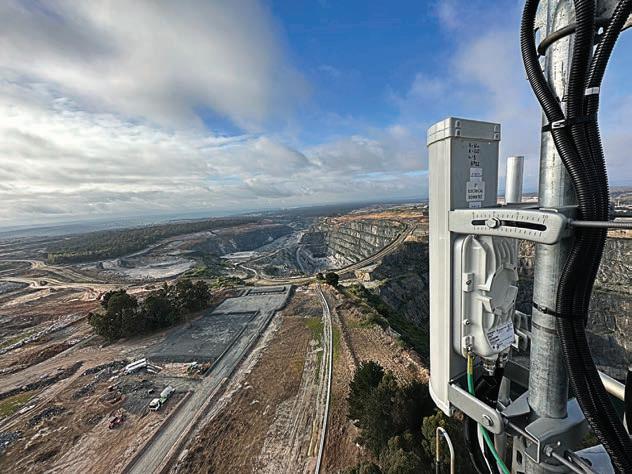


WORLD-CLASS FACILITIES IN CENTRAL QUEENSLAND ARE SUPPORTING THE FUTURE TRAINING NEEDS OF THE STATE’S RESOURCE SECTOR.
Mtraining, workforce and research needs of the Queensland resources sector.
Rockhampton’s School of Mining and Gladstone’s School of Manufacturing are each delivering world-class facilities to support the skills needs of future workforces in central Queensland that are directly and indirectly involved within the resources sector.
The Australian Government provided $30 million towards the cost of the CQUniversity Mining and Manufacturing project, which includes the two purpose-built facilities.
Federal Assistant Minister for Education Anthony Chisholm said the facilities represent a major coup for the people of central Queensland.
“The Albanese Government is committed to delivering high-quality education, regardless of where people might live,” Chisholm said.
“These amazing facilities enable CQUniversity to train students in emerging areas such as automation and drone operations, and provide tailored spaces for the delivery of upskilling and professional development.”
The facilities provide state ofthe-art equipment to support skills training, education and research to ensure a pipeline of highly skilled and qualified workers to meet skills
demands across the region and into the future.
CQUniversity vice-chancellor and president Professor Nick Klomp said the university was committed to the development of its regional campuses, and the facilities provide enormous future benefit to the local community.
“Mining directly and indirectly supports thousands of jobs in the region and, in the longer term, these facilities in Rockhampton and Gladstone will further support regional Queenslanders to undertake the training they need for the jobs of the future within the resources sector,” Klomp said.
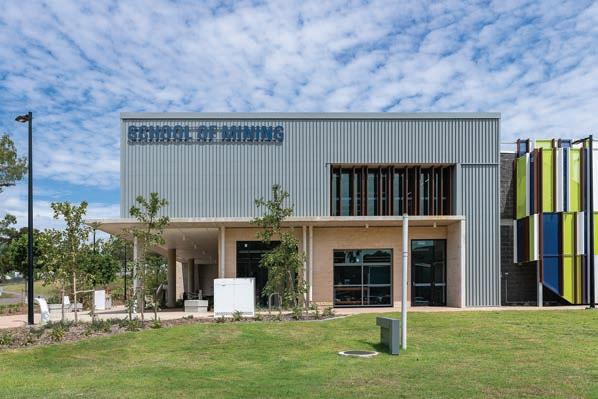
Klomp also explained how the development of the new facilities was a direct result of CQUniversity’s close engagement with community and industry.
“Through our work with industry and community, we developed a deep understanding of the region’s needs when it came to industry development, skills training and regional growth, and using this knowledge we worked with the Government to outline those needs and secure the required funding,” he said.
“These projects help to boost local economies and communities in the short-term while also supporting long-
term industry growth and regional development outcomes.”
Gladstone’s School of Manufacturing not only includes advanced training and research resources and equipment, but is also home to the Gladstone Hydrogen Hub, which supports the delivery of hydrogen training and research delivery.
The School of Mining and School of Manufacturing have sparked interested from industry players across Queensland, with collaborations developed to utilise the spaces and train the next generation of mining and manufacturing workers, including with resource and infrastructure training organisation MyneSite.
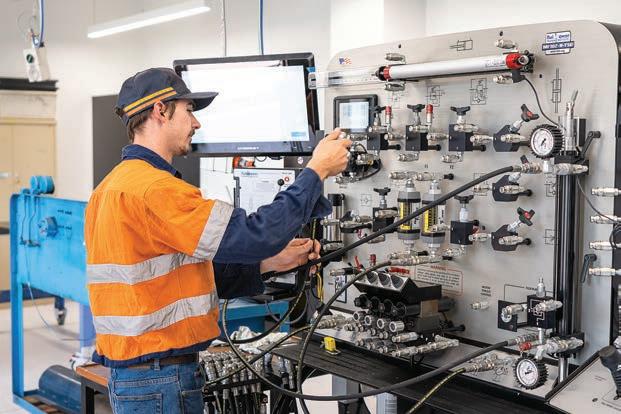
A resource and infrastructure training organisation, MyneSight provides teaching and assessment services to the open-cut and underground mining sectors.
The collaboration is designed to boost opportunities for students in the region by increasing the mining-related training available.
MyneSight general manager Larnie Mackay said collaborating with CQUniversity allowed the organisation to provide a seamless pathway for central Queensland residents to obtain quality surface and underground mining skills, from inexperienced entrants to future graduates to those wanting to maintain skills and those wanting to advance in their chosen field.

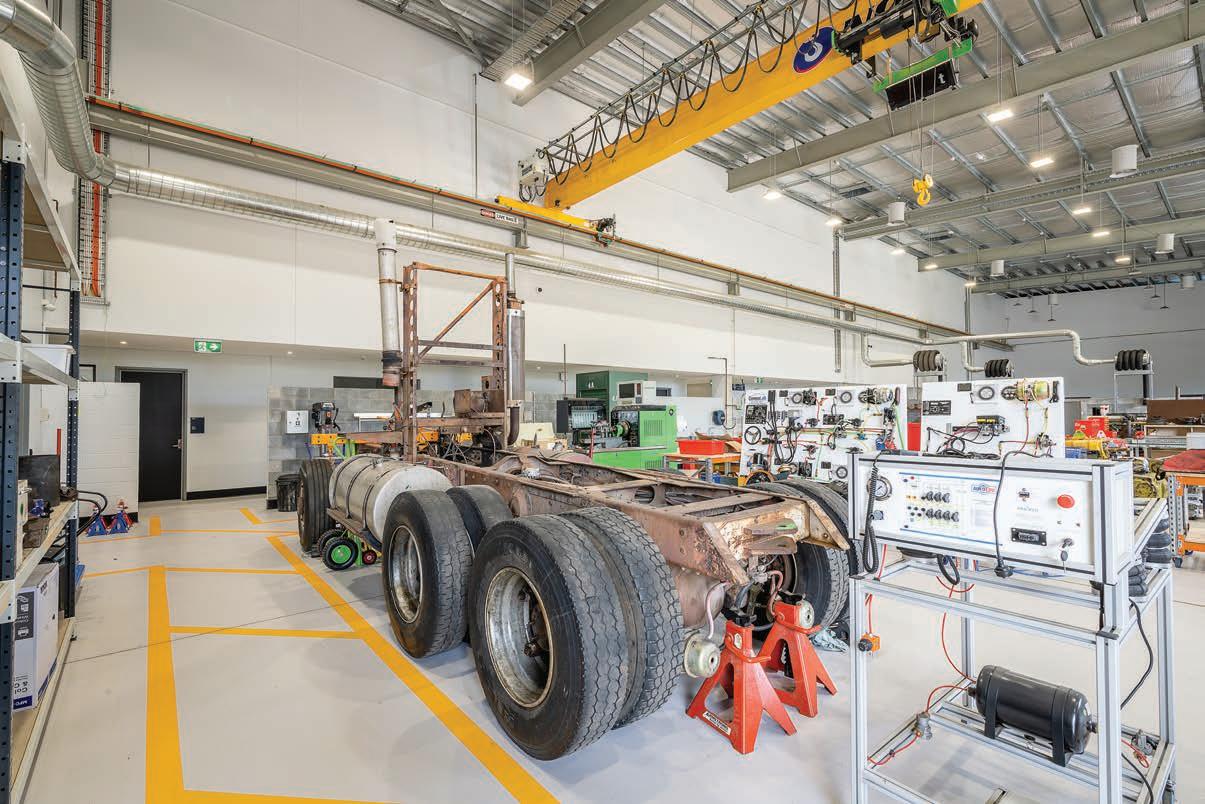
Hardox® 500 Tuf is the latest grade of Hardox® wear plate. It combines the hardness of Hardox® 500 with the toughness of Hardox® 450. The wear resistance of Hardox® 500 Tuf makes it possible to increase the load capacity by using a thinner plate and still have the same outstanding service life. Or stay with the same thickness and increase service life by 30% or more.
Hardox® 500 Tuf can also double as a structural steel. Its high yield strength and toughness allow for lighter mining bodies that are resistant to dents and can take impact loads with less supporting structures.
Get the full story of Hardox® 500 Tuf at www.hardox.com

LIGHTER MINING TRUCK BODY
HIGHER LOAD CAPACITY
EXTENDED SERVICE LIFE
LESS FUEL ON EMPTY RUNS
AS ORGANISATIONS ACROSS THE GLOBE BATTLE A BARRAGE OF CYBER-ATTACKS, VOCUS IS DETERMINED TO ENSURE ITS CUSTOMERS CAN WEATHER THE STORM WITH RESILIENCE.
Many wouldn’t associate mining with internet cybersecurity systems.
But they are as critical as the cybersecurity systems of any company in any industry.
A mine’s cybersecurity systems help guard against threats such as phishing, ransomware and data theft before they can cause harm to the business.
While a mine might not seem like a cyber attacker’s usual target, Vocus cyber specialist Stephen Mullaney says any company has the potential to become the focus of an attack.
“There are a lot of bad actors out there who deploy ransomware to disrupt other companies’ operations as their day-to-day business,” Mullaney told Australian Mining. “They don’t really care what industry it is as long as they can get in and put a company in a compromised position.”
Vocus state manager WA and national lead Simon Head said mines had traditionally implemented security to standard parameters, such as firewalls
that protect their systems from the outside world.
But criminals are getting much smarter about bypassing standard security barriers and cybersecurity systems need to be multilayered and resilient to yet-to-be-discovered forms of intrusion.
“Vocus runs highly secure networks and we have done so for decades,” Head told Australian Mining. “As the technologies evolve, and as organisations have looked to implement stronger, more robust security policies, we’ve evolved with the market.
“We have also established a number of partnerships with many of the leading security players in the market that complement what we already do from a network security perspective.”
Vocus has seen key mining players implement stronger solutions to help combat the threat of cyber-attacks to help ensure nothing can get to their employee data or safety measures.
“Some of the most forward-thinking miners have implemented things like network segmentation, which means that even if a bad actor were to break
into their internal network, they couldn’t go far,” Mullaney said.
“It also pays to separate your IT (information technology) and OT (operational technology) systems because if someone were to get into an IT system like HR or employee information, they can’t then jump to your OT system and mess with the autonomous vehicles or tailings dams monitoring systems. And vice-versa.”
Head said the challenges for miners lies in promoting cyber resiliency.
“Most organisations now understand that cybersecurity is necessary even if they haven’t previously experienced a cyber-attack on their systems,” he said.
“Vocus is helping these organisations stay resilient, stay online and ensure every part of their business is resilient to any form of attack.”
According to Vocus, cyber resiliency is the future of cyber-attack protection and should replace the traditional “throw money at it and hope it works” mindset.
“With a mine, so much of its information, monitoring and processes are there to ensure worker safety, so
mines are now starting to take cyber resiliency very seriously as a result,” Mullaney said.
“The cybersecurity landscape has changed dramatically over the last three to five years, so much so that it will be one of the first things a board will discuss when they meet.”
While cybersecurity may be the topic at board meetings, Head said all employees in a workplace have a responsibility to report anything suspicious going on.
“Vocus has an internal mantra of ‘see something, say something’, and we aim to help our customers’ organisations achieve a similar level of awareness when it comes to cybersecurity,” he said.
For Head, being part of a customer’s cybersecurity journey is something of which he and Vocus are especially proud.
“Vocus has decades of experience, and we want to share that with these companies,” Head said. “We’re happy to talk to any organisation in the industry, both now and in the future, about how we can help them build cybersecurity resilience, rather than being reactive to an attack when it happens.” AM


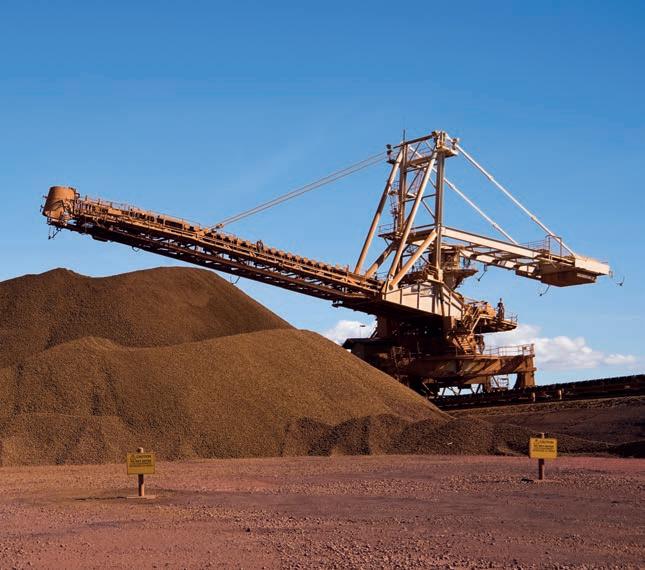

Stuck in the old way of doing things? Transform your system engineering and asset knowledge practices with DAD, a powerful software tool.
Discover how you can design and engineer systems at half

It’s about time.




NOW OPERATING UNDER NEW OWNERSHIP, THE PNG INDUSTRIAL AND MINING RESOURCES
EXHIBITION AND CONFERENCE IS SET TO TAKE THE PACIFIC NATION BY STORM IN JULY 2024.
Just 12 months after acquiring the PNG Industrial and Mining Exhibition and Conference, Prime Creative Media will showcase the redeveloped event in July 2024.
The premier event brings together Papua New Guinea’s industrial, mining and resources industries in one location, with over 100 displays of equipment and stands on show, while the conference will showcase experts from across the resources sector presenting on challenges and opportunities for the local industry.
“We are excited to bring our extensive knowledge and expertise to PNG Industrial and Mining Resources Exhibition and Conference,” Prime Creative Media chief executive officer John Murphy said.
“Our goal is to take the event to the next level through professional delivery and utilising our media communications channels and industry relationships to grow the conference and its attendance.”
The conference offers an opportunity to hear from experts in areas such as government, mining, energy and infrastructure presenting on topics like productivity, safety, sustainability, and innovation in technology and equipment.
Information sessions will focus on a variety of topics and feature
presentations followed by an engaging panel discussion with the audience.
PNG Mining, Prime Creative Media’s new magazine and the event’s official publication, also launched this year, focusing on the mining industry in Papua New Guinea and the surrounding region.
Murphy travelled to PNG in October to officially launch the publication.
“It was great to connect with industry leaders and officials to launch PNG Mining,” he said. “We had great feedback from these meetings and are looking forward to working closely together in the future.
“This publication will be a champion for the entire Papua New Guinea resources sector, so it was important that we meet with professionals and decisionmakers from across the local industry.”
With 2024 shaping up to be a bumper year for the Papua New Guinea resources industry, there is little doubt discussions at the event will be lively.
Some of the biggest news to come out of the Pacific region in 2023 was Newmont’s $26.2 billion acquisition of Newcrest, a process that has spanned the better part of a year.
As the ink dries on the agreement between the two gold giants, Lihir, one of PNG’s largest gold mines, will welcome 2024 with a new owner in
Newmont and the potential to up its output in the coming years.
Elsewhere in the region, Mayur Resources is steadily progressing construction on its Central lime project (CLP), which once complete will be Asia Pacific’s first carbon-neutral quicklime project for supply to Papua New Guinea, Australia and the South Pacific.
In what has been described as an unprecedented move, the Papua New Guinea Government awarded Mayur a 20-year mining lease for the CLP back in August 2020, reinforcing the
New mines are always cause for celebration in the industry, with the Porgera gold mine and the Frieda River copper-gold project both advancing towards a restart in the coming months.
The PNG Government is committed to restarting the Porgera mine as soon as possible, with recruitment ramping up to fully staff the mine and New Porgera Limited receiving a special mining license to clear the way for Barrick Gold to restart the mine.
For PanAust, the company that owns the Frieda River project, first ore is expected in 2035, with the company set to commence construction in 2024.
Papua New Guinea’s mining and resources sectors have seen a bumper year, and with the conference and exhibition to look forward to, 2024 looks to be even bigger. AM

AUSTRALIAN MINING CAUGHT UP WITH SEVERAL MAJOR PLAYERS AT IMARC 2023 TO CHAT ABOUT THEIR OFFERINGS AND TAKEAWAYS FROM THE CONFERENCE.
The 10th International Mining and Resources Conference (IMARC) was another extensive celebration of the latest innovations infusing the global resources industry.
Australian Mining was on the ground in the exhibition hall, speaking with several mining equipment, technology and services (METS) companies about their latest offerings and where the sector is going next.
Here are some key takeaways.
ABB
As vice-president and mining business line manager of multinational technology pioneer ABB, Max Luedtke is a major proponent of the resource industry’s automated and electrified future.
One question posed of Luedtke at IMARC 2023 was how the mining industry can speed up decarbonisation.
The key, he said, is collaboration.
“Not one company can do everything,” Luedtke told Australian Mining. “So collaboration is critical, where you have to get different companies with their key competencies together, because in the end we have the same goal. Looking at the number of mining companies in Australia, they have a big role to play here. But I can say that (collaboration) has changed now in the last year quite dramatically in a positive way.”
ABB and diversified mining services company Perenti have joined forces to explore solutions that help mining customers decarbonise their operations.
In June, the collaboration was awarded its first contract by IGO, which will provide an allelectric study for the underground electrification of the Cosmos nickel mine in Western Australia.
Experts from ABB, Perenti and IGO will work together to design Cosmos’ electrification, including production and operating philosophy, fleet selection, and power distribution and electrical infrastructure design.
Epiroc
Attending his first IMARC, Epiroc global director – autonomous haulage
systems (AHS) Alex Grant was impressed with the size of the show and the foot traffic that came through Epiroc’s stand.
Grant came with the success of Epiroc’s ongoing AHS project with Roy Hill under his belt – a case study he is now taking to the world.
“My role now is to try to replicate what we did in Australia to the other customers centres around the world,” Grant told Australian Mining.
“So we’re really starting to focus on Chile, Brazil, Peru, the US, Canada and of course Australia to get those customer centres up to the right level to sell and promote AHS now.”
Epiroc has partnered with ASI Mining on the Roy Hill AHS project, with the two combining their expertise to convert Roy Hill’s mixed fleet of 96 haul trucks to driverless operation.
Brokk
With several machines either purchased or operating in Australian mines, the local sector is beginning to understand the perks of the Brokk demolition robot.
This “Swedish army knife” of a machine can solve all manner of operational problems in underground mines, with its compact frame able to easily manoeuvre narrow spaces.
Once in those spaces, the robot goes to work, capable of drilling, cutting, shotcreting, splitting and hammering oversize rocks, among other tasks.
Brokk Australia sales manager Stefan Mace said the company had many fruitful discussions at IMARC 2023.
“A lot of people are very curious about what we’ve got here, and that was the whole reason for bringing these machines: ‘This is something that’s available in the market’,” Mace told Australian Mining Mace said one discussion regarding the Brokk demolition robot concerned the machine’s suitability in underground stopes.
“(People interested in the demolition robot) are coming to us with an issue in their stopes and saying, ‘You’ve got a compact machine that can go into the stope and break down oversized boulders’, instead of them having to tie up production vehicles like jumbos to worry about this,” he said.

Armed with a couple of solutions that get to the heart of maintenance and safety issues in the Australian mining industry, Decoda was able to clearly convey its purpose at IMARC 2023.
“What’s been good from a feedback perspective … is customers saying, ‘You’ve articulated the problem we’re experiencing clearly and you’ve developed a solution within the mining environment for it’,” Decoda business development manager Aaron Watson told Australian Mining Decoda was showcasing its RockAware and BundAware products at the conference, the former of which prevents tyre failures through the smarts of an artificial intelligence (AI) detection system.
Mounted onto haul trucks, RockAware continually scans for obstacles that can cause damage to tyres, alerting the driver in the process.
When visiting Decoda’s booth, a tyre specialist from a major mining
company explained how RockAware would solve rock cuts – a problem that keeps them up at night.
For Hexagon Asia Pacific vice president Simon Stone, IMARC 2023 was a place for customers and the wider mining ecosystem to come together and share experiences.
“The community that we’re all constituent parts of, we come together and share war stories and the perspective and collaborate on ideas,” Stone told Australian Mining
“To me, this is the premium event for getting this community to reconnect in one place … where we can have some pretty creative conversations in a very short period of time.”
Stone highlighted that IMARC offers not only an opportunity for Australian-focused mining professionals to converse but also for discussions to be had with international delegates.
“There’s a Mongolian delegation (at IMARC) and I’m very interested in continuing to expand what we’re doing in Mongolia,” he said. “It’s another dimension of IMARC that can be overlooked; the ability to connect with other parts of the world and the business facilitation groups the respective governments spin up to try and decrease the friction of doing business.”
Hexagon – a multinational technology company pioneering the mining sector’s automated future – recently launched a Mongolian office to support its growing footprint in the country.
A conference such as IMARC enables Hexagon to strengthen relationships with Mongolia, which could generate new business opportunities into the future.
MASPRO’s mining offerings are built on design expertise and customer collaboration, and IMARC 2023 served as a platform to communicate this ethos.
The company gets to the heart of equipment failures with its range of parts and engineering solutions, something MASPRO managing director Greg Kennard said has saved one major miner significant downtime.
“We were dealing with a customer that was having problems with heads failing after 200 hours,” Kennard told Australian Mining. “They should be about getting to a service interval of 6000 hours.”
After understanding why the heads were breaking down so quickly, MASPRO’s engineers went to work.
“We redesigned the head, made a number of changes and managed to come up with a solution probably within a couple of weeks, and get it back out to them,” Kennard said. “We may still have a head running there right now – we just had information come through that it’s done 12,000 hours.”
SafeGauge
Australian Mining attended the official launch of SafeGuage’s MultiTool Pro, with company founder and director Luke Dawson unfurling the new solution on the first day of IMARC 2023.
The MultiTool Pro enables technicians to connect to 12 SafeTest gauges simultaneously from up to 100m away.
“The difference with the MultiTool Pro compared to our old product and industry standard is it can remove technicians from the dangerous situations they are placed in when maintaining plant, whether they are conducting hydraulic testing, speed checks or wear checks,” Dawson told Australian Mining. “They can now complete tasks wirelessly from a safe distance, and with the new product they can actually data log, report and integrate it with their systems.”
Data logging and reporting is made possible by the MultiTool Pro’s ‘plug-and-play’ touchscreen interface, with comprehensive reports able to be exported and shared via in-built cloud connectivity.
Total Rockbreaking Solutions (TRS) builds custom boom systems for its mining customers, something company sales manager and director Jeff Jackson had on full display at IMARC 2023.
As he was speaking with Australian Mining, Jackson sat down at his computer and began operating a boom system located at TRS’ facility in Kewdale, WA. This was automation in full flight.
“This boom is extremely heavy-duty for mining – it will last a long time,” Jackson said.
“Some of the other booms in the market are a bit lighter duty. They’re built to a price, we build to spec.
“The other thing we’ve got is BoomSafe automation that actually works. So there’s two things that we think we’re way out in front.”
Backed by the renowned BoomSafe control and automation system, TRS boom systems incorporate collision avoidance and have multi-user remote capability.
This is supported by a dedicated TRS site service team, which can repair TRS and competitor booms. The company is also known for its attachments, which can serve many different purposes across

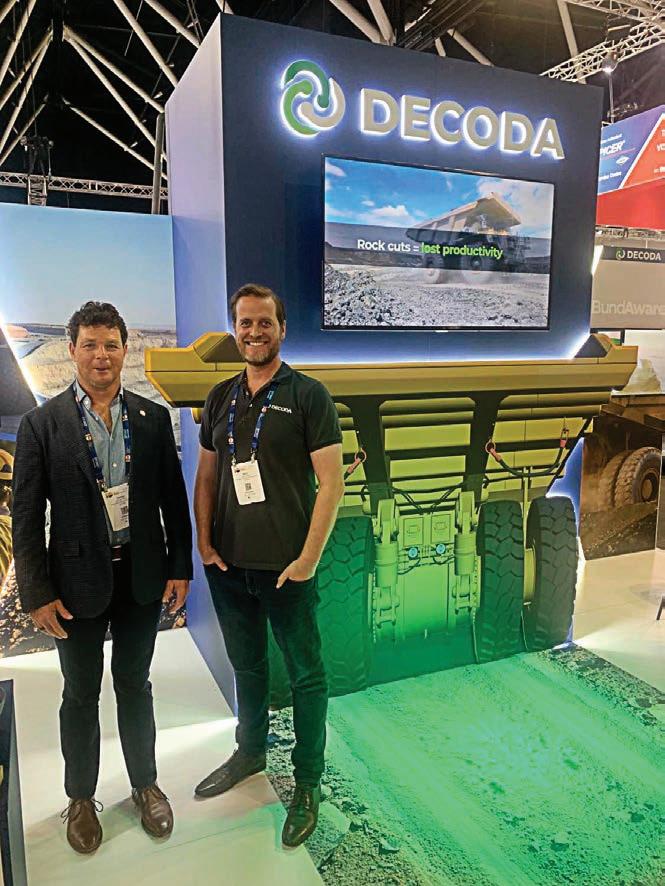

A TOTAL OF 12 AWARDS WERE UP FOR GRABS ON THE NIGHT.
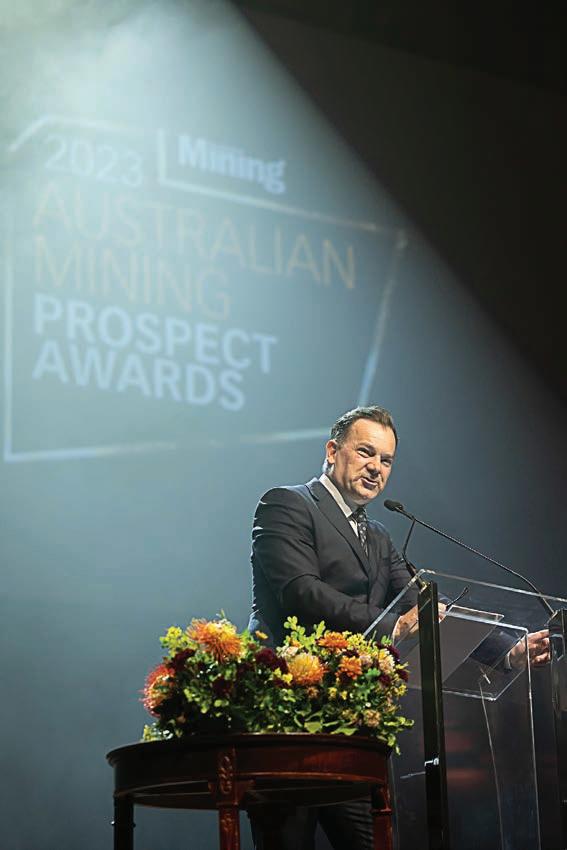
THE AUSTRALIAN MINING PROSPECT AWARDS RETURNED TO BRISBANE THIS YEAR TO CELEBRATE THE BEST AND BRIGHTEST
From safety to surface mining, technology to performance, the 2023 Australian Mining Prospect Awards had it all.
Returning to Brisbane to cap off a bumper year for the sector, the awards night continued its status as the only national program to stop, take a look at what the mining industry is doing, and reward those who are going above and beyond.
The future continues to look bright for the local industry, as the sector sits at the forefront of the world’s transition to net-zero. As Australia’s Federal Minister for Resources Madeleine King explained this year, “the world’s path to reaching net-zero runs through the resources sector”.

THE 2023 AUSTRALIAN MINING PROSPECT AWARDS WERE HELD IN BRISBANE ON NOVEMBER 9.
And with its extensive reserves of critical minerals, that means Australian mining is set to benefit.
AUSTRALIAN COMEDIAN LEHMO WAS THE MC AT THE AWARDS.
“The resources sector will provide for our future energy security, and it’s clear that reaching net-zero will require more mining, not less,” she said.
The sector is already reaping the rewards of the various new and updated mines that have sprung up across the country over the last year, and there’s more in the pipeline.
With that in mind, there was a lot to celebrate at the 2023 Prospect Awards,
which were held at the Brisbane City Hall on November 9.
Altogether, the 12 awards celebrated a wide range of achievements across the industry, including safety, environmental, discoveries indigenous engagement, and a lot more.
Keep reading to discover the winners of the 2023 Australian Mining Prospect Awards. AM





With Vocus Satellite – Starlink, it’s never been easier for your workers to stay connected with family and friends, access services such as entertainment, telehealth, or education, and maintain a happy and healthy lifestyle while living on-site. It’s the secure, high-performance and reliable connectivity that’s enabling brilliant possibilities for Australia’ resources industry.

A YEAR OF HIGHS, ROY HILL HAS A CLEAR PLAN FOR THE FUTURE.

Celebrating a site that has not only reached production goals but has also taken steps to implement outstanding safety controls and environmental and sustainability programs, the Australian Mine of the Year Award was taken home by a major player.
Roy Hill, a Hancock Prospecting subsidiary and a jewel of the Western Australia mining scene, was awarded the top prize this year for its plans to become the world’s largest autonomous mine.
Located 1200km north of Perth in the Pilbara, Roy Hill is one of Australia’s largest iron ore mines, employing more than 3000 people across its operations.
The company’s autonomous haulage system saw it also take out the Innovative Mining Solution category at this year’s Prospect Awards, bestowed for Roy Hill’s initiative in setting out to achieve its mission for a fully driverless fleet.
Roy Hill had always planned for an eventual transition to autonomous haulage, and while original equipment manufacturer (OEM) solutions were investigated, they were not suitable to the mine’s operational requirements.
The company’s leaders could see they were not alone in finding the some of these solutions inflexible and expensive.
The sector was clearly ready for a system that offered mines the opportunity to introduce cost-effective automation to a mixed fleet, even those with a comparatively short operational mine life of 5–8 years.
Roy Hill’s leaders made the decision to pursue development of a tailored, agnostic system that could be applied to the mine’s mixed haul truck fleet with built-in flexibility to extend to other heavy vehicles like water carts or dozers in the future.
In addition to meeting Roy Hill’s needs, the fact such a system would have potential for commercialisation made
autonomy an affordable option for other mining operations.
In conjunction with Epiroc, Roy Hill is working to replace all 96 haul trucks with a fully driverless fleet.
While undertaking the massive overhaul, Roy Hill still managed record iron ore shipments of 63.3 million tonnes in 2023.
The mine turned a $2.7 billion profit in the 2022–23 financial year and made moves to innovate its operations with an outlook for the future of mining.
Roy Hill executive chairman Gina Rinehart congratulated the company’s executives and thanked all staff members for their efforts over the past year.
“The continuing outstanding performance of Roy Hill is testament to our exceptional people and the way we operate,” she said.
“The dedication, hard work and loyalty from each and every one of our staff is what drives our success.”
Roy Hill has a history of success through innovation.
The company recently partnered with Wabtec to deliver the world’s first 100 per cent battery-powered locomotive in the US. The FLXdrive battery has a pink design to symbolise Roy Hill’s commitment to assisting in breast cancer research and those suffering from the illness.
A recently commissioned wet high-intensity magnetic separator (WHIMS) plant for Roy Hill was an Australian first in size and scale, and supported a production growth of five million tonnes per annum without any increase to total material mined, but rather through tailings waste reduction and improved iron ore capture.
Roy Hill is also reprocessing material already sent to tailings through the WHIMS plant – a win for the business and environment.
With successes across the board in production, sustainability, safety and innovation, Roy Hill is setting itself up for an even bigger year in 2024. AM



The Indigenous and Community Engagement Award is proudly sponsored by



BHP’S BANJIMA LAND REHABILITATION PARTNERSHIP AIMS TO INVEST IN THE COMMUNITY AND EMPOWER BANJIMA PEOPLE INTO THE FUTURE.
Recognising a collaboration between an Australian miner and an Aboriginal-owned business or community organisation, the Indigenous Community Engagement category at this year’s Prospect Awards went to BHP’s Banjima land rehabilitation partnership with the Banjima people in WA.
The partnership is an “informal but highly valued” collaboration between Banjima Traditional Owner members, organisations and businesses in land conservation and the re-vegetation of native plants on BHP mining areas located on Banjima traditional lands in the Pilbara.
In partnership with the Banjima Native Title Aboriginal Corporation, the partnership has seen 15 trainee positions for Banjima people created in the site rehabilitation team at BHP’s Yandi mine in the Pilbara.
“The importance of land to Aboriginal people is central to our culture and our connection to country,” site superintendent Michelle Adams said. “So the ability to engage Traditional Owners in activities that actually go around healing Country is really important.”
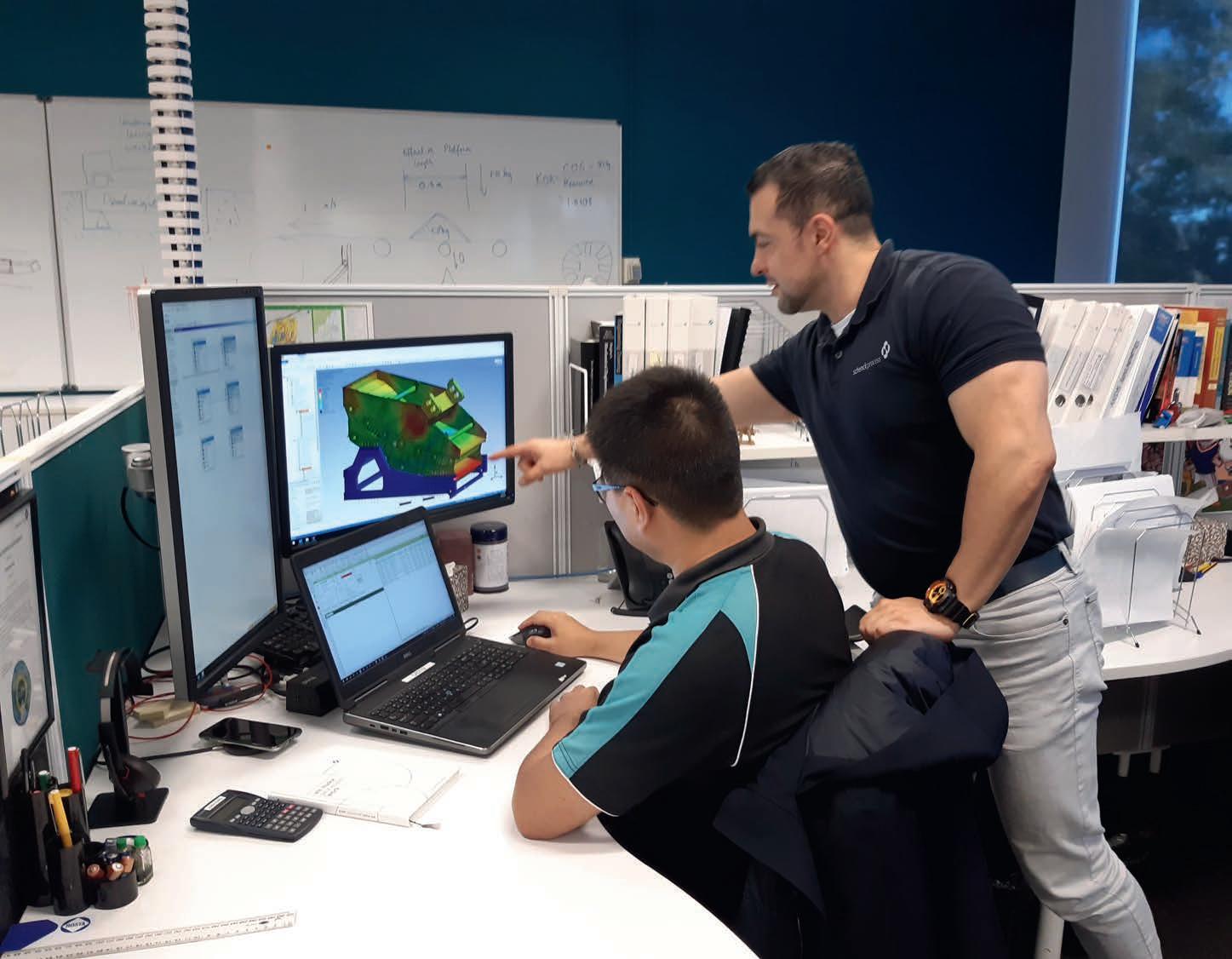

The nursery also gives Banjima Traditional Owners the opportunity to discuss how culturally important species, such as red river gums, coolibahs and melaleucas, can be incorporated into rehabilitated landscapes.
BHP has also invested more than $10 million in local indigenous businesses in order to increase opportunities for the area.
The initiative includes the development of a small-scale tree nursery on the mine site. This helps to provide a practical education component for trainees, as well as access to essential tube stock for land rehabilitation and re-vegetation.
Planting tube stock bypasses the most vulnerable life stages: pregermination, germination and initial establishment. Furthermore, tube stock planting is particularly important for the establishment of native woody plant species that are the cornerstone of ecological restoration projects.
BHP said the collaboration values the identification and consideration of Aboriginal and natural heritage in the planning and execution of mine rehabilitation activities, and is a mutually beneficial arrangement built on trust and the desire to develop a relationship with the indigenous community.
“Many Banjima people live regionally in Pilbara communities and have barriers that may limit engagement in mining through usual recruitment processes,” BHP said. “The collaboration seeks to address these barriers, grow the regional labour pool, build regional business capacity and increase indigenous representation in mining and land management activities.”
The program offers a paid 12–18-month traineeship with fly-
in, fly-out (FIFO) arrangements at the Yandi mine.
Using a workready model, the program takes a case management approach to identify and support barriers to employment.
The trainee program includes TAFE, practical application of skills, equipment use, and exposure to mining and its employment options.

The objective is to affect positive social and economic outcomes for Banjima individuals and the wider Banjima community, while also achieving BHP’s mine rehabilitation objectives.
Agreed measures of success relate to the uptake of Banjima people into the trainee roles, their completion of training components and ultimately their transition to employment.
Initially starting with six trainees in December 2021, the program has since engaged 15 Banjima trainees, with another six commencing in October 2023.
Four members of the initial cohort have completed their Certificate II in Conservation and Ecosystems Management, with three having already transitioned to other employment. AM
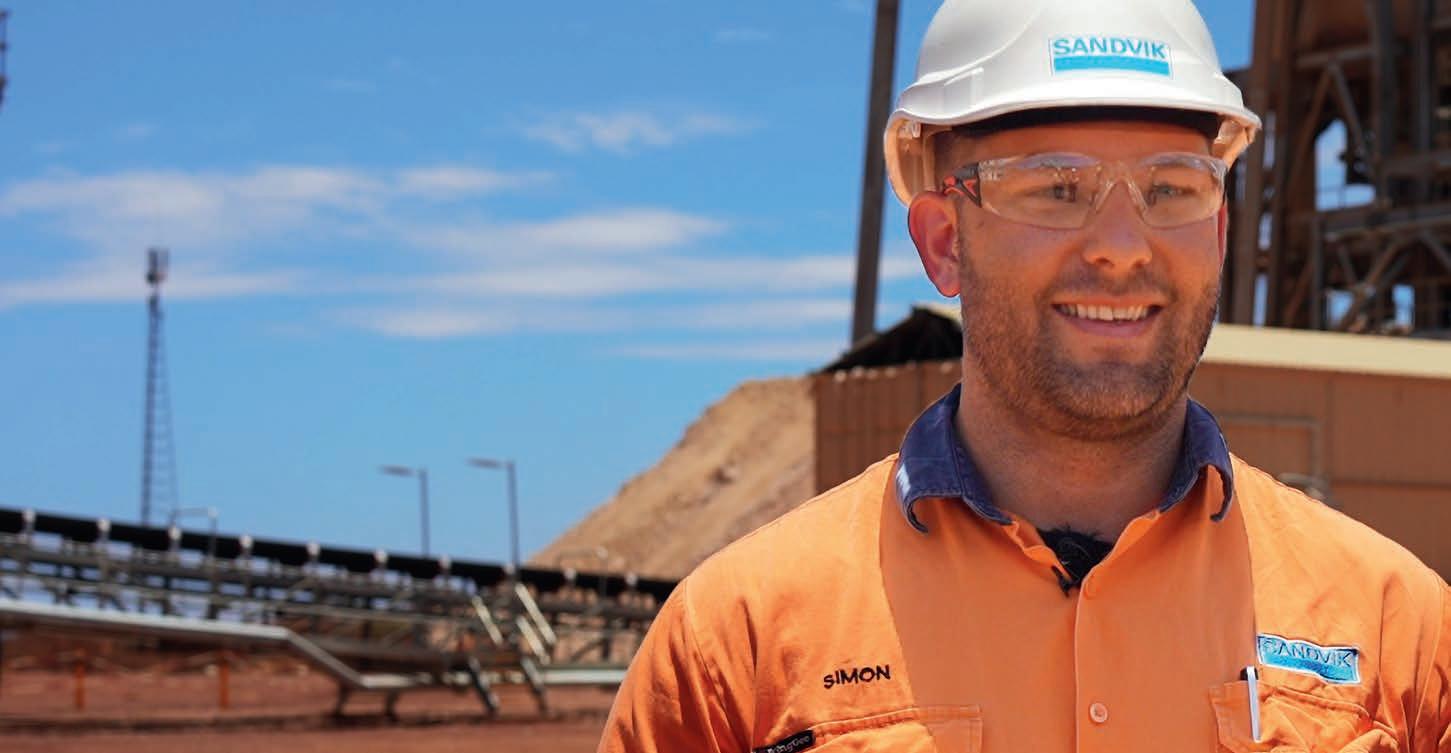

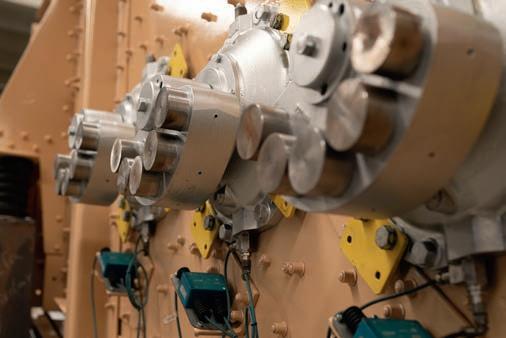
Schenck Process Mining has become part of Sandvik Rock Processing Solutions.
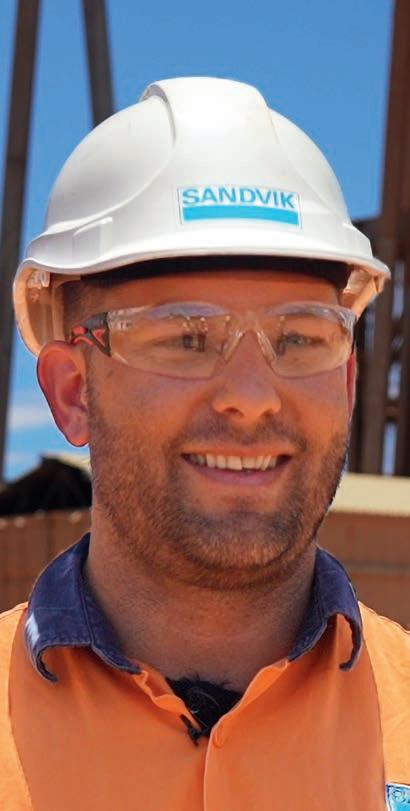


Excellence in IIoT Application Award is proudly sponsored by
RIIoT Application Award commends technology that enhances mining and mineral processing operations.
Hexagon took home the top spot at this year’s Prospect Awards with its HxGN MineProtect Operator Alertness System (OAS), which keeps heavy and light vehicle operators alert and attentive throughout long working hours.
Hexagon’s OAS also won the Mine Project Success of the Year Award this year for its implementation on MMG’s Rosebery base metals mine in Tasmania.
The OAS operates by using artificial intelligence (AI) to provide real-time alerts and notifications to drivers and supervisors, empowering them to act to keep sites safe from the hazards of fatigue.
The solution employs state-of-theart sensor technology and advanced algorithms to continuously monitor operators’ alertness levels in real-time.
Unlike other systems that operate using manual or subjective assessments, Hexagon’s OAS utilises objective data to accurately detect signs of fatigue and distraction.
This data-driven approach helps to ensure the delivery of reliable and timely notifications to operators, enabling proactive responses to potential safety risks.
One of the key differentiators of HxGN MineProtect OAS is its adaptability to the complex underground mining environment.
While other solutions may find connectivity challenging when underground, the OAS is designed to operate seamlessly in surface and underground conditions.
It is this adaptability that ensures around-the-clock safety coverage.
The OAS also offers substantial improvements across crucial operational dimensions.
The first is safety enhancement.
Unlike traditional methods that rely on post-incident analysis, the OAS’ real-time alerts allow operators to take immediate corrective actions when their alertness levels drop. By preventing accidents and incidents caused by operator fatigue or distraction, the
CUTTING-
TECHNOLOGY,
OPERATIONAL IMPACT, OAS … SETS A NEW STANDARD FOR OPERATOR ALERTNESS SYSTEMS IN THE MINING INDUSTRY.”
solution significantly elevates overall safety levels.
The second dimension is efficiency and productivity.
The ability to detect fatigue early on and prompt immediate intervention helps to prevent accidents and associated


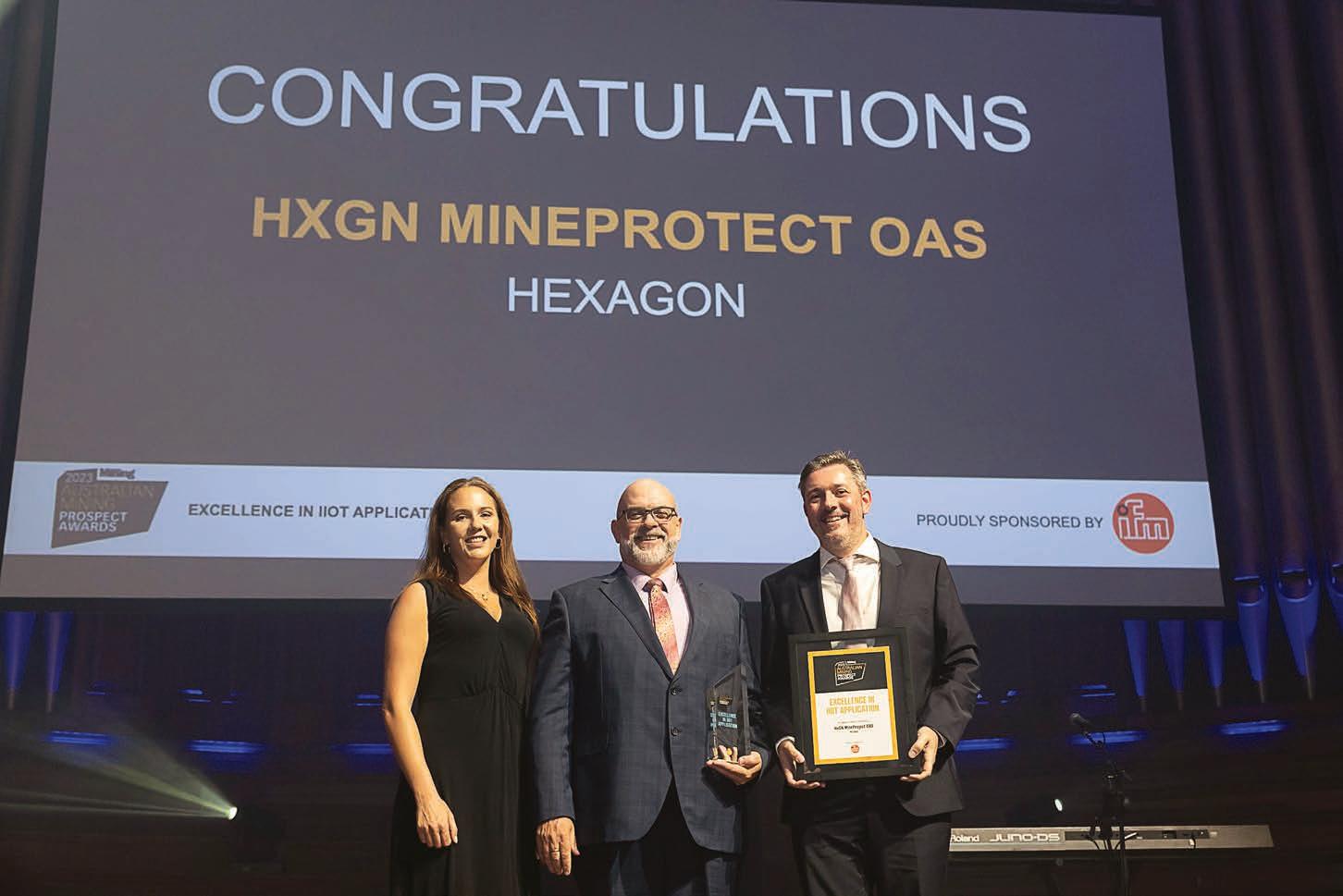
disruptions to mining operations. This translates into higher operational efficiency, reduced downtime, and optimised resource utilisation.
The third aspect is that the OAS offers competitive cost savings.
Accidents due to operator fatigue can result in substantial financial losses, legal liabilities, increased insurance premiums and regulatory fines, not to mention reputational consequences.
The OAS helps to mitigate these risks, resulting in significant savings over time. Its proactive approach prevents costly incidents before they occur, aligning with the mining industry’s imperative to optimise resources.
“While there might be alternatives in the market that focus on safety, HxGN MineProtect OAS surpasses them with its ability to address alertness and safety
holistically,” Hexagon said. “Many existing solutions may lack the realtime monitoring capability or may not be tailored for underground operations, limiting their efficacy.
“By combining cutting-edge technology, adaptability and operational impact, OAS outperforms other options and sets a new standard for operator alertness systems in the mining industry.”
HxGN MineProtect OAS’ technological adaptability to challenging environments and its substantial impact on safety, efficiency, productivity and cost-savings position it as a standout solution within the market.
The system has already been deployed on 11 underground mining trucks at MMG’s Rosebery mine with great success. AM




Unlock valuable data from your mining operation
IO-Link is an easy and effective way to start collecting data from your assets and improve your business decision-making.
The ifm moneo platform goes beyond monitoring and detection, it gives you full visibility over your assets. How do you benefit from IO-Link?
Allows devices to send and receive significantly more data
Receive digital measured values and process data from the sensor without any conversion losses
Parameter setting and monitoring via software
Reading and logging of event and diagnostic data
Visit our brand-new website to discover how to enhance your business operations TODAY!
You can also register for a FREE 30 day trial of moneo!
MONEOSOLUTIONS.COM.AU
Knowing the condition of your machinery gives you peace of mind. It also allows you to perform maintenance at optimal times.
The Australian Mine of the Year Award is proudly sponsored by



MAVEN GREENTECH’S AIRX AIR FILTRATION INITIATIVE IS HELPING MINE SITES REACH THEIR SUSTAINABILITY GOALS.
At a time when netzero is at the forefront of discussions on the future of the mining industry, the Excellence in Environmental Management and Sustainability Award recognises a mine, company or project that has excelled in environmental-mindedness.
The award celebrates an innovative sustainable or environmentally-focused program that has been developed or carried out to protect, preserve and rehabilitate the natural environment, and contributes to decarbonisation as well as waste and emission reduction.
Maven Greentech’s AirX Initiative took out the category at this year’s Prospect Awards.
Capable of removing 99 per cent of dust from large diesel engine filters, the AirX Robot system allows the filters to be used up to 15 times over, extending their life 6–8 times longer than they would have originally lasted.
The system shortens downtime and saves millions of tonnes of metal from landfill, making it an invaluable tool in the push to reach net-zero across the mining industry.
First deployed at Glencore’s Hail Creek coal mine in Queensland, AirX has already been able to extend engine maintenance by 250 hours, saving Hail Creek well more than $1.5 million in costs related to downtime, maintenance and equipment.
AirX operates using PLC-controlled conveyor feed and cleaning, integrity-


regional centres. This process often involves thousands of kilometres of transport, thereby increasing the carbon footprint of all stakeholders.
The objective for Glencore’s Hail Creek site was the creation of an efficient air filter cleaning unit that operated on-site and cleaned filters to original equipment manufacturer (OEM) specifications – or better.
Minimising any potential dust generation during the cleaning process was a key objective, and this was achieved through design, efficient chamber sealing, and filter entry into the cleaning chamber being kept as low as possible.
Beyond ensuring top-quality filters, AirX conducts diagnostic checks before and after cleaning, enhancing equipment maintenance strategies.
Moreover, the system’s chemical-free dry-cleaning method not only saves time and money but also protects staff from silica exposure, reduces landfill waste, and shrinks the carbon footprint of a site through optimal reuse of resources.
Built from top-tier readily accessible components manufactured by companies such as ABB-Festo-Tsubaki and Bonfiglioli, the AirX system delivers durability, reliability and seamless maintenance.
The Maven Greentech AirX robot project has established its position as the sole globally deployable workshop-ready robot-driven air filter cleaning system. AM
We’re developing tomorrow’s solutions today, creating a new generation of products that enable optimal efficiency and sustainability.
This is why we’re proud to be sponsor of the Excellence in Environmental Management and Sustainability Award, at the 2023 Australian Mining Prospect Awards. Congratulations
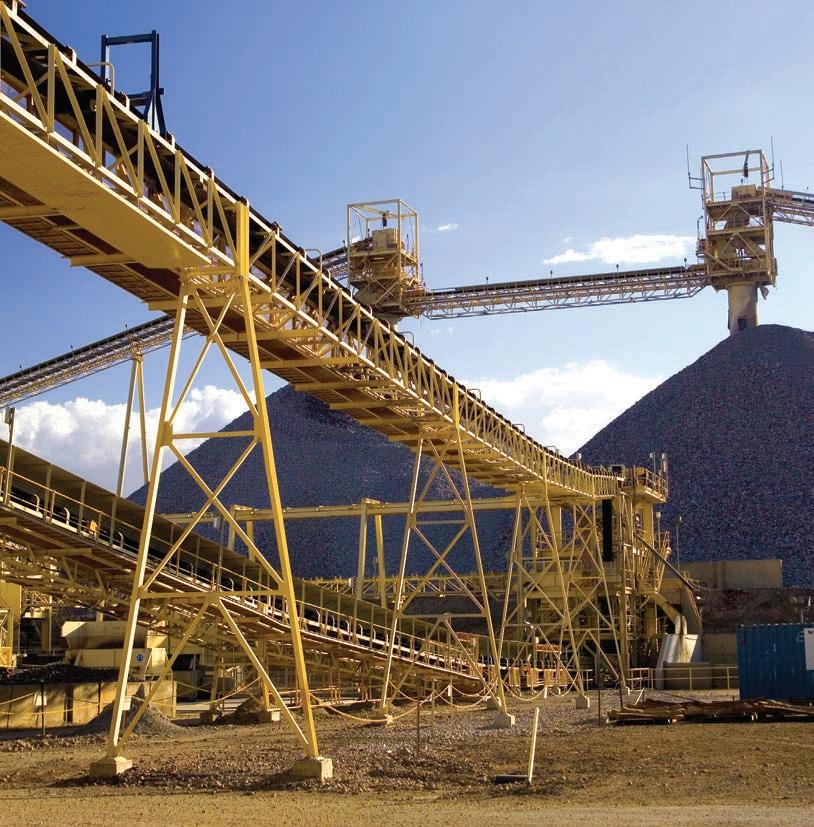
https://www.bonfiglioli.com/australia/en

The Excellence in Mining Safety Award is proudly sponsored by
ENGENTUS’ TOPTORQUE PRECISION REACTIONLESS BOLTING SYSTEM IS MAKING WORKPLACES SAFER AND MORE EFFICIENT.


Whas developed or carried out a program that increased safety, removed risk, or cut worker issues on a project or mine.
The 2023 Excellence in Mine Safety, OH&S category of the Prospect Awards was taken home by Engentus for its TopTorque precision reactionless bolting system.
Developed in Western Australia, the system is designed to eliminate some of the biggest hazards from tightening industrial bolted joints with powered torque wrenches.
TOPTORQUE SYSTEM USES DIGITAL CALIBRATION FOR PRECISION BOLTING. ENGENTUS IS COMMITTED TO DEVELOPING BOLTING SOLUTIONS FOR THE MINING INDUSTRY.
Engentus’ solution keeps workers safe by using the same power tools to drive a second integrated socket fitting, which directly engages to the end of a custom bolt or stud. The system is digitally controlled for greater precision, adding an extra layer of safety.
Enabling the precise torquetightening of friction-controlled bolting assemblies through reaction-tip bolts and counter-rotating drivers, the system removes the need for a reaction arm.

Reaction arms and their potential hand-crush and tool kickback hazards are associated with hand-pinching or even crushing, potentially causing catastrophic injuries.
The ability to apply a digitallycontrolled calibrated torque to the fastener is a world away from the loud, vibrating, uncontrolled impact wrenches on which the industries traditionally relies.
applications, particularly in the iron ore industry with high rates of wear and tear and where time-critical on-site maintenance is essential.
While collaborating with a mining partner on the wider adoption of its Australian-developed Segnut lateral release nut, Engentus saw the need for a solution to the current bolting practices in the mining industry.
The company realised there was a lack of fastening systems that eliminated all critical safety hazards associated with installation and removal of industrialgrade bolted joints.
These are nuts and bolts that cannot be tightened by hand, instead requiring a power tool – often pneumatic, hydraulic, electric or, more recently, battery-powered.
In addition to hand crushing, pinch points, recoil and kickback, critical hazards can include hand–arm vibration syndrome, noiseinduced hearing loss, and uncertain final bolt tensions.
recorded for quality control.
“Customer demand and feedback on the TopTorque system has been very positive and encouraging,” Engentus said.
“Since entering in the first half of 2023, there are approximately 10 TopTorque systems currently operating in the market, with this number expected to grow with existing customers and new customers.”
Engentus has recently engaged with several companies with significant expertise in the grinding mill liner industry. The need to reduce mill liner bolt failures and increase safety for mill-reline operators is high on the industry agenda. The company said it has also been approached by multiple stakeholders to develop a system for mining haul truck wheel studs, increasing safety for tyre fitters.
The Engentus engineering team is currently working on TopTorque solutions for both applications, with big plans for the future of safety in Australian mining. AM
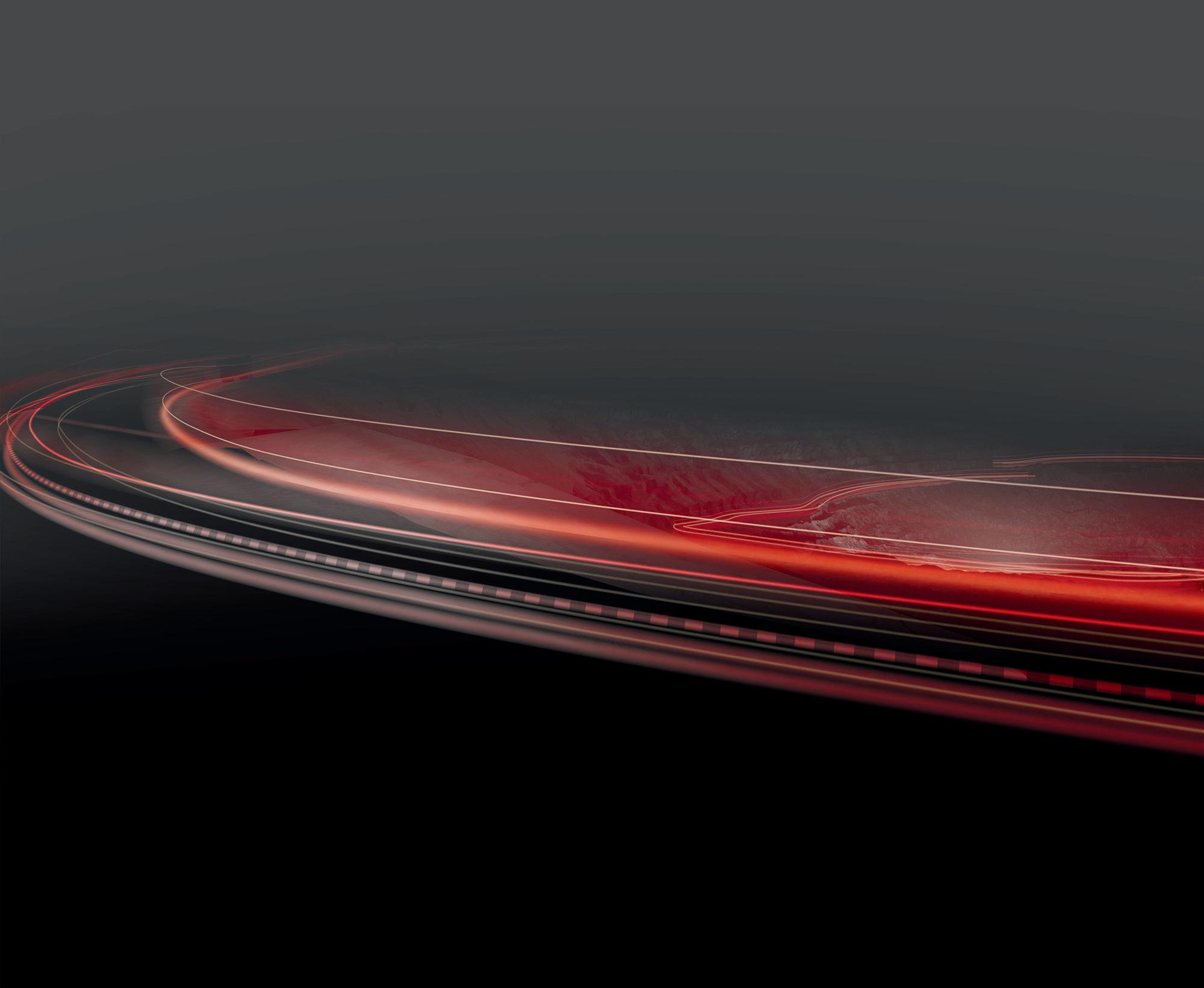






Awarded to an individual who has led a project or mine site to a successful outcome, the Project Lead of the Year category at this year’s Prospect awards celebrated Craig Hagan, Yancoal head of training and safety culture.
Also taking home the Safety Advocate Award, Hagan’s most recent project saw him implement a culture and change strategy that has reduced total injuries at Yancoal by 60 per cent and lost time due to injuries by 50 per cent over the past three years.
This year alone saw Hagan’s project
This type of feat is not to be underestimated, as Hagan’s efforts have drastically improved safety standards for the company’s 4500 employees.
Hagan has helped to implement a new health and safety learning management system for the company, while also developing a strategy for the implementation of artificial intelligence (AI) and thermal imaging technology.
Along with implementing these systems, Hagan has designed a new training management system to enhance competency management, worker training records and assessment events.
As a professional with over 30 years of industry experience, Hagan has
believing in safety culture as a way of life and not just a policy.
He has successfully implemented safety systems in construction, transport, resource processing and mining, taking the time to listen to each workforce and tailor the system to individual needs. This is especially true for the mining sector.
“(Since 2020), we have experienced a significant reduction in workplace injuries and an increase in hazard identification and reporting,” Hagan said.
During his time with Yancoal Australia, Hagan has been instrumental in helping the company continue to
These efforts have been highlighted by Yancoal’s total recordable injury frequency continuing to decline following workforce training in 2022, with a 66 per cent decrease for 2023.
Commenting on the nominations and being selected as a finalist, Hagan said he was grateful to be thought of for the award.
“I am thrilled … that I have been nominated for the year’s Prospect Awards,” Hagan said. “It is an honour to be recognised.
“I am grateful for the privilege of receiving this nomination and cannot wait for the awards ceremony. Thank




The Safety Advocate Award is proudly sponsored by

YANCOAL AUSTRALIA’S CRAIG HAGAN HAS BEEN RECOGNISED AS THIS YEAR’S SAFETY ADVOCATE AT THE AUSTRALIAN MINING PROSPECT AWARDS.


Ahas also been recognised as the Safety Advocate of the Year at this year’s Australian Mining Prospect Awards.
Recognising an individual who is committed to ensuring the safety of a mine, the Safety Advocate Award celebrates those who champion safety either for an individual site or company, or for the mining industry as a whole.
As head of training and safety culture at Yancoal Australia, Hagan took out the category for his compelling 30-year history developing, coordinating and implementing continuous safety systems across the industry.
“Craig has been working in high-risk industries for over 30 years, and he’s seen first-hand how critical it is to slow down and focus on what matters,” Yancoal Australia said.
“That’s why Craig believes in safety culture as a way of life, not just a policy or process. The fact that he’s managed
when you take the time to listen to your workforce and consider their needs as an integral part of your business model, you can achieve amazing things together.”
In his most recent project, Hagan developed and implemented a culture change strategy called the Safe Way Every Day program. The program has reduced Yancoal’s total injuries by 60 per cent and lost time injuries by 50 per cent over the past three years.
Currently leading the company’s training and safety culture function, Hagan has designed and implemented a range of initiatives that have had a direct and positive impact on the health and safety of the company’s employees.
In terms of training, Hagan has introduced new management system enhance competency management, worker training records, planning tools and analytic dashboards for planning, budgeting and scheduling training and assessment events.
Yancoal’s training needs analysis, and has led to more accurate planning and budgeting of training.
Hagan also introduced artificial intelligence (AI) and thermal imaging technology to monitor and maintain Yancoal’s workforce’s health and safety throughout the COVID-19 pandemic, which resulted in no lost operational time through the 2020–21 period.
Hagan has also worked to make the company’s culture stronger by introducing a new health and safety learning management system, which currently supports almost 10,000 employees and/or contractors, has 650 learning events, and has had around 200,000 enrolments since its implementation in 2019.
He has also designed and implemented the Safe Way Culture program while integrating high reliability organisation principles across the company’s workforce of 4500 employees.
reduction in workplace injuries and an increase in hazard identification and reporting.
“The direct measurable success of these programs has allowed Yancoal Australia to continue to enhance health, safety and culture across the organisation,” Yancoal Australia said.
“(The Safe Way Every Day program’s) results should not be understated, as across the last four years Yancoal has recorded on average 1180 incident reports, 216 near miss reports, and has conducted 21,491 safety interactions.
“Additionally, the workforce labour hours have increased five per cent in 2022 and an additional 10 per cent in 2023, which once again highlights the significant and positive step-change that this Safe Way Every Day program has achieved across our business operations.” AM




• Smooth, low profile splice with increased tensile strength
• A larger and more durable loop area for longer splice life
• Applicator tools that skip over misdrives without starting over
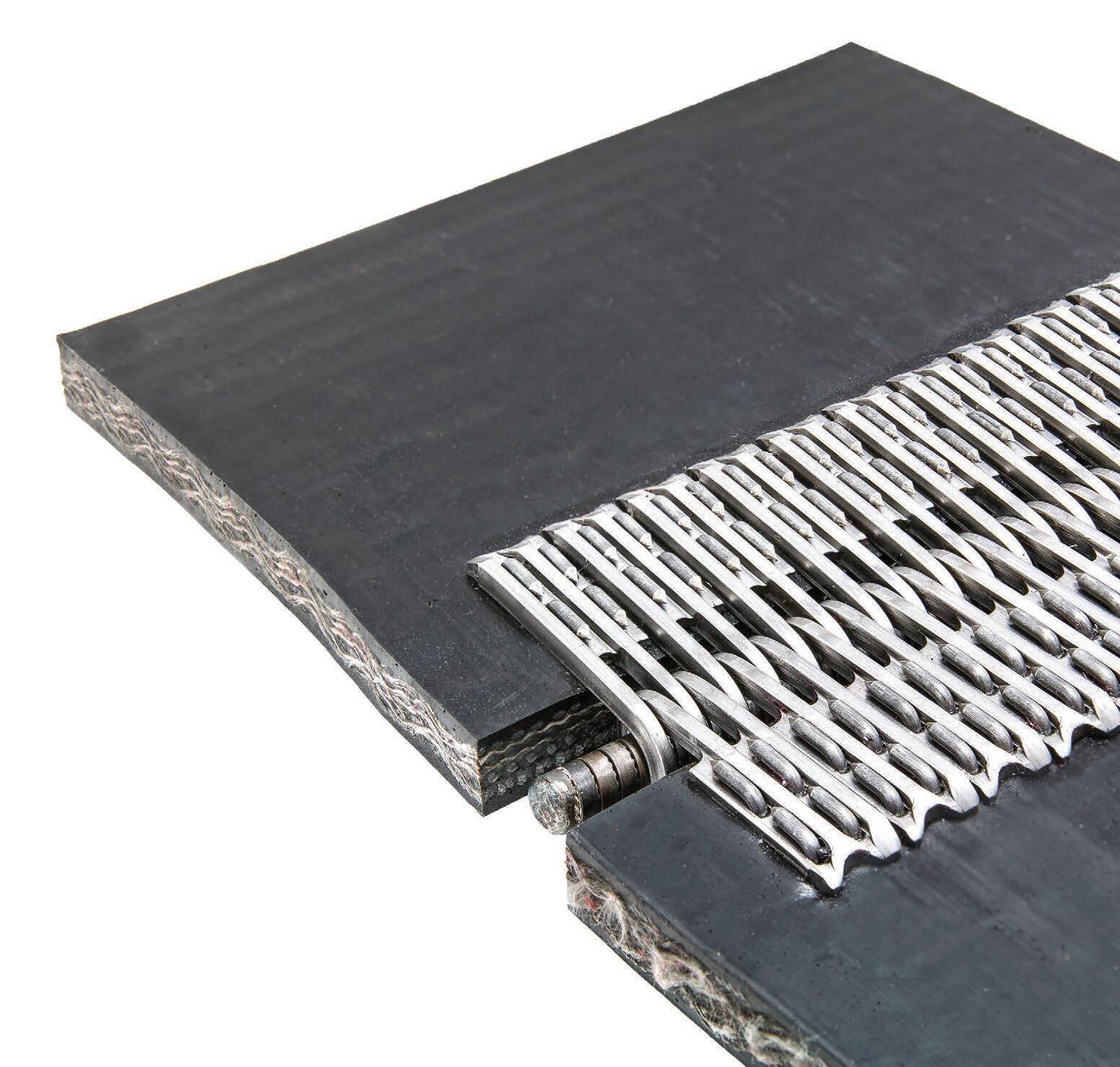



The Innovative Mining Solution Award is proudly sponsored by
ROY HILL’S AUTONOMOUS HAULAGE SYSTEMS PROJECT AIMS TO COMPLETELY AUTONOMISE ITS MINE WITH AN ENTIRELY DRIVERLESS FLEET.
As champions of innovation, Roy Hill has always planned to undergo a transition to autonomous haulage.
After three and a half years of collaborating with two mining technology specialists, 2023 was the year in which the Pilbara-located iron ore mine made it happen.
While the Western Australian mining company investigated available original equipment manufacturer (OEM) solutions, they were not considered suitable to the mine’s operational requirements.
Roy Hill leaders could see this was a problem other WA mines were also facing, saying that available solutions could be inflexible and not cost-effective.
development of a tailored, agnostic autonomous system that could be applied to the mine’s mixed haul truck fleet with built-in flexibility to extend to other heavy vehicles.
automation specialists from around the world, Roy Hill executive chairman
Gina Rinehart and the company board recommended a partnership with US-based ASI Mining and global mining equipment and solutions provider Epiroc.
All three companies signed a contract to get started in February 2020. Together, they developed a world-first autonomous haulage systems (AHS) solution.
The system has not only met Roy Hill’s needs but it has commercialisation potential, thus making autonomy an affordable option for other mining operations.
Alongside its interoperability and scalability, Roy Hill’s solution allows
reduced travel and accommodation requirements, and greater productivity resulting from mine network and planning improvements.
Roy Hill said it will also help to achieve at least a 65 per cent reduction in recordable injuries and more than 85 per cent fewer near miss and accident damage events, along with reducing staff downtime, driver fatigue and softtissue injuries.
Since its introduction to the market on March 1 2023, the AHS solution has converted a third of Roy Hill’s fleet to being autonomous, leading to led to the company taking out the Innovative Mining Solution category at the 2023
operations centre in Perth, creating further efficiencies across the company’s integrated demand chain.
“Reaching this point in less than four years has required strong leadership, respectful engagement with the workforce and business foresight to identify opportunity for commercialisation,” Roy Hill said.
“The future benefits to the iron ore operation and the potential for the international mining sector are significant.
“The Roy Hill mine is operating with an AHS that can expand across other heavy vehicles like water carts and dozers in future and integrate with
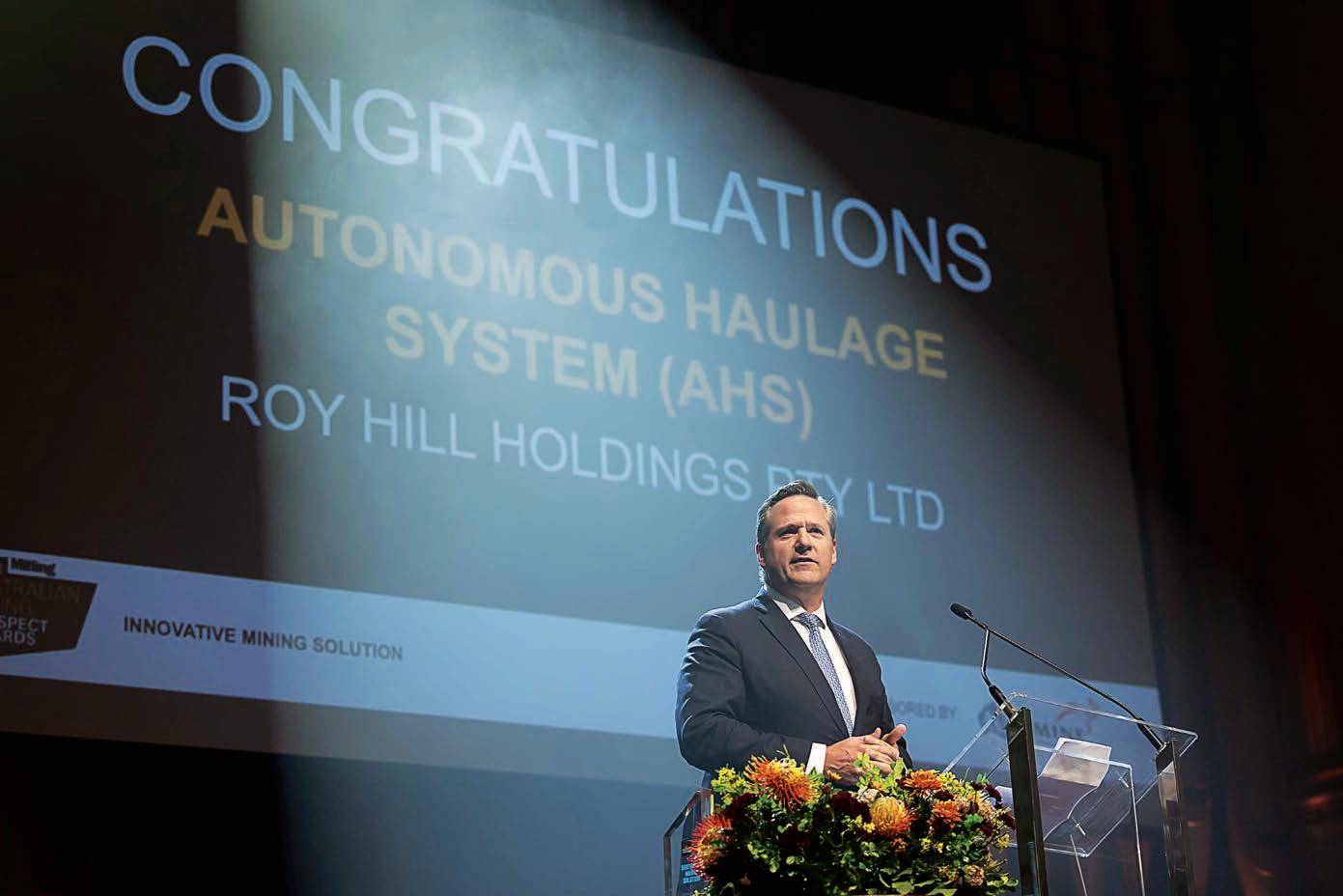
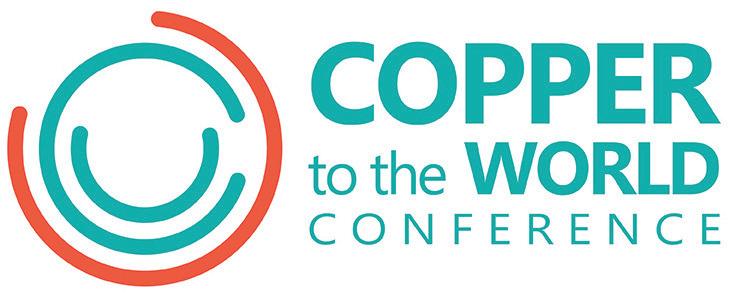
Conference Themes:
Setting Sustainable Foundations
Innovation in Exploration: Accelerating Copper Discovery
Innovation in Processing: The Next Frontier
Innovation in Underground:
Extending the Life of Mine
Technology Roadmap for Sustainable Copper
Creating Value Through Innovation
Copper Outlook and Future Supply






The Mine Project Success of the Year Award is proudly sponsored by
MMG’S ROSEBERY MINE HAS SEEN IMPRESSIVE RESULTS FROM THE IMPLEMENTATION OF HEXAGON’S HXGN MINEPROTECT OPERATOR ALERTNESS SYSTEM.
As new developments and advancements are made in mining technology every day, the Mine Project Success of the Year Award aims to single out a significant project to represent the thriving broader industry.
Having already taken out the Excellence in IIoT Application category at this year’s Prospect Awards, Hexagon’s HxGN MineProtect Operator Alertness System (OAS) was again celebrated for its successful implementation at MMG’s Rosebery mine in Tasmania.
Hexagon partnered with MMG, an international producer of base metals, to deploy the HxGN MineProtect OAS on 11 underground mining trucks at Rosebery.
When combined with distraction, fatigue is reported to be responsible for 65 percent of accidents in open pit mines.
MMG wanted a solution that would help detect fatigue in its operators while also being reliable in a complex underground environment.
That complex underground environment presented unique challenges for implementing an alertness-monitoring system.


The OAS works in light and dark conditions to provide operators with real-time notifications, empowering them to act should they experience fatigue or distraction, allowing users to take immediate action to reduce risk and keep the mine site safe from the effects of fatigue.
The technology was seamlessly integrated into MMG’s systems, adding an additional layer of safety during operators’ 12-hour shifts, aligning with the company’s core value of prioritising safety and ensuring the well-being of its workers.
Rosebery general manager Steve Scott said MMG continues to look at new and innovative ways to enhance safety across the site.
“Our number-one value is we always think safety first, and nothing is more important than ensuring all our people go home safely at the end of each day,” he said. “We recognise that with long shifts, fatigue can become a hazard and Hexagon’s technology enables us to continue to assess the fatigue risk of our underground truck operators in real-time.”
Hexagon said the OAS stands as a top-level solution within the market due to its holistic approach to addressing operator alertness and safety concerns in underground mining.
“We’re excited to see Hexagon’s OAS being deployed in an underground operation for the first time, and we appreciate MMG’s dedication to keeping their workers safe,” Hexagon APAC vice-president Simon Stone said.
“The deployment of our OAS is already providing valuable data for their operation and making a difference in the safety of MMG’s workers. We look forward to continued partnership towards their long-term success.”
Hexagon technologies aim to shape production and people-related ecosystems to become increasingly connected and autonomous, ensuring a scalable, sustainable future.
With a proven track record of success at MMG’s Rosebery mine, Hexagon’s OAS solution is poised to revolutionise safety standards and operational outcomes across the mining industry. AM

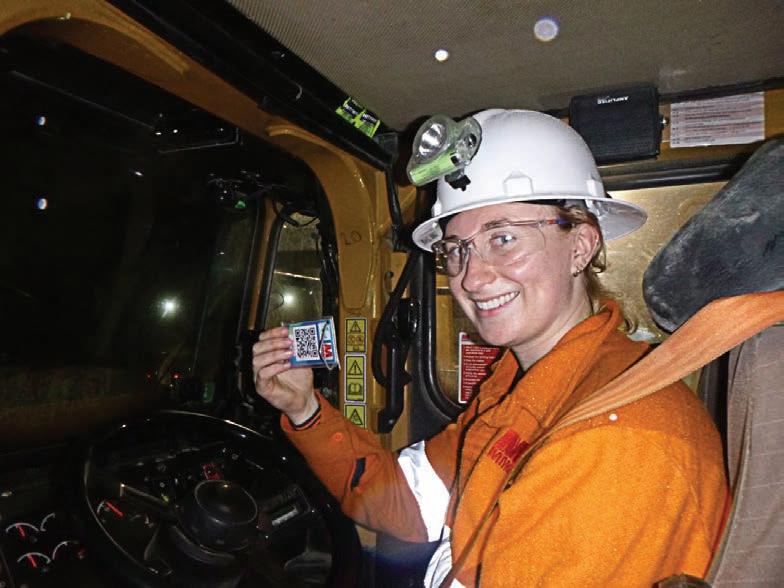
OAS

United. Inspired.
With Epiroc’s Rig Control System (RCS), the Pit Viper series can be configured with scalable Automation features such as AutoDrill and AutoLevel. It can be run with the operator off the drill, as well with the optional BenchREMOTE package, enabling one operator to run one or multiple units. RCS provides the foundation to add new functionality and options later without a major rebuild of the machine and autonomous drilling can be implemented with almost no human interaction with the drill.


The Discovery of the Year Award is proudly sponsored by
INTERNATIONAL GRAPHITE’S SPRINGDALE GRAPHITE PROJECT IS SET TO ESTABLISH AUSTRALIA IN THE GLOBAL MARKET.
Celebrating a significant discovery at either a greenfields or brownfields site, the Discovery of the Year Award recognises a significant new contribution the broader Australian industry.
International Graphite (IG6) was victorious in the category this year for its Springdale graphite project near Collie in Western Australia.
Having grown from an unknown asset into the second biggest graphite deposit in the country in under 18 months, the discovery puts IG6 on track to become one of the largest producers of battery anode graphite for the global lithium-ion battery market in the world.
While Australia is a key producer of other battery metals, there were no active Australian graphite mines in operation until IG6 sought to break onto the scene.
On a global scale, the Springdale project is now one of the top 15 graphite deposits outside of China, and it is an important new source to help meet escalating world demand for critical battery minerals.
The Springdale tenements were acquired by IG6 in April 2022. The first drilling program commenced in July 2022 and was completed in April 2023.
In that time, the mineral resource estimate increased by an impressive 3.4 times, from 15.3 million tonnes (Mt) at six per cent total graphitic carbon (TGC) to 49.3Mt at 6.5 per cent TGC.
Although it is already a highly promising operation, the future may have a lot more to offer, with only 10 per cent of the tenements landholdings having been drilled and more than 80 per cent of the identified targets yet to be investigated.
Preliminary test work shows that the Springdale fine flake graphite mineralisation is ideally suited to battery anode material.
By 2025–26, IG6 intends to build and operate an open-cut mine producing graphite for downstream processing. The company is also planning to build its own battery anode facilities in Collie to treat Springdale concentrates.
IG6’s aim is to create a fully integrated mine-to-market operation in WA and help pioneer a new industry for Australia.
The success of the Springdale graphite project discovery will make it


manufacture of battery anode material, and to do so in the attractive Tier 1 resource jurisdiction of WA.
IG6 ultimately plans to meet escalating global demand for battery graphite while minimising environmental impact and maximising social and economic value.
The global spotlight is on the power of batteries to drive decarbonisation and address climate change. According to IG6, this is fuelling a “tectonic” environmental and social shift as nations around the world compete for access to batteries and the materials needed to make them.
A marker of this shift was the $4.7 million grant IG6 was awarded by the Australian Government in May 2023.
The new grant is in addition to $2 million received from the WA Government in 2021, recognising the company’s ability to bring innovation to Collie as the regional community makes the economic and social transition from its traditional reliance on coal mining and coal-fired power generation.


IG6 to maximise and retain value on Australian shores and establish sovereign resilience and national supply security for a critical commodity,” the company said.
“By investing in cutting-edge processes and working closely with government, community and
to create long-term value for all of its many stakeholders.
“The Springdale graphite project is a milestone in Australia’s evolution as a battery minerals superpower and a critical discovery for international graphite and the industry as a whole.” AM

Atlas Iron is proud to sponsor the Discovery of the Year award at this year’s Australian Mining Prospect Awards. In recognition of excellence and innovation in the resource sector, the winners represent the highest achievers in their field. Congratulations to all award winners.


The Outstanding Mine Performance Award is proudly sponsored by

RPerformance category of the Prospect Awards celebrates a site that has carried out an innovative project, partnership, initiative or program.
This year saw Anglo American honoured for its Aquila coal mine in central Queensland.
The mine was reopened with an expansion in 2022 and is expected to surpass a five million tonnes in production in 2023.
The crowning jewel of the mine’s resurrection is its longwall shear, which was completed last year on time and within budget and has seen a reduction in operational exposure of 15,000 hours.
An industry leader in autonomous mining, Anglo American is also committed to keeping Aquila’s output going as it transitions to completely carbon-neutral operations by 2040.
Aquila was developed by Anglo American as one Australia’s most
automation technology, remote operations and data analytics.
The mine features two longwalls, enabling ‘walk-on, walk-off’ operations that ensure the mine continues to operate without the downtime usually required for longwall moves.
The two longwalls are fully remotecapable and operated from the operations centre on the surface of the mine.
The first longwall panel at Aquila achieved a significant breakthrough, with 42 per cent of longwall shears effectively conducted through the remote operation centre.
Building on this success, the subsequent panel showcased an exponential advancement, with over 97 per cent of the shears coming from the remote operation centre.
Since April 2023, 100 per cent of shears have been completed from the remote operation centre, which has cemented a shift towards remote control
innovative new technologies and applications, Anglo American has provided the systems needed to remotely operate an autonomous longwall safely and consistently, enabling operations to be safer, more efficient and sustainable.
The primary aim of implementing remote operations in the context of longwall mining was to proactively minimise human presence in underground areas with potential operational hazards.
“This strategic move aligns with our unwavering commitment to safety,” the company said.
“The magnitude of this accomplishment is a testament to the collaborative efforts between Aquila mine, Anglo American’s technology and automation team, and corporate supplier partners.
“This concerted collaboration has yielded a ground-breaking series of pioneering safety and production
By the time operational ramp up was completed in July 2022, the mine seamlessly transitioned to remote longwall operations, setting the stage a year of growth that yielded 4.3 million run-of-mine (ROM) tonnes.
And while Aquila is poised to surpass five million ROM tonnes in 2023, it’s set to improve further in 2024.
As it looks to the future, Anglo American is also committed to a push towards decarbonisation at its mining operations.
With its stated goal to achieve carbonneutral operations by 2040, the company reduced Scope 1 and 2 emissions by 21 per cent below the peak levels of 2019 by the end of 2022.
Anglo American intends to transition to 100 per cent renewable electricity supply across its Australian operations, starting in 2025 after its South American operations undergo the same change. AM



Mining facility operators are constantly being challenged to minimise costly system downtime by being able to accurately predict the future performance of their operating equipment. This is now made possible with a comprehensive asset management solution from SEW-EURODRIVE.
DriveRadar® is a condition-based maintenance forecast system for drive equipment.
It determines the condition of industrial gear units by analysing data collected from them while in operation. Using a ‘digital twin’, the analysis not only aids monitoring and planning of maintenance activities, but accurately predicts imminent damage. Thus, DriveRadar® can prevent otherwise unforeseen failures and breakdowns, detect wear, and minimise unexpected downtimes, delivering economic benefits to its users.
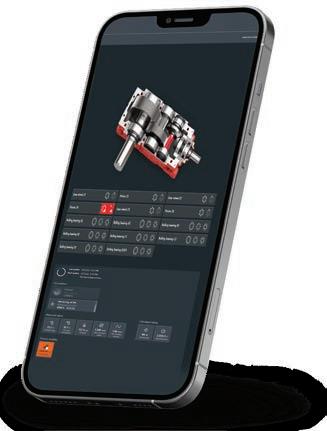



ROY WATTERSON’S LEGACY IS ONE OF DEDICATION AND COMMITMENT TO THE AUSTRALIAN MINING INDUSTRY.


Recognising an individual who has shown a dedicated commitment to contributing to the Australian mining and mineral processing industries throughout their life, the 2023 Lifetime Achievement Prospect Award honoured late Lincom Pacific Equipment chief executive officer Roy Watterson.
Watterson was dedicated to the business he founded and watched grow for 25 years. Under his leadership, Lincom expanded in Australia, Papua New Guinea and the Pacific Islands to become one of the most successful equipment manufacturing suppliers to the Australian mining industry.
Thanks to Watterson’s efforts, Lincom prides itself on a strong foundation of family values, with his son Stephen Watterson taking over the reins of the company as the next generation of commitment to delivering quality service to Australia’s mines.
Watterson’s career left a permanent mark on the Australian mining and quarrying industries, earning him a reputation as a visionary leader. With a natural aptitude for business, he seamlessly navigated the complex world of machinery and sales, leaving a legacy of innovation and achievement.
Watterson immigrated to Australia from Ireland in 1982 to become sales manager at crushing, screening, and processing equipment provider Finlay
(a Terex company). Based in Brisbane, he quickly displayed his capabilities, earning promotions and recognition for his dedication and expertise, and it wasn’t long before he ascended to the company’s managing director position.
Watterson’s pioneering spirit led him to expand Finlay’s global footprint.
In 1985, he orchestrated the company’s entry into new markets, extending its sales reach into Papua New Guinea and Indonesia. This move solidified Finlay’s presence in the Asia-Pacific region and set the stage for Watterson’s future successes.
In 1989, Watterson took a significant step by expanding Finlay’s operations into China, specifically focusing on the coal market.

This strategic vision allowed the company to tap into the immense potential of China’s growing coal industry, marking yet another career milestone.

Watterson decided to chart his own course in 1995, resigning from Finlay and founding Lincom Group. Under his leadership, Lincom rapidly became a major equipment supplier to the Chinese
During this period, he was also involved with a number of other Australian businesses, such as Nepean Conveyors and Universal Drill Rigs. Over the years, Watterson significantly increased Lincom’s footprint in the quarry and mining equipment industry, leaving an enduring impact across Australia and Papua New Guinea.
In 2012, Watterson’s unwavering commitment to expansion prompted Lincom to venture into New Zealand and the Pacific Islands.
Strategically situated in southern Queensland, Lincom’s headquarters served as a pivotal base. Lincom later established service hubs, warehouses and offices in key resources regions, including New South Wales, Victoria and Western Australia.
In 2021, Watterson passed away tragically in an accident.
His contributions to the sector continue to be remembered and celebrated, and his legacy lives on through the business he helped and the countless lives he influenced along the way.
Watterson’s remarkable journey from sales manager to industry pioneer is an inspiring example of what can be achieved with passion, vision and relentless determination. AM
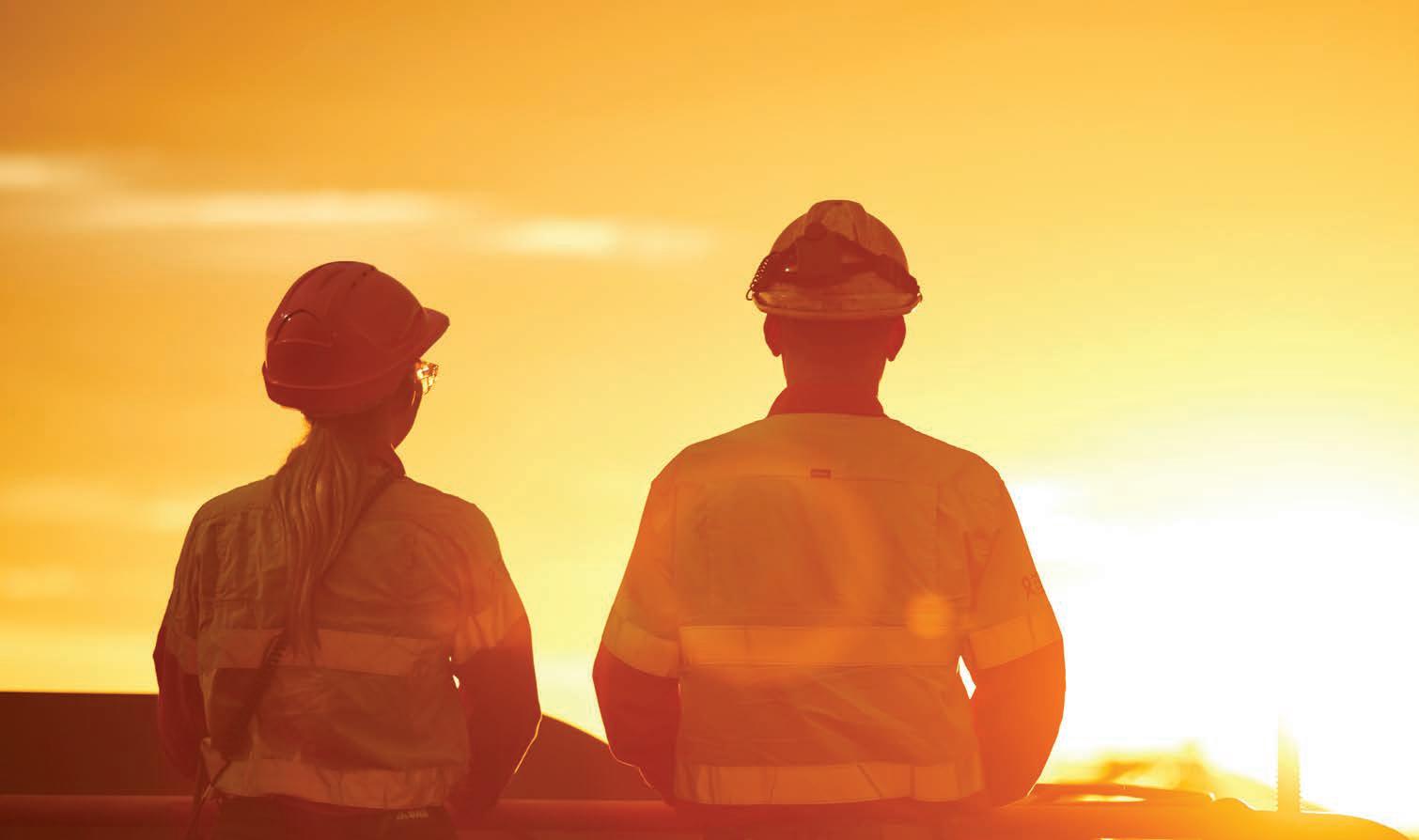

Roy Hill is proud to join with the Australian Mining Prospect Awards in sponsoring the Lifetime Achievement award. This award recognises the best in mining and minerals processing across the nation. The strength of our industry relies on excellence and innovation, driven by people. When mining does well, Australia does well.
Congratulations to all award winners.
Learn more about Roy Hill
When it comes to communication technology, connectivity, and digitalisation in the mining industry, it may sometimes seem like there are more questions than answers. Luckily, Madison Technologies has made it its business to answer these questions.
“We see ourselves as an Industry 4.0-enablement partner with handson experience and understanding of OT (operational technology) systems design and implementation,” Madison Technologies chief executive officer Paul Calabro told Australian Mining Madison Technologies understands it can be difficult for mining companies to move away from reactive responses in operations, and towards predictive responses based on the data gained from digital transformation.
“Our purpose is to enable digital transformation and help organisations unlock the full potential of their operations with purpose-built solutions that unlock data insights and business intelligence, but this can only be achieved through strong relationships with customers and suppliers,” Calabro said.
To support its mining customers in making this change and reaching their digital transformation goals,
Madison Technologies has a portfolio of technologies that can help make a mine site more productive and efficient.
“The deployment of digital technologies to monitor environmental or asset performance conditions, such as Industrial IoT (Internet of Things) devices capable of running on batteries for several years with low transmit frequency, allows our mining customers to gain greater operational predictability and use insights from captured data to manage their business more confidently,” Calabro said.
A primary example of this was when Madison Technologies supported a mine site to address inefficiencies across the mine’s critical communications network.
By working with one of its systems integrators, Madison Technologies was able to deploy a mesh connectivity network that reduced communication failures between trucks and communication towers by up to 50 per cent.
This was just one example of how industrial connectivity solutions can help drive increased productivity and occupational health and safety outcomes.
Madison Technologies leverages two key pillars to help guide its mining customers to a helpful and advanced technology solution: its operational technology specialists and in-house technology experts.
“The expertise of our operational technology specialists covers connectivity, Industrial IoT and cybersecurity along with our edge technology and camera-as-a-sensor solutions,” Calabro said.
Madison Technologies’ in-house technology experts provide an advanced level of technical knowledge to support a successful deployment to customers.
Their knowledge is used to effectively develop solutions that solve the unique challenges of the mining industry by using the latest and most applicable technologies.
“This collective experience is a cornerstone of our approach,” Calabro said. “It enables our team to swiftly grasp our clients’ unique challenges within their operational environments.
Other technologies that Madison Technologies can provide include cameras with onboard artificial intelligence (AI) and machine learning, advanced OT cybersecurity solutions, and Industrial IoT for precise and automated data measurement.
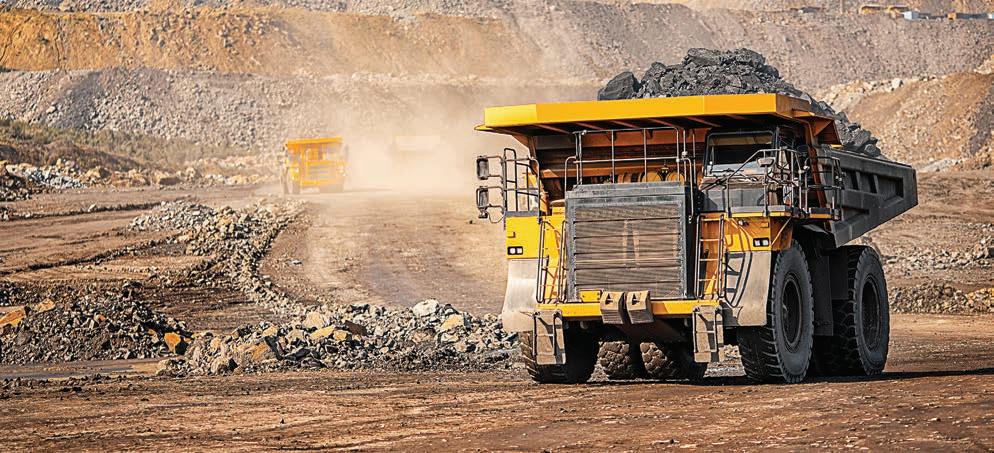


“With over 30 years of reputation in bringing value to the market, our customer relationships span across many industry verticals, thousands of organisations and tens of thousands of contacts,” Calabro said.
“This rich history of placing the customer at the centre of what we do has enabled us to thrive with our customers and share in the success of operating as a 100 per cent Australian-owned-andoperated business.”
But what really sets Madison Technologies apart is a legacy of consistent dedication to enhancing the customer experience.
“As we see more of our world move to online engagement, there is still something to be said about people wanting to deal with people, and our organisation is a testament to how we have conducted ourselves over the last 30 years,” Calabro said. AM




Running your operation is a challenge, but maintaining your equipment should not be. With McLanahan, we provide expert mining equipment solutions to make your life easier. Our solutions are designed to simplify your operations and maximise productivity as well as providing the highest quality after sales service and support.
With a commitment to minimising downtime through regular maintenance and reliable support, you can trust us to keep your operation running at its highest performance.

THROUGH A SUSTAINABLY MINDED POWERSCREEN, THE AUSTRALIAN RESOURCES INDUSTRY IS GAINING INSIGHT INTO WHAT AN ELECTRIFIED MATERIAL HANDLING SECTOR LOOKS LIKE.

Ggeographies and harsh conditions of Australian mining, electrifying the industry’s material handling sector is not easy.
But as marketing manager of one the world’s largest manufacturers of crushing, screening and conveyor equipment, Dermot McCracken believes this presents an exciting opportunity.
“The mining sector probably has the best potential of the industries we work in (to decarbonise its material handling equipment) because of the scale of the companies that work in that space,” McCracken told Australian Mining.
Many Tier-1 miners generate the margins to fund innovation and new technologies, and this is being put to good use, with more capital than ever being spent on electrifying machinery such as haul trucks and loaders.
Decarbonising material handling equipment, such as crushers and screeners, can also be part of the equation, and Powerscreen already has technologies to support this.
What starts with Powerscreen’s inherently sustainable mobile design is furthered by the Powerscreen Hybrid range, which when powered off the grid can reduce on-site carbon emissions by approximately 57 per cent per tonne of material produced.
An extension of the Hybrid series is the Powerscreen Chieftain 2100XE, an electric-powered screener generating plenty of attention within the Australian mining industry.
screener, where the only diesel you’re essentially using is to transport the machine,” McCracken said. “When we demoed the Chieftain 2100XE at Hillhead 2022 (a biennial quarrying conference in the UK), it attracted a lot of interest from all corners of the globe, including Australia.”
Current Powerscreen customers operating in the Australian mining industry suggested the Chieftain 2100XE could be even more suitable to their operations if the genset – the screener’s power generator – was track-mounted.
Such an offering would replace a wheel-mounted genset and enable miners to freely transport the genset around the vast and rough terrains of an Australian mine site.
So Terex – Powerscreen’s parent company – has got to work with two other UK innovators, CATAGEN and Wrightbus, on a screener that could meet these needs.
“If we bring this prototype with a tracked genset to the market, we think that’s a potential game-changer for mining in Australia, and for remote quarries everywhere,” McCracken said.
“Hopefully at the end of this project, we’re able to say to our mining customers, ‘Here’s a hybrid-powered crusher, a hybrid-powered screen and a tracked genset to go with it’. This is a completely different conversation to anything we’re having today.”
McCracken said the possibility of a tracked genset also opens the door for a larger genset, which could support larger hybrid screeners or crushers in the future.
electric option for its Premiertrak 450 crusher, which McCracken believes could tick boxes for the mining industry.
“The Premiertrak 450E could be an entry-level opportunity for miners to enter the electric space because it is a mid-to-large-sized crusher that can offer the level of production customers need,” he said.
Backed by four pillars, Powerscreen’s decarbonisation strategy is gaining momentum, generating solutions for a material handling industry not naturally conducive to decarbonisation.
As McCracken indicated, Powerscreen is beginning to put “meat on the bones” of its decarbonisation strategy.
“We have a pretty clear path of different industries, different insights and what our product portfolio looks like,” McCracken said.
“Where we’re at in five years is usually the strategy but we’re now getting insights into five-to-10 years from now.
normally about, ‘When’s the next machine coming out?’, rather than looking longer term, and in mobile crushing and screening it’s usually about, ‘Who can make the next biggest crusher and the next biggest screen?’.
“It’s not about who can make this hybrid-powered machine with a track genset that still meets our requirements. That’s the space we’re going into.”
As Powerscreen conceptualises what a decarbonised material handling industry looks like, industrial sectors across the world have answers to their netzero questions.
This includes the Australian mining industry, which through Powerscreen supplier Lincom Group, will be first to access the hybrid-powered Premiertrak 450E or a Chieftain 2100XE with a track-mounted genset.
This alongside every other electrified solution Powerscreen engineers in the future. AM


THE FLYGT BARTAIL RANGE IS XYLEM’S NEW SOLUTION FOR THE HARSHEST UNDERGROUND DEWATERING APPLICATIONS.
As the Australian resources industry responds to the increasing mineral demands of a decarbonising world, underground mines are getting deeper and more challenging.
This is placing greater stress on submersible pumps, which play a critical role in keeping underground mines dry.
In response, Xylem – which has been helping the mining sector solve water problems for over a century – has added to its Flygt submersible pump range with a new premium extension.
The Flygt Bartail duplex white iron and duplex stainless steel hydraulic end has been specifically engineered to survive highly erosive and highly corrosive dewatering applications.
This is exactly what the Australian mining industry has been crying out for – a hydraulic pump end that can handle the harsh contaminants modern-day underground dewatering throws at it, with longer-life and lower operating expenditure (opex) the end goal.
Xylem dewatering product and marketing manager – Australia and New Zealand, Cameron Pate, explained in more detail.
“Our standard Flygt 2125 (8kW) and 2151 (20kW) offerings have continued to be the market leader for over 30 years,” Pate told Australian Mining
“The premium Bartail range will be a welcome addition to handle those harsh applications as well as improve pump life on-site.”
“While the standard Flygt product still does an excellent job, this premium extension in our Flygt range is more superior and gives customers a longerlasting product. It is also the go-to option for aggressive duties.”
Not only has the design of the hydraulic end been improved to support more efficient pumping but the metallurgy of the part has been enhanced to make it more durable.
By combining duplex white iron and duplex stainless steel, the hydraulic end was engineered to combat very erosive and corrosive underground conditions.
While dewatering pumps are designed to pump water rather than slurries, as the mining industry continues to raise performance targets to meet increasing mineral demand, some responsibilities are going by the wayside, such as sump management.
“Sumps collect underground runoff materials such as shotcrete fibres, fines and mud, but as mines get busier and busier, sumps are being cleaned out less and less, which means they end up pumping a much more aggressive product, almost a slurry-like product,” Pate said.
It is for this reason that underground pumps should be installed with longevity in mind, something the Flygt Bartail range can ensure.
WE’RE MARKETING THE FLYGT BARTAIL RANGE AS A PREMIUM EXTENSION FOR TOUGH APPLICATIONS AND TOUGH DUTY POINTS –ANYTHING THAT IS LOW PH, HIGH EROSION, HIGH FINES AND HIGH SHOTCRETE.”
The fact the Flygt Bartail hydraulic end can be retrofitted to all existing Flygt 2125 (8kW) and 2151 (20kW) pumps as well as competitor equivalents means mining operators can easily upgrade their existing fleets to the longer lasting premium Flygt Bartail product.
Pate said this is a key consideration for Xylem customers.
“If you think about it, there’s thousands of assets out there in the Australian mining industry and there’s extreme risk to the customer if they install a new product and it doesn’t work,” he said. “This could have serious business implications in having to swap out entire fleets.


“Our underground mining customers aren’t always looking for a completely new pump. Many of them are looking for the same product they’ve used for 10, 15, 20 or 30 years, but a better version of it.
“So we’ve created a solution where our customers can keep the same pump and drive unit, but upgrade to an improved bottom end.”
A more durable hydraulic end not only keeps dewatering operations running for longer but eases the load on maintenance teams. This is particularly significant considering some mine sites have up to 400 pumps on-site.
“Most of the time underground dewatering makes up a small percentage of operational costs – often less than one per cent – but dewatering issues or water issues can create a huge amount of risk to the business,” Pate said.
“If a mining company or contractor doesn’t get it right and a pump fails, the flooding and cost to production can be huge.
“Customers are not normally thinking about costs to remove an asset or change an asset; they’re more focused on mitigating risks and ensuring pumps last longer – to reduce risks of flooding and having to change them out.”
Pate said Xylem’s standard Flygt product continues to perform strongly in underground environments, with the premium range focused on improving the customer experience and really solving the harshest water challenges.
“We’re marketing the Flygt Bartail range as a premium extension for tough applications and tough duty points – anything that is low pH, high erosion, high fines and high shotcrete,” Pate said. “This is where the product really shines.”
And Xylem has ambitions to apply the unique duplex white iron and duplex stainless-steel metallurgy to other products.

“We currently offer the Bartail hydraulic end for our 8kW 2125 and 20kW 2151 Flygt pumps, but we plan to extend this metallurgy to other Xylem brands and ranges,” Pate said.
Not only able to keep operations running for longer, the Flygt Bartail hydraulic end enables greater dewatering efficiency, reducing a miner’s overall carbon footprint and delivering improved environmental, social and governance (ESG) outcomes.

Xylem knows it’s onto a good thing with its Flygt Bartail range, with possibilities to support an Australian mining industry entering deeper and harsher underground environments.
It’s uncharted territory for the sector, but as technologies continue to expand and original equipment manufacturers (OEMs) such as Xylem evolve to support the growing demands of their customers, the Australian mining industry is in good stead. AM

CRUSADER HOSE’S FLEXIBLE LAYFLAT HOSE IS RECOGNISED AS A PREMIUM HOSE OPTION IN THE AUSTRALIAN MINING INDUSTRY.
Pumping water out of deep pits or open-cut mines is critical to keeping work areas dry and safe. But there can be challenges with running a pipeline up a high pit wall with poly pipe. These are eliminated when using flexible layflat hose.
On mine sites, especially in opencut mines, water can accumulate due to natural groundwater flow, rainfall, or seepage from surrounding sources. Removing this water is critical to supporting worker safety and maintaining operational uptime –valuable orebodies cannot be accessed unless they are effectively dewatered.
Typically, a pump is strategically placed at the bottom of the pit to which a pipeline is connected, running up to the top of the pit. From there, the water is pumped along another pipeline and discharged elsewhere.
The most common type of pipeline used from the pit and up the high pit wall has been HDPE poly pipe. However, poly pipe can present several challenges regarding pressure factors, strength issues, and temperature sensitivity.
These challenges are eliminated with an alternative flexible pipeline developed in Australia. Crusader Hose has engineered mine dewatering systems for safer handling up high pit walls, generating efficiency benefits in time and cost.
Firstly, ordinary HDPE pipe does not have a high-pressure rating. For poly to be used in high-wall applications, the HDPE pipe must be thicker to gain pressure. But this makes it heavier and stiffer, which becomes more difficult and dangerous to handle up or down a mine wall.
The second issue relates to its inherent rigidity. In addition to the logistical challenge of installing this stiff and heavy pipe, a HDPE pipeline does not take the contours of the benched slope.
The downward force this creates and the pipeline’s weight requires proper anchoring and support systems to ensure the pipeline stays in place.
Anchoring the pipeline securely at the top of the pit requires either concrete blocks or steel supports and workforce hours using heavy machinery. This anchoring is a major task.
A third issue with poly pipe refers to its temperature sensitivity. Polyethylene can become brittle at low temperatures
or soft at high temperatures. Extreme temperature variations within the pit can affect the pipe’s performance.
The engineers at Crusader Hose have developed a flexible hose for dewatering pipelines that can handle high pressures of up to 4000kPa (kilopascal).
UV resistant and able to handle extreme temperatures, with the six-inch diameter 3500kPa working pressure pipeline weighing only 3.4kg per metre, it’s far superior than its poly counterpart.
The layflat hose’s flexibility allows it to take the profile of the benched and sloping mine wall, with the weight of water inside holding the pipeline down against the sloping terrain without putting strain at the top of the pit.
“With the downward force nearly eliminated, the hose is not prone to sliding or falling down, removing a major handling and safety risk,” Crusader Hose managing director Francois Steverlynck said.
Recently returned from a large mine in Western Australia, Steverlynck saw firsthand the versatility of Crusader Hose’s flexible pipeline.

HOSE HAS DEVELOPED A FLEXIBLE HOSE FOR DEWATERING PIPELINES THAT CAN
little as 10m laid flat at the top eliminates the need for an anchor,”

THE FLEXIBLE LAYFLAT HOSE HAS RECENTLY RETURNED FROM A LARGE MINE IN WA.

10m from the edge. Depending on site access, the reel can also be placed at the bottom of the pit.
The hose needs to be pulled off the reel by a rope.
“The typical method to get a rope down from the top of the pit to the bottom is by firing a crossbow or using a drone,” Steverlynck said. “A thin rope is used to pull down a thicker and stronger hose.”
The rope at the bottom is connected to a vehicle or winch, which drags the
system, you remove a significant safety risk by not having to position 15-tonne concrete blocks at the perimeter.”
Installing a flexible pipeline down the wall
Before any installation, a thorough assessment of the wall and site is necessary, including wall
“What was once a complex and highly specialised task with poly pipeline installation, installing a flexible pipeline is much less arduous and takes a fraction of the time,” Steverlynck said.



THE VOLVO CO-PILOT BRINGS THE NEXT GENERATION OF MINING TECHNOLOGY TO A MINE’S DOORSTEP.
As the demand for minerals and resources continues to grow, so does the mining industry’s responsibility to adopt sustainable technologies and practices.
The demand for efficient, economically viable solutions has led to remarkable innovations in the mining sector.
This includes the Volvo Co-Pilot, an intelligently designed interactive display enhancing mining operability.
Available as an option on select Volvo machinery, this technology is dedicated to equipping operators and site managers with a comprehensive toolkit and a wealth of information necessary for the establishment and maintenance of a highly sustainable, productive and profitable operation.
First released in 2016, Volvo Co-Pilot is fitted with all the latest technological advancements in
VOLVO CO-PILOT IS FITTED WITH ALL THE LATEST TECHNOLOGICAL ADVANCEMENTS IN DRIVER ASSISTANCE. THE VOLVO CO-PILOT IS DEDICATED TO GIVING OPERATIONS A COMPREHENSIVE INFORMATION TOOLKIT.
driver assistance and safety features, setting the industry standard for excellence. It seamlessly works with Volvo Assist, a collection of functions comprising of dig assist, haul assist and load assist, providing real-time operational data for a responsive, harmonious and efficient operating experience.
When a SIM card is inserted, the Android-powered tablet display becomes 3G-enabled, facilitating seamless and wireless reception of software updates for the system.
The Co-Pilot system harnesses the potential of onboard machine data and high-precision sensors to streamline tasks, resulting in significant reductions in project completion times.
Co-Pilot’s user-friendly interface ensures operators can quickly initiate projects with just a few simple taps, effortlessly selecting the required job parameters.
Data collected through the Assist software programs can be captured in several ways. For example, it can be transmitted to the Cloud for access via an online portal, transferred to a flash
connected to the Co-Pilot interface through USB.
The logged information encompasses vital details such as work order number, customer name, loaded truck, load


time of delivery, neatly organised in a spreadsheet format that seamlessly integrates into any customer’s enterprise resource planning system.
Notably, since Co-Pilot and the Assist programs are intricately woven into the Volvo machine’s electrical infrastructure, the system continually provides productivity data to Caretrack, Volvo’s telematics system.
Presented in a user-friendly format, customers can review details about their machine’s fuel consumption, utilisation percentage, and excessive idling to enhance operational efficiency.
This invaluable information empowers owners to identify potential training needs for operators and readily compare operating costs against production figures, both by machine and operator. These insights are a unique advantage, setting this integrated system apart from third party aftermarket solutions.
Safety has always been a paramount concern in the mining industry and Volvo Co-Pilot, with its intelligent systems and assistive technology, plays a vital role in enhancing safety standards on mine sites.
Volvo Co-Pilot not only simplifies the demanding tasks at hand, but
also minimises workflow disruptions, enhancing onsite safety. The strategically positioned display reduces operator interactions with a reduced number of on-screen menus, enabling operators to stay focused on the task at hand.
This technology further promotes safety by promptly alerting operators, both audibly and visually, when predetermined operating limits are reached.
By employing Co-Pilot, the need for movement around the machinery and the necessity for additional on-site personnel are eliminated, resulting in an overall improvement in safety measures and operator autonomy.
With Volvo Co-Pilot, the operator can quickly and independently manage all operations with ease. The on-board display is intuitive enough to operate with minimal training and provides onscreen tips, optimising ease of operation.
Operators can also customise functions and targets in seconds and easily monitor the progress of their work with greater independence and confidence.
Sustainability is central to Volvo CE’s mission, and the Volvo Co-Pilot system is pivotal in promoting environmentally responsible construction practices.
By optimising machine operations and automating tasks, Co-Pilot actively contributes to reduced fuel consumption, lowering emissions and diminishing carbon footprints.
Furthermore, the system’s precise excavation and load-handling capabilities have the potential to minimise the need for rework, conserving materials, and further curbing waste production.
Volvo’s Co-Pilot monitoring features empower operators to make informed decisions based on data, resulting in additional reductions in fuel consumption and environmental impact.
By arming operators with tools that promote more efficient machinery operation, Volvo’s Co-Pilot is instrumental in fostering a mining industry increasingly committed to sustainability.
With Volvo’s commitment to sciencebased targets, the company continues to focus on environmental care and driving industry transformation to combat climate change.
Volvo CE leverages the extensive data gathered from operators worldwide to drive safety, uptime, and fuel efficiency enhancements that benefit both the present and future.
Integrating innovative digital technologies, such as Volvo CoPilot, streamlines the operators of Volvo machinery, promoting greater efficiency and concurrently reducing emissions, thereby enabling sustainable machine operation.
Volvo’s incremental improvements combine to deliver energy efficiencies across all types of Volvo construction equipment – a vital step forward in the world’s ongoing journey towards a carbon-neutral, sustainable future.
The global recognition of Volvo CE stems from its production of top-notch, safe, high-quality, and technologically advanced machinery. Telematics represents a significant stride in forming strategic customer alliances, complemented by additional productivity services.
For decades, CJD Equipment and Volvo CE have provided a range of premium construction machinery suited to Australia’s unique mining requirements.
Volvo and CJD deliver a range of productivity, fuel efficiency and safety solutions for a highly productive operation, ensuring machines perform at their best. AM
WITH GLENCORE SET TO DOWNSIZE MOUNT ISA IN 2025, WHAT IS THE WAY FORWARD FOR THE NORTH WEST MINERALS PROVINCE?
Glencore’s recent announcement that its Mount Isa copper operations and Lady Loretta zinc mine would close in 2025 sent shockwaves through the Queensland mining industry.
It signalled the end of two of Australia’s most iconic mining operations, which have supported the world with a sustainable supply of copper, lead, zinc and silver for up to 60 years.
In the wake of Glencore’s announcement, Queensland Premier Annastacia Palaszczuk announced a $50 million support package for the Mount Isa region and those affected by the impending closure.
This included up to $20 million, to be matched dollar-for-dollar by Glencore, for an economic structural adjustment package for Mount Isa and northwest Queensland.
The Queensland Government will also provide $30 million to support exploration in the North West Minerals Province across the next five years.
It is encouraging that the Queensland Government responded so quickly to Glencore’s announcement, but the way it allocates its resources is critical to
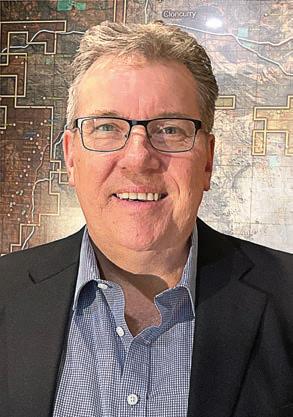
ensuring Mount Isa and the nearly 1200 workers set to be affected by the closure receive the appropriate support.

And with the North West Minerals Province boasting such a strong pipeline of advanced development projects, the precise allocation of funds could be a boon for the region’s mining future.
Transition Resources managing director David Wilson said it is vital to focus attention on near-term mines.
“Directing funds to exploration creates mines in 10 or 15 years,” Wilson told Australian Mining
jobs in a timeframe that matters to these 1200 workers. It also produces ore for toll treating at the Mt Isa concentrator and creates much-needed economic stimulus for the region.”
When Glencore closes its Mount Isa underground copper operations in 2025, it also intends to shut down its concentrator – a processing plant seen as a potential asset for near-term producers and the wider Mount Isa mining community.

term producers an opportunity to feed their ore through Glencore’s existing concentrator is not only significant for their futures but also Queensland’s overall mineral exports.
It also sustains jobs.
“By keeping the Mt Isa concentrator going, potentially for at least another four years, it saves hundreds of jobs,” Wilson said. “This gives everyone time to find alternatives, and for the government to accelerate the new Queensland Critical Minerals Strategy.”

Wilson said the continued operation of Glencore’s copper concentrator enables near-term mines in the region to enter production – by feeding ore to the Glencore mill – subsequently creating replacement jobs for the 1200 workers.
The North West Minerals Province is rich with near-term mining opportunities suited to toll treating development models. These often require only modest up-front capital to bring online, because there is no need to build processing plants or tailings facilities.
“Regardless of whether the Glencore concentrator stays open or not, and the preference is for it to stay open, there’s still an argument for the Queensland Government to fund and bring other near-term mines forward, by utilising toll treating options available at other processing plants in north-west Queensland,” Wilson said.
Wilson’s research identified at least 15 million tonnes of copper ore in the North West Minerals Province that

feeding Glencore’s concentrator.
Near-term producers include Wilson’s own company Transition Resources, Austral Resources, Hammer Metals
Aeris executive chair André Labuschagne said a prudent way for the Queensland Government to support the North West Minerals Province would be
to – as Wilson suggested – fund projects that could produce in the next two-tothree years.
“If you want to be serious about having replacement sources or suppliers to that (Glencore’s) processing facility by 2025, a couple of things need to happen,” Labuschagne told Australian Mining
“The government will have to look at investing in start-up operations … There are enough opportunities out there where they should be saying, ‘How do we help companies get these mines up and running by 2025 to be able to keep that (Glencore) facility open?’.
“Exploration is always good, and we should always invest in it, but if you really want to ensure that facility’s still there, invest in development mines and help them gain approvals in time because approvals these days can take two years or longer.”
Wilson proposes a two-phase funding process to kick-start the North West Minerals Province beyond Glencore’s 2025 Mount Isa downsizing.
Phase one would see the Queensland Government provide grants to qualifying mines of up to $10 million, to accelerate feasibility and pre-development activity. Additional grant funding of up to $10 million (matched dollar-for-dollar by each company) would then follow on a decision to mine.
“Given what is at stake here, these sums are extremely modest,” Wilson said. “For this outlay, the Queensland

Government sets in motion a process that will generate replacement jobs for the Mt Isa workforce and generate approximately $3 billion of potential revenue from 2025 to 2030. That would not happen without this support.”
Additional measures include subsidised ore deliveries to encourage toll treating, which would tip the economic balance at many projects away from building new processing plants towards utilising existing regional infrastructure.
“And by using existing infrastructure we get an environmental dividend –because we are not building as many processing plants,” Wilson said.
It is not just one or two local companies being supported by this funding, which is key to Wilson’s proposal. After breaking down the costbenefit all the way through the value chain, including royalties and taxes, the net benefit is substantial.
“But the most profound flow-on effects are social – providing job security for workers and their families, so they stay in the region and help sustain the rich social fabric that binds these remote Australian communities,” Wilson said.
“By contrast, the cost of not providing this targeted support is immeasurable.”
“There is a one-off opportunity here for the Queensland Government to achieve a remarkable social, economic and environmental return on taxpayer funds, in ways rarely available to governments.”

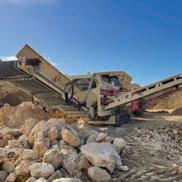
THE GD955-7 GRADER FROM KOMATSU IS SET TO TAKE THE AUSTRALIAN MINING INDUSTRY BY STORM.
When Komatsu debuted its GD955-7 grader in Mackay in October, it made a strong first impression on the Australian mining industry.
To keep this momentum going, the GD955-7 recently travelled around the
country on a road trip to local miners.
“We currently have two GD955-7 graders in the country – one in New South Wales and the other in Western Australia,” Komatsu Australia national product manager Michael Hall told Australian Mining
“We’re now finalising the mining specs for the machines. We expect to have them ready to deliver to customers
WEIGHING AT NEARLY 47 TONNES, THE GD955-7 WAS SPECIFICALLY BUILT FOR MINING FLEETS.

THE GD955-7 GRADER MADE ITS AUSTRALIAN DEBUT IN MACKAY, QUEENSLAND.
here in Australia in mid-December to early next year.”
Like all Komatsu machinery and equipment, the GD955-7 was built with customer experience at the forefront.
“We spoke with our customers, listened to their needs and built a machine that will meet those needs now and into the future,” Hall said.
“The main feedback we received was that they required a higher effective blade downforce. If you don’t have sufficient blade downforce, the blade bounces along haul roads, particularly when you’ve got large trucks, fully loaded, compacting the road surfaces – the grader needs that extra machine weight and hydraulic force.
“Based on this feedback, the Komatsu GD955-7 grader was built from the blade up, maximising and optimising the blade downforce. Once you cut the surface of the road, you need the engine power to be able to carry through and continue to cut the road.”
It’s 33 per cent more productive than the previous Komatsu mining grader model due to the combination of its substantial horsepower, its higher blade downforce, and faster grading speed.
“It also features a middle speed mode with intermediate gear speeds of F2.5 and F3.5, providing the operator with more control over the grading speed, which is determined by the application and the type of material being graded,” Hall said.
In a nod to Komatsu’s stringent safety requirements, the GD955-7 comes standard with KomVision – Komatsu’s 360° five-camera system – which provides a bird’s-eye view around the machine by using the inbuilt monitor. It’s accompanied by an additional rearview monitor and radar for reversing and ripping.
While the GD955-7 is operating, the KomVision radar will detect close objects and vehicles and will notify the

(L-R) KOMATSU AUSTRALIA NATIONAL PRODUCT MANAGER MICHAEL HALL AND KOMATSU AUSTRALIA NATIONAL TRAINING MANAGER FOR OPERATOR TRAINING ROBERT MISSINGHAM.
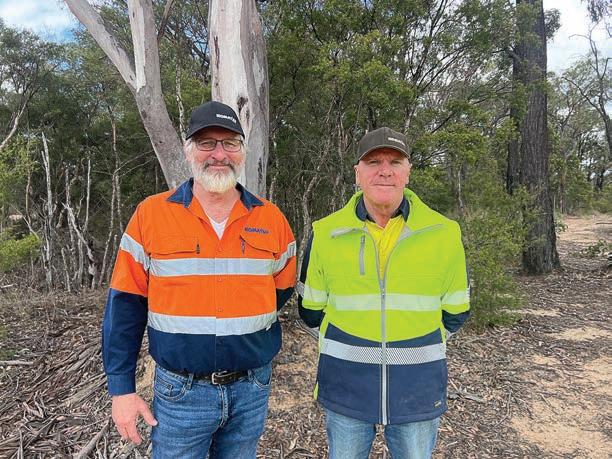
in manual mode, which works like a conventional power shift, or you can run the machine in auto mode, which has a lockup torque converter transmission,” Komatsu Australia national training manager for operator training Robert Missingham told Australian Mining
“In auto mode, the torque converter will be engaged in the first two gears to assist the operator, preventing engine stalling and improving productivity.”
Best suited for haul trucks that hold capacity between 90–240 tonnes, the GD955-7 grader also has great fingertip control and a palm steer option, with the fingertip control levers next to the operator seat.
“By incorporating short lever throws, the operator can use multiple controls

People may be operating these graders for up to 12 hours, so comfort was an important factor in the machine’s design,” Missingham said.
Operators have told Komatsu that the GD955-7 grader provides great visibility to its accompanying blade of 5.5m.
6.1m, further improving efficiency and productivity.
On top of that, the GD955-7 will also reduce downtime and associated maintenance costs for an operation through its bearing type circle feature.
“Most graders have slippers, which require a bit of adjustment,” Hall said.
there’s no ‘circle play adjustment’ required, it’s lubricated from the autolube system.
“Because of this, we expect a long service life from the bearing.”
Through its many benefits, it’s clear why Komatsu’s GD955-7 grader is set to become a mining favourite. AM

Johnson Industries Ltd., an ISO ��������� certified company, o�ers the most comprehensive range of industrial brakes and brake systems available from any single source worldwide.
Johnson designs and manufactures a range of products in-house, including heavy-duty hydraulic, pneumatic, electric, spring-set, or manually applied industrial brakes and brake systems. Our brake systems, which come with automatic lining wear adjustment, are utilized in every mining application, including Conveyor Brakes, Rail Clamps, Mine Hoists, and SAG Mills Mine
SSAB’S EXPANDABLE ROCK BOLTS HAVE BEEN USED IN INTERNATIONAL MINES FOR YEARS. THE OEM IS NOW EXPANDING ITS OFFERING INTO AUSTRALIA.
Tunnelling deep into the ground to extract valuable ore can be a dangerous job. With this in mind, SSAB developed its expandable rock bolts (ERB) to help miners secure the rock roof and avoid harmful accidents when heading underground.
Through supplier Cimertex, metals mines in Portugal have been using SSAB ERB for several years and have found that no other bolts can match up.
“From our experience with mining and tunnelling, we looked for the best quality ERB available to distribute and contacted SSAB,” Cimertex executive director Álvaro Bastos said.
“Our SSAB ERBs are by far the market leaders because of quality and logistics.”
A primary feature of the SSAB ERB is how quickly the bolts can be installed. Once a hole is drilled, the folded rock bolt can be inserted and expanded with water from a high-pressure pump.
As soon as the bolt is expanded, it is squeezed against the rock, which means operators don’t have to wait for any grout or resin to harden. It also means operators don’t have to work with dangerous chemicals contained in resins or grout.
The pure steel bolts can also remain in the rock without contributing negatively to the natural environment.

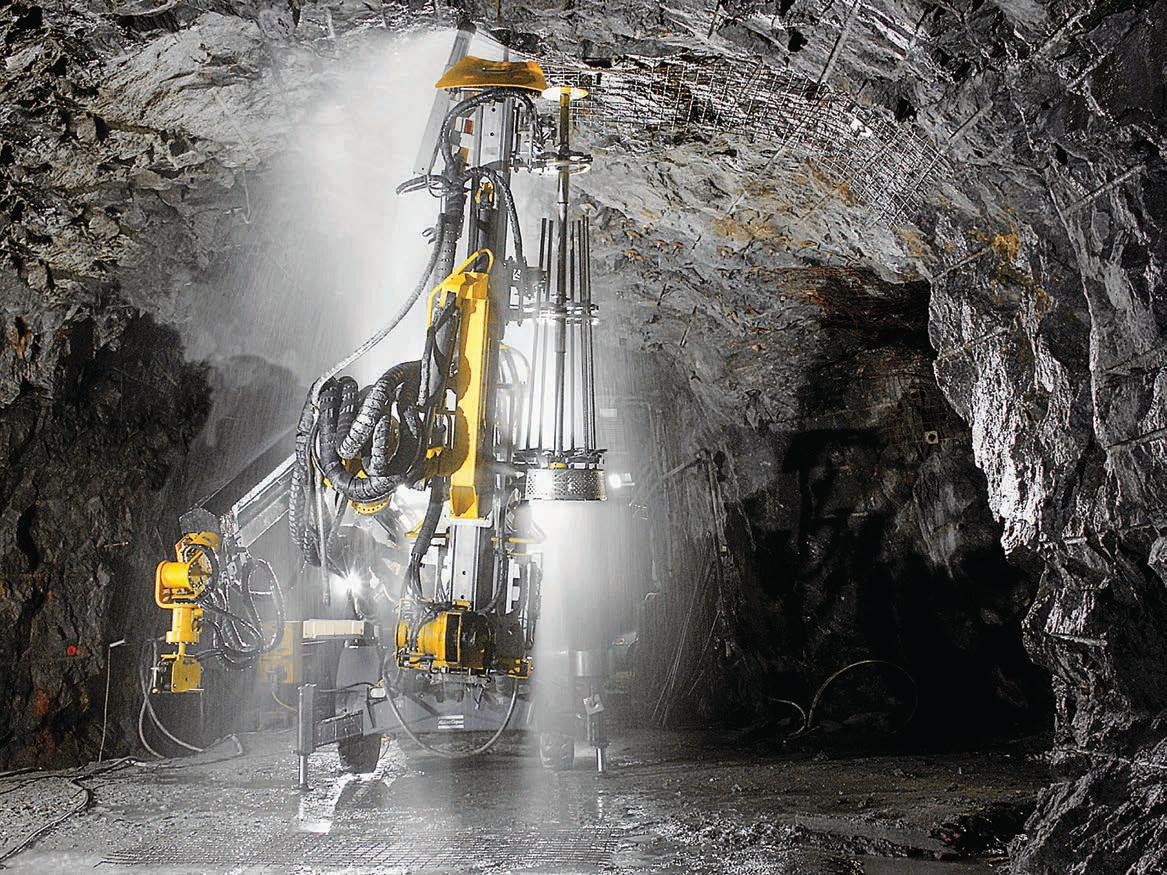
“There are just four easy steps to securing the SSAB ERB,” SSAB said.
“First, the hole is drilled to a necessary length. Then, the bolt is inserted and a pressure pump is attached to expand the pipe. Finally, the pump is removed and the rock is secured.”
SSAB ERBs have been reliable tools for Somincor, the company that operates the Neves-Corvo underground copperzinc mine in Portugal.
“SSAB ERBs fit our needs regarding our safety standards and the fact that we do not feel the necessity of change, because operational and performance issues prove that this support has been fulfilling our operational requirements,” Somincor head of rock mechanics Rodolfo Machado said.
“The fact that the industry is moving in a sustainable direction also speaks strongly for this technology.”
SSAB controls the entire production chain of the SSAB ERBs, meaning the product is always trustworthy and stable.
“Each production stage from steel manufacturing to profiling and assembling of rock bolts is covered by SSAB’s own production and quality control chain,” SSAB said.
“Each individual bolt is marked with a unique code, which enables full traceability.”
SSAB ERBs are employed in mines all over the world, including at the Jokisivu gold mine in Finland.
Dragon Mining, the company that operates Jokisivu, is currently mining at a depth of 645m and trusts SSAB ERBs with its rock support.
“We prefer inflatable bolts instead of split set bolts due to availability issues of split-set in the Nordic region,” Jokisivu mine manager Timo Ridaskoski said.
“It’s also easier to run one bolting system rather than two. We can get the bolts directly from SSAB in Sweden, which secures our supply of bolts.”
An innovative concept, the SSAB ERBs feature high-quality Nordic
steel and guarantee a minimum breaking load.
The bolts also go through eddy current non-destructive testing, inflation tests and flattening tests to ensure they are safe to use.
SSAB explained exactly how the ERBs work.
“The bolt forms a mechanical interlock between the borehole wall and the bolt over the full bolt length,” the company said.
“When the SSAB ERB is inflated it also contracts in the bolt length, which effectively tensions the bolt’s face plate against the rock surface.
“The rock bolts are designed to accommodate large rock movements and still maintain their high load-bearing capacity. SSAB ERB is suitable for both manual and mechanised installation.”
Having been used by miners across the globe for decades, SSAB is excited to bring this offering to the Australian mining industry. AM
Supporting overhead crane owners and operators in the mining sector to improve the safety, integrity, and compliance of their operations with expert asset management and specialist inspection services:
• Major inspections
• Third party inspections
• Runway inspections
• General crane maintenance services.
Visit www.altradsparrows.com



HAVING SERVICED THE AUSTRALIAN MINING INDUSTRY FOR OVER 20 YEARS, CANADIAN INDUSTRIAL BRAKE OEM JOHNSON INDUSTRIES HAS PLANS TO ESTABLISH A PERMANENT AUSTRALIAN PRESENCE.
Quality is the name of the game in an industry hauling million-tonne payloads every year.
Operators need to know their equipment can keep up with the demands of the harsh environments synonymous with the Australian mining sector.
Enter Johnson Industries.
“We strive to make our products last, especially in the mining environment,” Johnson head of sales Gil Sondraal told Australian Mining. “Taking a look at the industries we deal with – mining is number one.”
After more than 20 years in the Australian market, Johnson is keen to go one better – establishing a specialised local service offering for its Australian customers.
“We want someone on the ground in Australia who has a mechanical and electrical background,” Sondraal said. “Someone who is familiar with what our clients need and can make sure it’s done correctly.”
The world of mining equipment is highly niche, and maintenance requires specialised knowledge across a range of areas, particularly for industrial brakes.
According to Sondraal, things don’t always go to plan.
“We’ve had cases where a third party has taken apart a brake and put the springs back together wrong,” he said. “Suddenly, the customer isn’t getting the torque they expected, or they think our brakes aren’t working properly.
“They’re not working because they weren’t repaired correctly. That’s why we need to offer a Johnson-approved maintenance solution that eliminates the need for an unknown third party.”
Sondraal said Johnson brakes are designed to operate in harsh and dusty mining environments with minimal maintenance. The OEM aims to consistently upgrade its offering to improve reliability, reduce maintenance and simplify service and adjustments.
In a modern mining industry where operations run around the clock, downtime is the enemy. Johnson’s goal is to eliminate all downtime caused by the brake system.

“Our goal is to optimise our brakes as much as possible,” Sondraal said.
“Whether that be a feature like double seals or a drain port, our mission is to make the product last as long as possible for the customer.
“We always say if we can make a break that requires no maintenance –that’s the optimal brake. And when we do need to do maintenance, we prioritise minimising downtime.”
Johnson’s primary offerings within the Australian mining industry are conveyor brake systems, and lever brakes for ball,
semi-autogenous grinding (SAG), and autogenous grinding (AG) mills.
In fact, the OEM has been supporting the mining industry with conveyor brake solutions for over 40 years.
Johnson manufactures brakes for everything from small transfer conveyors to large downhill conveyors, supplying full programmable logic control (PLC) with power monitoring.
Johnson’s conveyor brakes feature changeable, on-the-fly deceleration functions for various loading conditions. Operators can also work with the



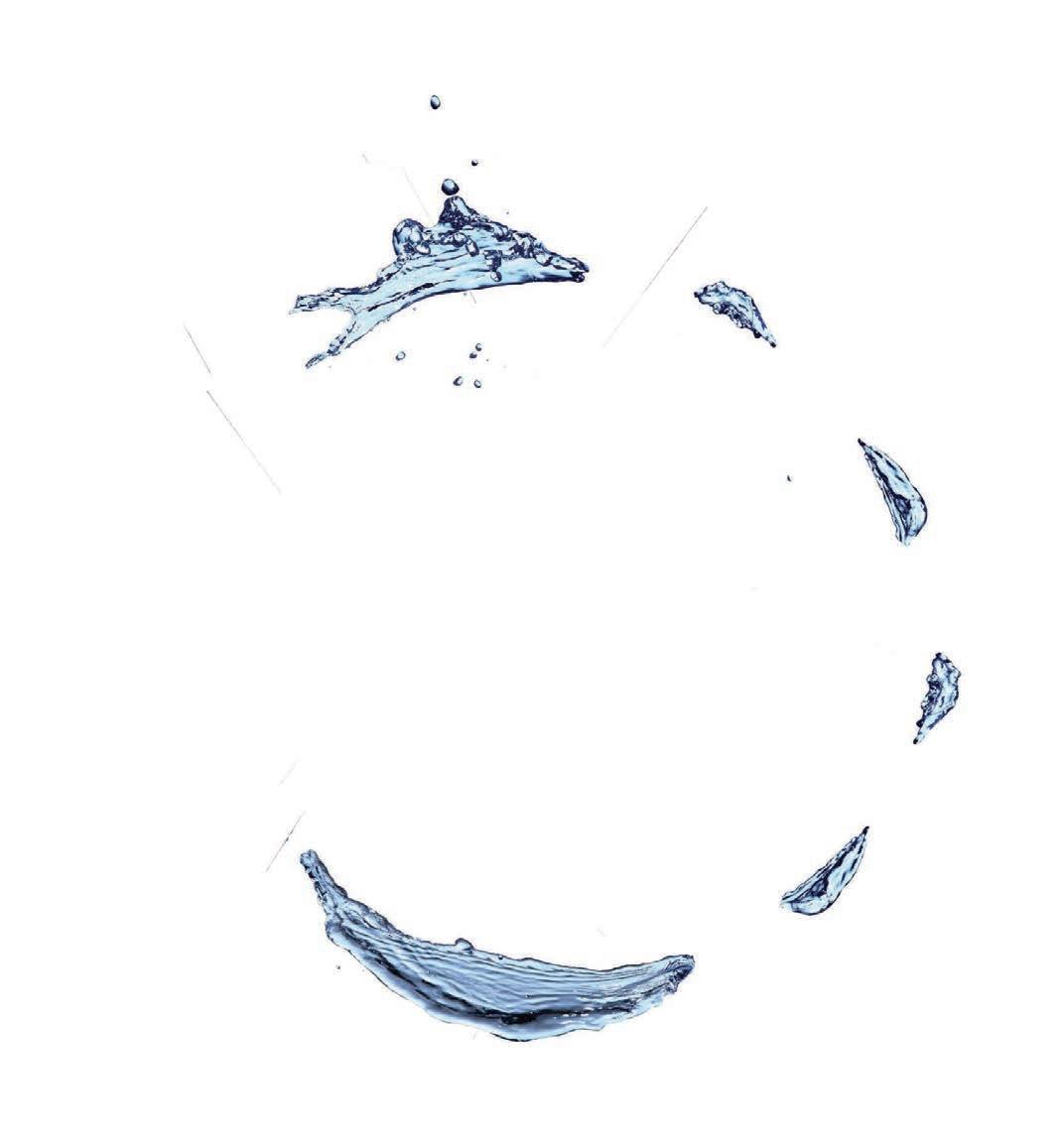
Biodegradable (>95%)

Water hardness up to 42°dH
Improved filterability
High corrosion protection
Approved by OEM
AFTER A MONTHS-LONG TAKEOVER PROCESS, US GOLD GIANT NEWMONT HAS FINALLY ACQUIRED AUSTRALIAN GOLD MINER NEWCREST MINING FOR $26.2 BILLION.
Since February 5, the global mining industry has watched Newmont work to acquire Newcrest.
With the acquisition implemented on November 6, Australian Mining takes a closer look at how the multi-billiondollar deal came to be.
Newmont’s February offer would have entitled Newcrest shareholders to receive 0.380 Newmont shares for each Newcrest share.
“We believe a combination of Newmont and Newcrest presents a powerful value proposition to our respective shareholders, workforce and the communities in which we operate,” Newmont president and chief executive officer Tom Palmer said at the time.
“The proposed transaction would join industry-leading portfolios of assets and projects to create long-term value across the combined global business, and we welcome the consideration of Newcrest’s board of directors.”
Almost two weeks later, the Newcrest board unanimously rejected Newmont’s $24.45 billion offer.
“The board has considered the indicative proposal and has unanimously determined to reject the offer as it does not represent sufficient value for Newcrest shareholders,” Newcrest said.
A week after Newcrest’s rejection, Palmer expressed his disappointment.
“If we can reach an agreement, this combination of industry-leading talent and decades of collective experience would create significant value across the global business with an ideal mix of gold and copper,” he said.
Following weeks of silence, Newmont and Newcrest made plans in March to have an in-person meeting to discuss a path forward.
This gave Newcrest a chance to explain its reasons for turning down Newmont’s initial offer and what level of offer the board would consider worthy.
After the meeting, Newmont raised its takeover bid to $29.4 billion in April. Under the revised offer, Newcrest shareholders would receive 0.4 Newmont shares for each Newcrest share held, with an implied value of $32.87 per share. Newmont labelled this offer as “best and final”.
Less than a week later, Newcrest entered into an exclusivity deed with Newmont, satisfying a condition of Newmont’s proposal.
THE TELFER MINE IN WA IS AMONG AUSTRALIA’S LARGEST GOLD MINING OPERATIONS.

where more than 96 per cent of the votes
October 18 and Newcrest ceased trading



CAPS offers mine-spec skid packages as standard to better accommodate safety and performance in extreme conditions.


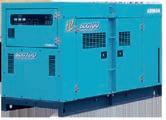
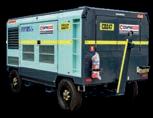
Time-proven, quality tools specially designed for assembly, industrial and vehicle service.

Ingersoll Rand, CAPS, and Hertz brand electric compressors available as oilflooded or oil-free.

Mine-spec AIRMAN portable diesel air compressors and power generators, air treatment, and specialist equipment.
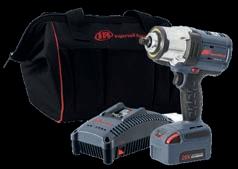
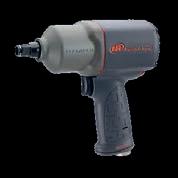
24/7 service nationwide for maintenance and emergency breakdowns.
TECHNOLOGY ENABLES COMPANIES TO LOOK AT THE BIG PICTURE WHEN ASSESSING A PROJECT’S HYDROLOGY
Amining company plans a new project in an area prone to occasional cyclones and flooding. Through land-surface hydrology, the company wants to model flood events and the likely run-off at the proposed mine.
As part of its environmental, social and governance (ESG) focus, the company seeks to understand how a tailings dam would respond to a large rainfall event, as well as any potential risks to nearby waterways and vegetation. It also wants to know if cyclones could affect slope stability and

earth movement at the project’s location.
In addition, the company wants to model day-to-day water received at the mine through precipitation and water lost through evaporation and its run-off from land, then account for a changing water balance over time and its impact on soil moisture, vegetation and waterways.
According to SRK Consulting principal consultant (hydrogeology) Ian Sutton, companies are increasingly using high-resolution satellite imagery data to help model these types of hydrological risks at mines in Australia and overseas.
“The technology is becoming more powerful and the data are becoming more accessible,” he said. “Satellite imaging provides a layer of information that complements data from in-situ remote sensors at mines.”
Sutton, an expert in satellite data processing for hydrology at mines, believes climate change will encourage greater uptake of this technology.
“As the frequency of natural disasters increases, mining companies need to use the latest satellite tools and data available to them to better understand the movement and distribution of water at their project,” he said.
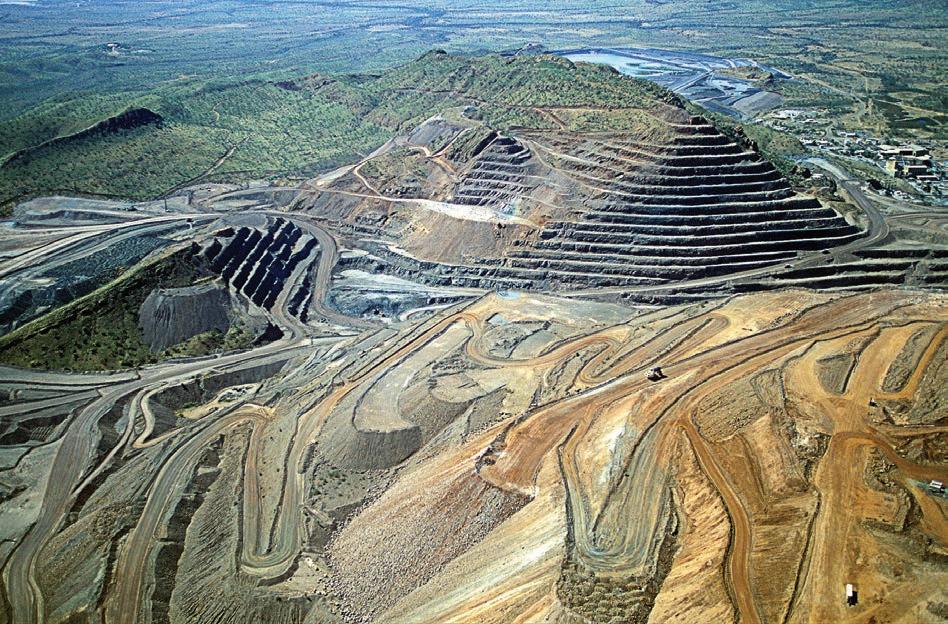
“A company planning a mine in an arid area can use satellite-derived data to better understand past rainfall patterns. The data can help it assess how the land responded to previous drought conditions.”
A greater focus on ESG risk across the mining industry is also driving greater uptake.
“Understanding how water runs off from a mine is critical to helping protect nearby waterways, vegetation and communities,” Sutton said. “Combining satellite imagery with data from in-situ remote sensors at a project is important to understanding and managing these risks.
“In the past, you’d monitor data from a small number of sensors at a mine to assess water run-off and its impact. Today, we can use satellite imaging to look at a much larger area over a longer period.
“If a cyclone passes through the area, we have a visual record of the extent of flooding, how quickly the water recedes, evaporation rates, and where water discharge goes.
“Satellite imaging data allow us to observe these hydrological patterns in greater detail.”
Assessing hydrology at other mines is another advantage. For example, a company planning a mine in an area with several established sites could use satellite imaging to assess broader hydrological risks.
“Satellite imaging enables companies to look at the big picture in hydrology, not just at their mine through in-situ sensors in the ground,” Sutton said.
While many industries use highresolution satellite imagery to provide data, the global mining industry had been relatively slow to adopt the technology.
Sutton attributes this to a lack of awareness of its broad range of benefits.
“Not enough people sufficiently understand how this technology can aid mining projects,” he said. “They may not realise how powerful these data are becoming or how they can be used across the full breadth of mining, from exploration to mine closure.”
In exploration, satellite imaging can help companies understand changes resulting from alteration and mineralisation; in mine planning, companies can use satellite data to
model run-off and slope stability; in mine closure, satellite imaging can allow companies to monitor how an inactive tailings dam responds to weather events and the effect on the nearby environment.
“Satellite data have many applications in mining,” Sutton said. “We can bounce satellite signals off markers on a mine site and measure the distance between the marker and the satellite to help quantify land displacement. Satellite signals can also penetrate cloud cover to measure changes in forest canopy and vegetation near a mine.”
Specialisation within mining is another factor for the lower uptake.
“You can get silos of expertise, where people in a particular field aren’t exposed to new ideas in another field,” Sutton said. “Satellite data can cut across the work of geotechnical engineers, tailings dam engineers, hydrogeologists and hydrologists.”
Sutton expects the use of satellite imaging in mining to accelerate in the coming decade as the technology advances.
“Data analysis from satellite imaging
COMPANIES ARE INCREASINGLY USING SATELLITE IMAGERY TO MODEL HYDROLOGICAL RISKS ON MINE SITES.

into space.
“Within a decade, data satellite imaging will be a standard input for
SRK Consulting is a leading, independent international consultancy that advises clients mainly in the earth and water resource industries. Its mining services range from exploration to mine closure. SRK experts are leaders in fields such as due diligence, technical studies, mine waste and water management, permitting, and mine rehabilitation. To learn more about SRK Consulting, visit www.srk.com

1. BE OPEN-MINDED – understand how satellite data can be used across the full spectrum of mining operations to aid mine planning and closure risk management, and exploit opportunities in exploration.
2. UNDERSTAND WHAT IS AVAILABLE – tools range from open-source, free data on satellite imagery to high-resolution imagery from specialist providers. These technologies continue to add more features for similar cost, allowing mining companies to get more from these data.
3. RECOGNISE ITS ROLE IN RISK MANAGEMENT – using satellite images to build large datasets for your mine and nearby sites over long periods can aid in understanding risks to waterways and vegetation from groundwater run-off.
4. CLIMATE CHANGE – by providing another layer of information, satellite data can help mining companies respond to uncertainty from climate change, such as a higher frequency of cyclones, floods, droughts and other natural disasters.
5. COLLABORATION – satellite data can cut across various specialisations, so companies need to find ways to incorporate this information into different planning and monitoring areas at different stages of a project.
6. CAPABILITY – ensure your organisation has sufficient internal capability to harness and analyse data from satellite images, or access to external consultants who have demonstrated expertise in this area.
7. PROCESS – develop an internal process to build and maintain datasets from satellite images. Determine how the information will be recorded, stored and periodically reviewed and reported, and how it will complement data from in-situ remote sensors at a project.
8. COMMUNICATE – understand how satellite data could be used in community engagement programs or with other stakeholders; for example, to demonstrate water run-off patterns from a tailings dam during a large rainfall event.
9. SHARE LESSONS – where possible, contribute to industry knowledge and awareness. These lessons can help other mining companies use the technology to better understand and manage hydrology risks at their project, aiding communities and the environment.
SEMPERTRANS AIMS TO PROVIDE TAILORED SOLUTIONS FOR THE MINING INDUSTRY’S CONVEYOR BELT NEEDS.
Celebrating 10 years on Australian shores, Sempertrans draws upon decades of experience and an extensive reservoir of expertise to offer a diverse range of technologically advanced conveyor belts to the mining industry.
With products ranging from heavyduty textile to high-strength steel cord belts, the company places an emphasis on exceptional reliability and extended service life.
Sempertrans is part of the larger Semperit Group, which dates back nearly
200 years and operates across the globe.
“Sempertrans is one of five business entities within the Semperit group,” Sempertrans head of sales Scott Hancock told Australian Mining. “Our focus is on producing and supplying exceptional-quality conveyor belts, specialising in rubber products and services.”
Since Sempertrans took off in Australia in 2013, its goal has been to service all of the mining industry’s conveyor belt needs, transporting bulk materials including coal, iron ore, cement, sand, grains, and chemicals.
SEMPERTRANS DELIVERS CONVEYOR BELT ROLLS UP TO 45 TONNES.
With a focus on reliability, the company offers tailor-made solutions for any specialised conveying task.
“We’ve had major success in our specialised conveyor belts because we focus on premium performance and high-quality conveyor belt delivery to our customer,” Hancock said.
With plans to expand its footprint even further into the heavy steel cord conveyor belt space, Hancock said Sempertrans is primed to rise to any challenge the mining industry faces.
“That’s really our specialty,” he said. “Our production plants can produce belts up to 3.2m wide and 45mm thick, delivering rolls up to 45 tonnes.”
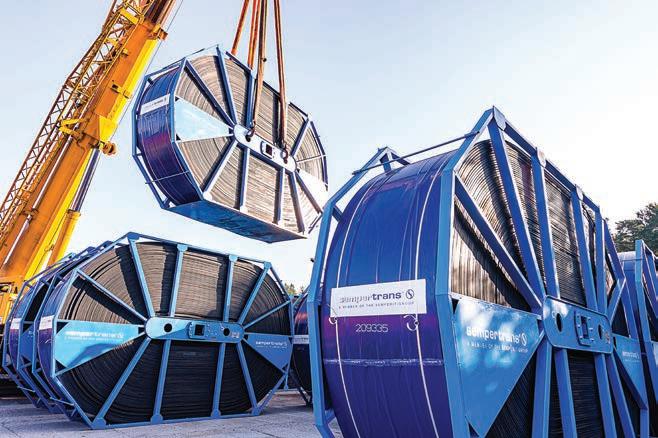
“We are one of the only manufacturers in the world producing steel cables in-house.
“We compound all the raw materials internally and once we manufacture the steel cables, we proceed to vulcanisation and completing the production of the conveyor belt.”
Sempertrans boasts the largest conveyor belt manufacturing facility in Europe, located in Poland, and produces heavy textile belts at its facility in India.
“We have two production facilities in India and Poland from which we can have complete control of our products from start to finish,” Hancock said. “We also compound all our own rubbers inhouse for the different cover grades we provide to our customers.”
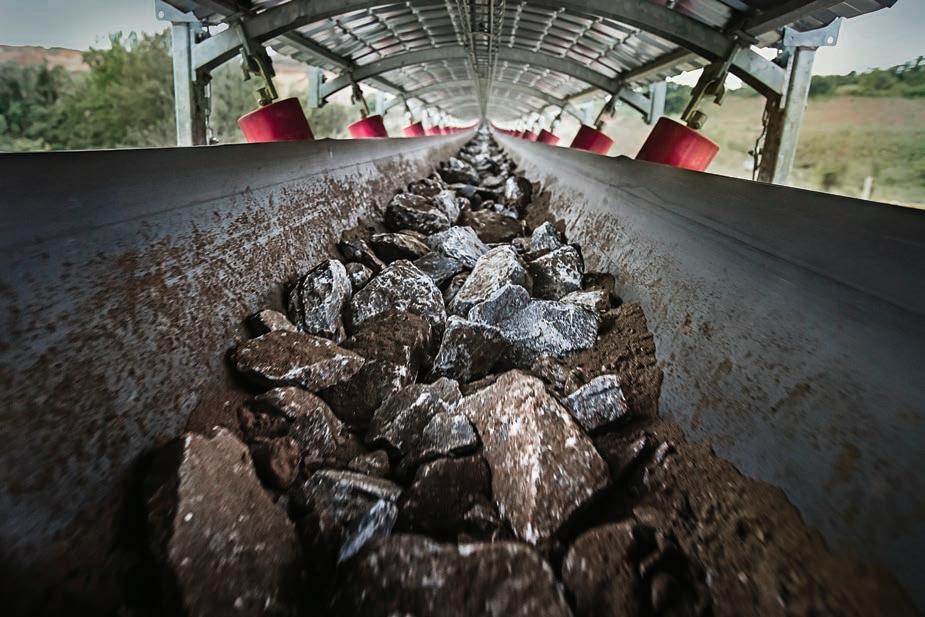

conveyor belt designs.
The goal is to enhance overall production plant efficiency and ensure the seamless installation of Sempertrans belts.
For an industry dealing with a diverse range of bulk materials, the company offers both textile and steel cable-reinforced conveyor belts, along with splicing kits and materials for installation, technical consulting, supervision, inspection, and training.
“We specialise in heavy applications,” Hancock said. “We have fire resistant, anti-static approval across our range, as well as other specialty products like Ripstop that provide the highest impact protection to the belt the industry has seen.
“Additionally, our Autostable belt solves misalignment issues and

reinforcement materials.
“We deliver high-performing conveyor belts for customers looking for reliability,” Hancock said. “We like to work closely with our customers to deliver a solution that benefits them.”
To offer tailored solutions, Sempertrans closely collaborates with its customers to understand the unique needs of an operation. The company’s knack for creativity and innovation does the rest.
“Sempertrans recently delivered a solution to a large mining operation in WA,” Hancock said. “We provided 18km of overland conveyor belt, and another kilometre of textile belts for their run-of-mine processing facility.
“We implemented our TransEvo ultra-low resistance conveyor belt, which delivers energy savings of up to 25 per cent for the lifetime of the belt.”
conveyor solution.
“That’s just one of the ways Sempertrans is able to reduce its carbon footprint,” Hancock said. “We’re mindful of meeting our customers’ needs but also looking at the environmental impact of conveyor belts.”
As the Australian mining industry enters an era focused on environmental, social and governance (ESG) and emissions reduction in the face of netzero targets, Sempertrans aims to carve out a space that refuses to compromise on either efficiency or the environment.

“The environment is a hot topic at the moment, not only in the mining industry, but worldwide,” Hancock said. “We’re looking at ways we can reduce our carbon footprint and provide those benefits to our customers.”
Hancock emphasised that reducing Sempertrans’ carbon footprint will
not only be done through developing products like the TransEvo range, but by also looking at internal ways the company as a whole can reduce its carbon footprint.
“We’re targeting energy consumption and waste reduction both internally and externally,” Hancock said. “We want to deliver a positive outcome for our customers, but we’re also living that same philosophy internally.”
It’s this kind of innovation, experience and customer-first focus that has galvanised Sempertrans as one of the world’s leading suppliers in the conveyor belt industry.
“Any manufacturer can make conveyor belts to a certain specification,” Hancock said. “But we want to do provide tailored, high-performing belts that deliver optimal performance and results for our customers.” AM

RECENT PROJECT AT WHITEHAVEN COAL’S MAULES CREEK COAL MINE HAS SEEN CUMMINS REPOWER
FLEET OF HITACHI HAUL TRUCKS WITH 2000HP CUMMINS QSK50 MCRS ENGINES. REPOWERED EH5000
Reduced maintenance costs and quality service support are the key reasons Whitehaven is repowering five Hitachi EH3500 haul trucks with 2000hp Cummins QSK50 MCRS engines.
The original engines in the EH3500s, from another manufacturer, are being replaced while Hitachi carries out a 32,000-hour refurbishment program on the trucks at its facility in Gunnedah, New South Wales.
The repower project is set to be completed in early 2024.
The repowered trucks, which have a gross weight rating of 322 tonnes carrying a 181-tonne payload, are working at Whitehaven’s Maules Creek mine near Gunnedah, which has annual production approval for 13-milliontonne (Mt) run-of-mine (ROM) coal.
Whitehaven, noted for producing high-quality thermal and metallurgical coal, has four operating mines in the Gunnedah Basin which achieved ROM production of 18.2Mt in 2023. More than 100 high-horsepower Cummins engines are involved in its three opencut operations.
Whitehaven recently announced its plan to buy two major Queensland coal mines from BHP – Daunia and Blackwater – in a multi-billion-dollar deal that will transform it into a leading supplier of metallurgical coal for export markets with pro-forma, ROM production of around 40Mtpa.
Cummins’ involvement in the Maules Creek operation – currently Whitehaven’s largest mine, which shipped its first coal in 2015 – is significant, with 61 engines in service. These are a mix of QSK50 MCRS and QSK60 MCRS powerhouses spanning
1944–2850hp, all certified to Tier 2 emissions level.
These engines are powering a range of Hitachi equipment, including 45 ultra-class EH5000 haul trucks with a 296-tonne payload and five 800-tonne EX8000 excavators.
Maules Creek is the first mine in the world to implement Hitachi’s autonomous haul truck system. Two autonomous Hitachi excavators are also operating at the mine.
“We’ve had a long, healthy relationship with Cummins,” Whitehaven’s Maules Creek maintenance manager Mark Irwin said.
“We’re familiar with the Cummins product and we get high-quality support, so when the opportunity arose to increase the Cummins footprint at Maules Creek, we jumped at it.
“We can log issues with Cummins and we’re confident those issues will be
addressed. There’s a fair bit of comfort in that.”
Cummins Tamworth’s on-site support at Maules Creek is headed up by Phil U’Ren, who is also leading the repower project, a global first for Hitachi and Cummins in that there has been no previous QSK50 repower experience with the EH3500.
“We’ve worked closely with Hitachi on the design, installation and commissioning and it has proved a very successful project,” U’Ren said. “We had to compile a significant parts list and some parts had to be manufactured by Hitachi in Japan specifically for the project.”
When Cummins first got involved in the Maules Creek project during the tender stage, Whitehaven Coal emphasised that the mine had a low-cost business model and total cost of ownership

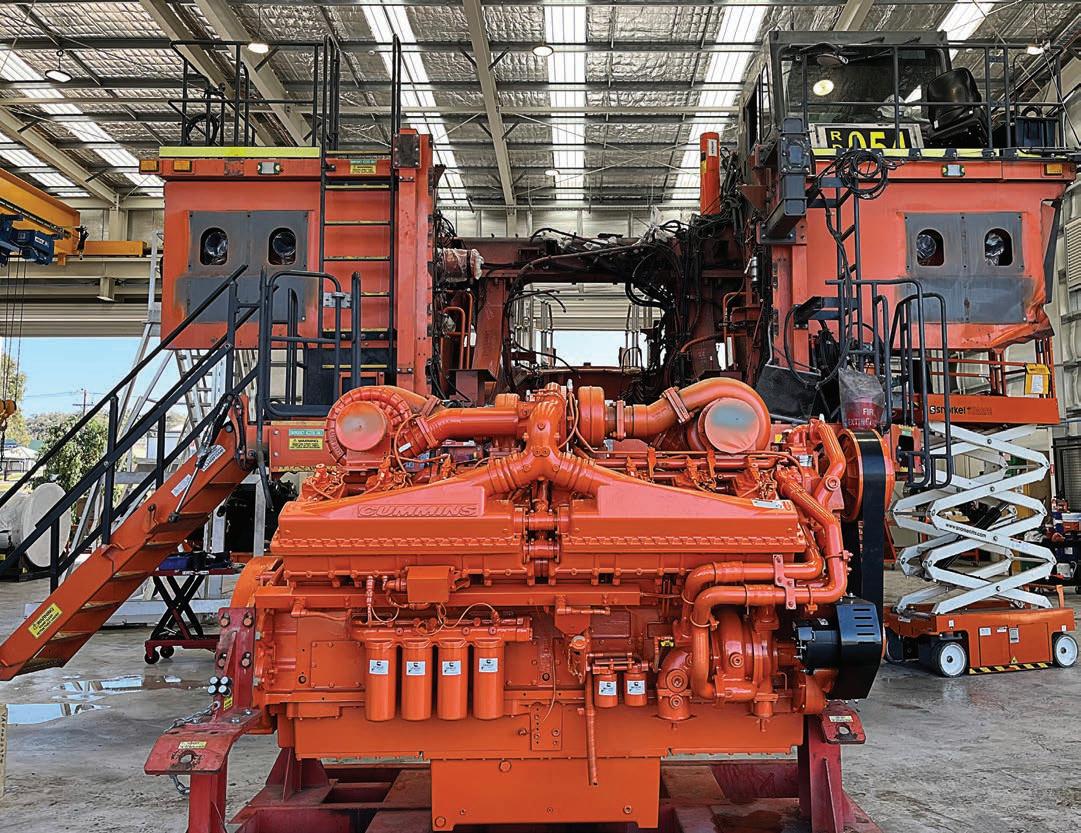
and that lines up with the second changeout of their hydraulic pumps for the life of the engine.”
for the trucks, collaboration resulted in one engine change-out and one midlife being eliminated from the 90,000–100,000-hour life of the chassis.
All of the engines at Maules Creek incorporate Cummins’ high-pressure modular common rail fuel system (MCRS) technology for longer life-tooverhaul and reduced fuel consumption and emissions.
“We had high expectations from the start based on our conversations with Cummins and those expectations are being met,” Irwin said.
Irwin pointed out that the life-tooverhaul “starting point” for the QSK50 is 32,000 hours. His experience at another mine site is that 35,000 hours can be “comfortably” achieved with the 50-litre, V16 Cummins in the EH3500.
But discussing life-to-overhaul of the QSK60 rated at 2850hp in the 500-tonne EH5000, Irwin revealed 32,000 hours are being achieved comfortably at Maules Creek, and that “we’re exploring pushing that out further”.
“We have to make sure these hours line up with the rest of our maintenance strategies,” he said. “For example, we do a QSK60 change-out at 24,000 hours in the EX8000 excavators
Minimal midlife component changeout is another major cost reduction benefit with the QSK50 and QSK60. The MCRS fuel injectors are achieving full engine life.
“We have over two million hours’ experience with our EH5000 fleet and in that time there has only been singledigit injector replacement before life,” Irwin said. “The MCRS injectors are extremely reliable.”
Low-emission engines are a key requirement at Maules Creek, which operates under strict environmental standards. It is for that reason that all the Cummins engines are Tier 2 emissions compliant.
A fuel consumption improvement in excess of three per cent is calculated for the QSK50 over the engine it replaces in the EH3500, and this results in a significant greenhouse gas reduction for a truck doing 5000–6000 hours a year.
Another key benefit of repowering with Cummins is the availability of its remote engine monitoring system, PrevenTech, which is connected to all Cumminspowered trucks and excavators at Whitehaven mines.
PrevenTech works by applying connectivity, algorithms and analytics to a machine’s engine hardware, helping a mine identify and diagnose issues faster and more accurately. It works with Internet of Things (IoT) technology and
events,” he said. “The machines were diagnosed and then repaired in a short period so as not to interrupt production.
“Anything that helps us get ahead of issues is important. We’ve gone from looking in the rearview mirror to learn from the past, to looking forward and making informed decisions with the realtime data we’re getting from PrevenTech.

“In other words, we’re now being more proactive and less reactive with our maintenance practices and that means reduced operational and maintenance costs.” AM
LIGHT BUT STRONG, THE SCHLAM HEX TILE SYSTEM IS A SMART WEAR PROTECTION SOLUTION THAT OFFERS MINERS IMPROVED PAYLOAD PRODUCTIVITY, ASSET LIFE AND SAFETY.
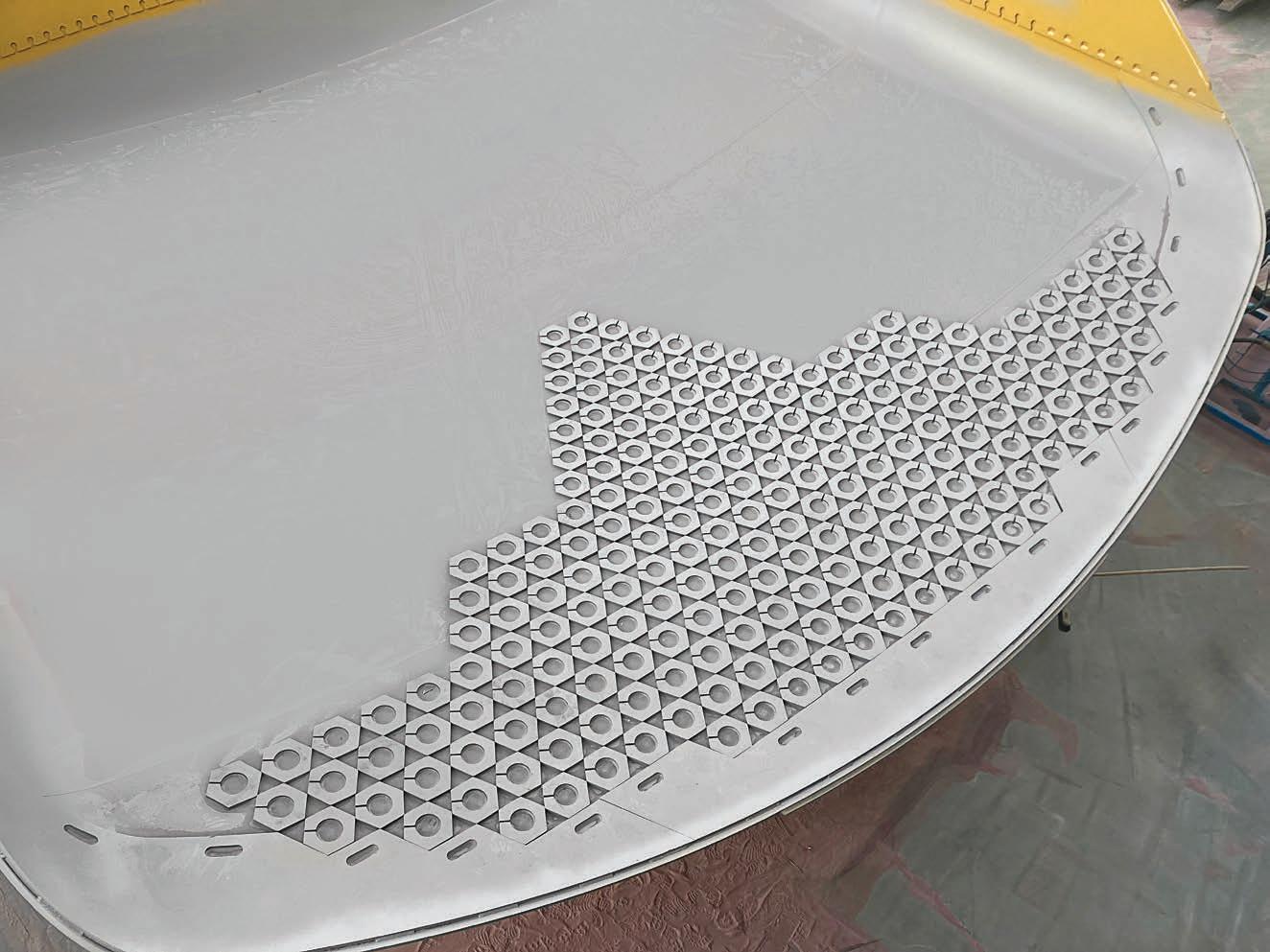
Miners continually face the challenges presented by the effects of wear and impact, especially those operating in hard rock mining environments.
Hard ores and abrasive dirt can cause unplanned damage to both fixed and mobile plant equipment, causing unnecessary downtime and affecting mining productivity.
With an industry focus on increasing productivity and asset longevity, selecting the right wear solution has never been more important for miners in Australia.
Beyond traditional wear plate solutions, miners are now afforded the choice of a range of alternative wear protection products, including the Hex Tile from Schlam.
The Schlam Hex Tile system offers miners an innovative way to protect their valuable plant equipment, especially open-pit dump bodies, while also providing additional benefits in maintenance and downtime, payload productivity and safety.
Wear and impact protection
Conventional wear plate systems add unwanted weight to haul trucks, reducing payload capacity. The patented design of the Schlam Hex Tile, invented by the same people behind the Hercules open-cut dump body, evolved from the challenge of providing miners with a lighter wear solution to minimise the effect on payload performance.
Schlam Hex Tiles can easily be applied to any dump truck body. They are hexagonal in shape and measure in at 250mm, offering in thicknesses of 12, 16, 20 and 25mm. Customers can choose from two steel grades – GR450 and GR500.
The hollow centre of the Schlam Hex Tile enables the weight of the tile to be reduced without affecting wear performance – the popular 20mm and 25mm size variants weigh 4.6kg and 5.8kg, respectively.
“Schlam Hex Tiles provide miners with a wear solution that is at least 48 per cent lighter than traditional wear plate,” Schlam general manager – sales and business development Ben Baker told Australian Mining
A recent installation of 20mm Hex Tiles on a large fleet of opencut dump bodies on Australia’s east coast resulted in a 2.5-tonne weight saving per body, representing a payload advantage of more than one per cent.
“While one per cent may not sound like much, over weeks and months, and across multiple assets, this adds up to a significant gain in payload capacity,” Baker said.
“When you also consider the other operational benefits, including fuel savings, reduced downtime and the need for less people and equipment, the Schlam Hex Tile becomes an economically viable wear protection solution.”
The Schlam Hex Tile has been designed to be applied only to the areas that need to be protected.
While conventional wear plates are generally applied to the entire width of the body, each Schlam Hex Tile is applied using a detailed wear map that determines the exact location and thickness of the protection required.
The tiles are then applied in incremental stages to control body weight.
This high level of precision is why the Schlam Hex Tile system is recognised by many as an innovative wear solution that ensures dump bodies maintain their light weight and structural integrity throughout their operating life.
WHILE ONE PER CENT MAY NOT SOUND LIKE MUCH, OVER WEEKS AND MONTHS, AND ACROSS MULTIPLE ASSETS, THIS ADDS UP TO A SIGNIFICANT GAIN IN PAYLOAD CAPACITY.”
“When we conduct body thickness tests on-site, it’s not uncommon to see a particular area of a dump body experiencing greater wear,” Baker said.
“The beauty of the Schlam Hex Tile is that we can ‘zone in’ and protect that spot alone.”
Being lighter and smaller, Schlam Hex Tiles are easier to install than traditional wear plates.
Cranage time is greatly reduced with Schlam Hex Tiles, as a pack of tiles can be easily positioned onto the centre of a dump body with a single forklift.
Larger wear plate installations usually require multiple crane lifts to move plates into position, with waiting periods usually experienced as plates are lifted, positioned and welded into position.
Schlam Hex Tiles are typically welded onto the dump body floor using a weld inside the perimeter of the internal circle. This not only provides a secure bond but also makes future tile replacement easier.
The small size of the Schlam Hex Tile helps to eliminate the risk of injury caused by stored energy in traditional wear plates.
And the fact each tile is no more than 6kg in weight makes them easier to handle, in turn making application to any dump body more straightforward.
Reduced maintenance time
Once applied, maintenance of Schlam Hex Tiles can be undertaken during routine mechanical services. Only the tiles that need changing are replaced –compared to wear plate solutions where complete panels are replaced.

downtime and maintenance costs, as well as exposure to safety risks.
“Dump bodies with large worn wear plates are usually parked up for long periods, with a crew cutting out the
process is quicker, meaning the dump truck can go back into operation sooner.”
Improved
With a lower point of friction, Schlam

Dislodged wear plates can cause crusher blockages, which affect upstream and downstream mining productivity. Being much smaller than wear plates, Schlam Hex Tiles also offer a lower risk of crusher blockages.
Fixed plant and bucket applications
While Schlam Hex Tiles were originally designed to protect dump truck bodies, they are also increasingly being used to protect areas of mining buckets experiencing high rates of wear.
Some Schlam Hex Tiles have also been applied to fixed plant equipment, including ore chutes with limited space and access.
A supportive team
Schlam’s technical specialists assist customers in overcoming their wear and impact challenges. With a wealth of engineering and maintenance experience, the team provides customers with an on-site wear measurement service to determine and quantify wear and impact issues.
Information gained is then used to develop a wear map and wear protection system, which can be supplied to customers on-site.
The Schlam Hex Tile system provides miners a range of benefits beyond those offered by traditional wear packages.
With improved payload capacity, reduced downtime and a reduction in safety risks, the Schlam Hex Tile system is a wear management option that also offers significant financial benefits, including a short payback period. AM
AAA TRAILERS IS COMMITTED TO DELIVERING QUALITY SERVICE TO ITS CUSTOMERS WHILE SLASHING WAIT TIMES ON ITS PRODUCTS.
In a rapidly changing mining industry, staying on the cuttingedge of customer needs with timely product releases is key to carving out a niche in the sector. While suppliers can have longer wait times amid assembling and shipping downtime, AAA Trailers prides itself on being a dynamic supplier from its range of sales branches across Australia.
“We are the only supplier in Australia that actually has excellent quantities of stock on hand, ready to go,” AAA Trailers director Daniel Bull told Australian Mining. “We can deliver within three-to-five working days or one to two weeks if custom work is involved, so customers can hit the ground running.”
Setting its sights on expansion, Bull said the company is currently one of the biggest suppliers in Australia, with plans to become number one.
“We’re one of Australia’s major suppliers of low loaders, side tippers and watercarts,” Bull said. “Our goal is to supply quality trailers as quickly and
“We need to be where the customers are,” he said. “We want to be the local they can come have a chat with.”
Bull emphasised that having boots on the ground is essential to AAA Trailers’ approach to working with its customers to ensure satisfaction.
“If a customer has an idea for a muchneeded new trailer design, we’ll get it done,” Bull said. “We follow up with our customers and we are always here to help. We’re here to work with our customers to make our products even better.”
Released in November, AAA Trailers’ newest addition is its 45-foot drop deck quad-axle widener with bi-fold ramps, which Bull said is part of plans for an expanded range of three different quadaxle low loader trailers with aggregate trailer mass ratings of 60 tonnes.
The new trailer features full SAF airbag suspension and SAF-Holland axles, the latest electronic braking system, rear-axle steering, and frontaxle lifting for easy manoeuvring around tight areas. The deck sits at a low 900mm off the ground, which allows for
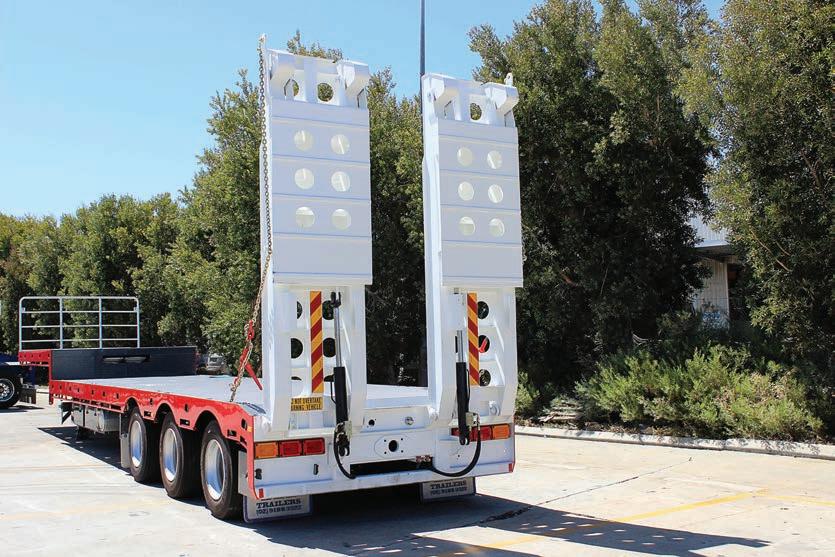
Bull saw a demand for smaller trailers that can handle heavier payloads on mine sites and sought to supply a solution customers could take advantage of immediately.
“Similar trailers from competitors have wait times of up to four years,” he said. “We designed, engineered and built our new quad-axle in under four months,
footprint and heavier load-carrying ability is required.
“With the way the axles are spread, customers will be able to carry their weight load a lot more evenly across the deck compared to standard tri-axle trailers,” Bull said.
With belts tightening across the country, Bull emphasised the cost-


Sempertrans TransFlam AS-S FLAME RETARDANT COVER RANGE FOR UNCOMPROMISING SAFETY

Why TRANSFLAM AS-S?
Certified fire resistance & flame protection
Meets Australian standards 4606
Enhanced abrasion & impact resistance
Cost-effective solution for all conveying needs
Exceeds safety standards for FRAS belts
Ican recall the day I attended the house where a 14-yearold girl committed suicide in the bathroom while her parents sat on the balcony on their phones. The parents were heavily engaged in somebody else’s life while unaware of the dangers lurking in their own home. This is not an isolated case.”
Through his business, the WakeUp Call, Paul Spinks helps provide employees with tools to spot cracks in their physical and mental health.
“Suicide statistics continue to rise in Australia with around 3500 deaths a year, 65,000 attempts and many more at any given time who are spiralling and don’t even realise. Chances are, I’m talking about someone in your family,” Spinks said.
“We’ve got to be mindful that suicide is the end of the line. It begins with ailing mental health, so we’ve got a huge opportunity to catch it and to do that we firstly need to consider how well we are received by those we are trying to reach.
“I think as human beings we should possess the very basic ability to know how to reach out and talk to others, but we are losing this skill at a frightening pace. Many people come up at the end of my conferences and say that they’ve lost the ability to communicate effectively with a friend, their parents or worst of all, their kids.
like ‘best parts, worse parts, what did you learn today?’ or ‘best parts, worse parts, what worries you the most?’ are a great way to stimulate good discussion. Just make sure you don’t miss your turn


our mental health messages into one day given it’s a 365-day-a-year problem.
“The next level up from this is the employee assistance programs (EAP) that workplaces have in place. Trouble is, these programs are almost always reactive instead of proactive. It surprises me how often staff have no idea who their EAP provider is.
“Mental health first aid providers are another great initiative, but you need to make sure you’re right first before you try and help others.
“And then there is the gold standard to strive for, the people that can reach others naturally without any titles or bright coloured shirts. Those that we trust the most. These are the heroes among our work communities and what needs cultivating in the workplace.”
How worthy is your conversation?
Listen for one moment to people’s conversation. Everybody is critiquing somebody, which means that everybody is also critiquing you. Imagine if we had access to that information?
“The good news is we can just give somebody the permission to tell it how it is. Ask them: how am I doing? What
are my hang-ups? What behaviours are annoying?” Spinks said. “You can learn so much about yourself if you don’t get upset by somebody’s honesty. A great place to start is with your kids.
“To communicate this point in a seminar environment, I ask the audience if anybody knows a tosser in the room. Everybody laughs at this, of course, because everybody knows one. But what happens if the tosser is you? Wouldn’t you want to know?
“Having established the right relationship with yourself, we are now ready for the next step.”
The best way to do this, Spinks said, is to be vulnerable.
“How do you expect somebody to be vulnerable with you if you’re not vulnerable with them first?” Spinks said.
“To accomplish this with my audience, I share vulnerable stories of my life, like the time I went for a medical examination for my commercial pilot license when I was 16.
“The doctor tells me to take my clothes off. So I take off my pants and I’m standing there in front of him and then he says, ‘No, Paul, take your underwear off as well’. Now I’m standing there stark naked, concerned and somewhat afraid. Then he asks me a series of sexually explicit questions, which I reveal to the audience.

“I was only 16 – what was I supposed to do? Things only go south from there; I hop onto his consultation table and the rest is history. That doctor is now a convicted paedophile behind bars.
“And that’s what vulnerability looks like, I tell the audience. I don’t know any of you in this room and I’ve just revealed one of the most personal experiences in my life.
“You be the judge. If you think I’m the kind of fella you could talk to, share something personal with and trust,
then add your version of this to your conversation starter profile. You won’t get there talking footy.”
Get in early “It’s only after a major crisis or death where people stop and think about the warning signs that were ignored at the time,” Spinks said.
“If you had a crystal ball and knew a tragedy was looming, what would you do differently? Everything would probably be different. You would put down social media, eat better, get a mind coach, reach out to someone you care about.
The reality is, we all have a crystal ball, it’s called a mirror. Just take a closer look and have a deeper conversation with the person staring back at you.”
Though Spinks’ message is universal, it has been particularly well received in the mining industry.
According to MATES in Mining, a suicide-prevention group, suicide rates are markedly higher in the mining, construction and energy sectors than in the general Australian population.
For the past 10 years, Spinks has done a series of presentations at mine sites across the country, most recently at Glencore’s
FUN CONVERSATION STARTERS OVER DINNER LIKE ‘BEST PARTS, WORSE PARTS, WHAT DID YOU LEARN TODAY?’ OR ‘BEST PARTS, WORSE PARTS, WHAT WORRIES YOU THE MOST?’ ARE A GREAT WAY TO STIMULATE GOOD DISCUSSION. JUST MAKE SURE YOU DON’T MISS YOUR TURN AND SET THE STANDARD BY DIGGING DEEP.”
Collinsville mine in Queensland.
When asked his thoughts on the presentations, Glencore health, safety and training manager Mark Sverdloff responded with a simple and emphatic “excellent”.
“I’ve seen Paul on several occasions at previous sites and every time he’s delivered, it’s been very well received by the masses,” Sverdloff said.
“Paul’s past and the way he goes about delivering his message certainly resonates with the workers. He prompts people to think about what’s important.

“A fortnight later and I’m still getting comments from workers like, ‘I’ve been here for 20 years and that was the best presentation I’ve seen’.
“We invest a lot of time and money into these things, and sometimes the speakers can be a bit hit and miss, but Paul is exceptional in that space.”
Spinks reflected on one final point from his aviation days.
“A South African Airways 747 plummeted into the sea killing all onboard in 1987, yet the investigation revealed multiple people along its path could have averted disaster. I learned this sitting in an aviation conference listening to the former head of safety of Qantas tell this chilling story. His takeaway message was ‘use your family as a measure for everything that you do’. That statement alone has paid massive dividends throughout my career.” AM
Visit thewakeupcall.me for more information.
GOLD ROAD TAKES A HOLISTIC APPROACH TO DIVERSITY.

When
Gold Road
Resources general manager of people and culture Jessica Logan first joined the company in 2022, she had big plans.
“I found that Gold Road had a number of objectives, such as increasing female representation, promoting diversity and LGBTQIA+ inclusion, and trying to bring in Aboriginal and Torres Strait Islanders from the communities we operate in,” Logan told Australian Mining.
“I wanted to make 2023 the year we turned things around through a holistic approach, not just from targets and measures. While research shows that targets are a key driver to change, there’s several other things you need in place to keep it sustainable.”
GOLD ROAD RESOURCES HAS MADE GREAT STRIDES IN ENCOURAGING DIVERSITY IN ALL AREAS OF ITS BUSINESS. EIGHT PER CENT OF GOLD ROAD’S WORKFORCE IDENTIFIES AS ABORIGINAL AND TORRES STRAIT ISLANDER
Gold Road has committed itself to taking a consistent approach to diversity, seeing an increase in female representation as a result.
As of October 2023, 52 per cent of Gold Road’s new hires were women. Women also made up 34 per cent of the company’s workforce.
But the work hasn’t stopped here. In Gold Road’s Perth head office, its corporate personnel is made up of 53 per cent women, and 40 per cent of the company’s executive leadership team is female.
Despite the positive progress made, Gold Road knows there’s always room to improve.
“I don’t think we will be where we need to be until it’s the norm to have an equal amount of female representation and there’s no gender pay gap,” Logan said.
Gold Road has also increased Aboriginal and Torres Strait Islander representation within its workforce.
As of October 2023, 22 per cent of Gold Road’s new hires identified as Aboriginal and/or Torres Strait Islander, making up over eight per cent of its total workforce.
Logan said this was achieved by Gold Road listening to Indigenous people, sharing their stories, and understanding their needs.
“I’ve seen (another) chief executive officer (CEO) change his mind about Reconciliation Action Plans and Aboriginal and Torres Strait Islander engagement just by hearing stories from Traditional Owners,” she said.
Gold Road has also signed up to HESTA Super Fund’s 40:40 Vision project, which encourages ASX-listed companies to set medium and long-term targets for its executive leadership teams, with a pledge to achieve gender balance by 2030.
“(Gold Road) CEO and managing director Duncan Gibbs is fully supportive of any diversity inclusion initiatives,” Logan said.

“When I asked him to engage in the HESTA initiative, he didn’t even blink an eye. He was like ‘no problem, I support it’. Previously, I would say that many leaders haven’t been as courageous as him. And I think diversity and inclusion needs courageous leadership.”
As 2023 comes to a close, Gold Road plans to continue introducing diversity initiatives in the new year.
“One of my key strategies next year is to implement a long-term leadership and management program that doesn’t just support employees but underpins the female pipeline for leadership roles,” Logan said.
“I would also like to try and get more Aboriginal and Torres Strait Islanders in the business across all levels. I have just engaged with a new heritage manager who is a Koori man from Victoria. Having a senior leader with an Aboriginal background is a really big step for us.”
Logan said that while Gold Road’s diversity objectives may not change drastically in 2024, she will continue to challenge the strategies set to achieve these goals.
“I want to engage with our counterparts, competitors, friends and peers to challenge the status quo,” Logan said.
“So you will find me very loud and proud about these types of initiatives because I think we should all be doing them.” AM
AGRICULTURE FARMING EDUCATION WASTE
MANAGEMENT RESOURCE MANAGEMENT
CONSERVATION MANUFACTURING RESOURCES
ENERGY HEALTH & SAFETY INFRASTRUCTURE
ENGINEERING MINING CONSTRUCTION
QUARRYING AGRICULTURE FARMING EDUCATION
WASTE MANAGEMENT RESOURCE MANAGEMENT
CONSERVATION MANUFACTURING RESOURCES
ENERGY HEALTH & SAFETY INFRASTRUCTURE
ENGINEERING MINING CONSTRUCTION
QUARRYING AGRICULTURE FARMING EDUCATION
WASTE MANAGEMENT RESOURCE MANAGEMENT
CONSERVATION MANUFACTURING RESOURCES
ENERGY HEALTH & SAFETY INFRASTRUCTURE
ENGINEERING MINING CONSTRUCTION
QUARRYING AGRICULTURE FARMING EDUCATION
WASTE MANAGEMENT RESOURCE MANAGEMENT
SEARCH FOR TOP INDUSTRY TALENT THROUGH OUR JOBS BOARD.
CONNECT WITH ALIGNED CANDIDATES.
BOOST YOUR CHANCES OF FINDING SKILLED APPLICANTS.
SCAN TO CREATE AN ACCOUNT TODAY AND DISCOVER YOUR PERFECT MATCH!
POWERED BY CAREERONE
AUSIMM HAS BEEN DELIVERING LARGE-SCALE INDUSTRY CONFERENCES FOR NEARLY 50 YEARS. AUSTRALIAN MINING TAKES A LOOK AT WHAT TO EXPECT IN 2024.
With a reputation for worldclass technical conferences for the global mining industry, AusIMM is looking forward to hosting a number of conferences, including its increasingly well-supported International Women’s Day Event Series, in 2024.
AusIMM’s 2024 program draws on the expertise of its members and stakeholders to cover the topics that are important to resources professionals today and into the future.
Those looking to attend an AusIMM conference in the new year can be assured of a bumper line up.
Held across five capital cities from February 29 – March 8, AusIMM’s International Women’s Day (IWD)
The series is a national forum to celebrate women’s achievements in mining and champion for a more diverse and inclusive resources sector.
“We’re incredibly proud to see the continued growth in our IWD Event Series,” AusIMM chief executive officer Stephen Durkin said. “Through this platform, our collective voice has become stronger and more influential in helping drive meaningful change.”
Formerly known as MineSafe, this conference will serve as a platform to discuss the latest developments in a topic that affects all professionals: health and safety.
“The resources industry plays a vital role in supplying the world with the minerals and metals needed for a sustainable future,” Durkin said.
“It’s critical that our sector is made up of highly-skilled practitioners
Held in Perth from April 15–17, this is one event not to be missed.
The 13th annual International Mining Geology Conference will be held in Perth from May 7–8.
Industry experts will some together to explore advancements in mining geology and discuss solutions to shared challenges, sustainable practices and techniques to drive productivity.
“With thought-provoking keynote presentations, a high-quality technical program and bustling exhibition floor, this conference offers an excellent opportunity to learn, collaborate and expand professional networks,” conference chair Daniel Howe said.
A quadrennial conference that has been around for over 40 years, Molten 2024 will be held in Brisbane from June 17–19.
“The majority of metals undergo some form of high-temperature processing whether in production, refining or recycling,” conference cochair Peter Hayes said.
“This conference aims to make a positive contribution to the exchange and dissemination of knowledge on this important class of processing systems, and thereby enhance the rate of progress to more sustainable industrial processing systems.”
Dubbed “the heartbeat of mining”, the 12th annual International Mine Ventilation Congress (IMVC) will bring the mine ventilation community together in Sydney from August 12–15.
The long-running Congress will share the latest technology and improvements in mine ventilation engineering and related aspects of safety and health.
As the only global gathering of this

This new offering in AusIMM’s calendar, taking place in Brisbane from August 26–28, follows the inaugural Critical Minerals Conference held in Perth in November 2023.
The new conference provides a national platform for those in the sector to explore and discuss the latest knowledge, technologies and innovations across the entire critical minerals supply chain.
The conference showcases the expertise and know-how of professionals providing the thought leadership needed to deliver a stable supply of critical minerals that will underpin the global energy transition.
The sixth International Future Mining Conference, held in Sydney from September 2–4, will explore transformative technologies, champion innovation and push the boundaries of possibility.
A not-to-be-missed event, the program for the conference has already been revealed and attendees can expect to discuss topics such as digital transformation, energy innovations, green mining future and future skills requirements.
“The Future Mining Conference Series stands out ... as a beacon of
innovation and transformative dialogue within the mining sector,” conference chair Serkan Saydam said. “This is exemplified not just by its historical commitment to leading-edge topics, but its interdisciplinary approach.”
Perth will play host to the 2024 iteration of the Mill Operators
Conference, an acclaimed industry event that brings together metallurgists, geometallurgists, engineers, leaders, executives, and other industry professionals, from October 21–23.
Attendees will discuss topics such
“We have received a remarkable number of high-quality abstracts, guaranteeing that our 2024 program will be one of the best to date,” AusIMM head of events Julie Allen said. With a jam-packed schedule of events for 2024, the mining industry can

AUSIMM HAS A HOST OF TECHNICAL CONFERENCES TO LOOK FORWARD TO IN 2024.

WITH ITS COLLISION AVOIDANCE SYSTEM, PROXICAM, FLEETSAFE IS PROVIDING INVALUABLE AI SAFETY TECHNOLOGY TO THE MINING INDUSTRY – AT AN AFFORDABLE PRICE.
The safety technology the mining industry has at its fingertips is often the best of the best, but the downside is that it sometimes comes with a price tag to match.
Australia is home to some enormous miners, veritable household names in the global industry, but these are the outliers. There are many junior and midtier companies hard at work across the country, and the safety of their workers is no less important than any other miners.
That’s why FleetSafe is disrupting the market with Proxicam, its accessible pedestrian detection system.
“Proxicam is a cinch to install. It can be up and running on mobile plant within an hour, and calibrated with a smartphone app,” FleetSafe managing director Clive Rogers told Australian Mining.
“It’s an affordable plug-and-play collision avoidance system accessible to everyone, not just the big budgets.”

Proxicam smart cameras use artificial intelligence (AI) to identify and track humans in all light and weather conditions, delivering audible and visual alerts when they enter pre-defined detection zones.
The bolt-on solution can run up to four cameras on a single machine, offering operators 360° high-definition view around the vehicle. All of the system’s smarts are self-contained within the unit, which means it doesn’t require an internet connection to function.
Proxicam also comes with optional bells and whistles depending on a site’s needs.
“Out of the box, Proxicam alerts operators of a proximity breach with an audible and LED indicator, but customers also have the option of a bolton monitor,” Rogers said. “The monitor allows operators to not only hear the proximity alert, but also to see what is going on around the machine.
“While you might not want a monitor on something small like a forklift, it’s a great choice for something larger like an excavator, where the operator has a lot of blind spots from the cabin.
“That way when Proxicam detects something it alerts the operator, who can then see exactly what’s going on using the screen.”
Proxicam also comes with an optional digital video recording feature to help with reporting safety data.
“Proxicam can record the exclusion zone breaches, which can then be accessed remotely via WiFi or 4G LTE network,” Rogers said.
“In the event of a breach, Proxicam sends an immediate report, which includes the details and recording of the
event. This way, site operators can see what’s going on with a machine remotely and don’t have to wait to physically access the system.”
This kind of reporting function reveals important information to site health and safety teams, helping illuminate the reasons behind exclusion zone breaches. By having access to proximity breach footage, sites can gauge the reality on the ground and implement safety procedures accordingly.
Proxicam is not only preventing disasters in the moment, but its reporting function is helping sites prevent future incidents.

The system is easy to set up and configure, with a nationwide backing of distributors and technicians ready to help.
“Our technicians can install Proxicam or can walk customers through the process over our support line. But we find that a lot of customers are actually able to install Proxicam themselves thanks to how simple it is to deploy,” Rogers said.
“Ease of installation and affordability is what distinguishes Proxicam from competitors.
“You’re talking around $900 for a Proxicam smart camera, and around $4000 if you want four cameras and 360-degree coverage on a machine – it’s inexpensive.”
Proxicam is a testament to FleetSafe’s philosophy that a worker’s safety shouldn’t depend on a site’s budget.
“We’re making proximity detection technology available to everyone,” Rogers said. “Not just for the select few with a big budget.” AM



Insights into how to reduce your CO 2 footprint

Volvo develops equipment to meet strict emission standards

Volvo strives to lead innovation for a cleaner, smarter and connected world
Optimise how you work with Volvo Co-Pilot, your partner in the cab. The high-resolution 10” touch screen provides access to a range of Assist applications, designed to boost productivity, accuracy and efficiency.
Harnessing the full power of machine data and site analysis through connected technologies is one of the first steps towards a more sustainable mine site.

Big Enough to Trust, Small Enough to Care

Volvo have initiatives to reduce their carbon footprint across product life cycles

Sustainability is central to Volvo’s commitment, spanning manufacturing to disposal


EVENT SUBMISSIONS CAN BE EMAILED TO EDITOR@AUSTRALIANMINING.COM.AU

Future of Mining Australia
Sydney | March 18–19
Future of Mining Australia will be held at the Sydney Masonic Centre on 18–19 March 2024.
The event connects C-suite executives and managers of mine operations and mining equipment, technology and services (METS) providers from top enterprises around the globe.
Future of Mining addresses the key strategic and operational questions that matter from project/operations level management through to the boardroom. Participants will debate and define the future mining landscape across Australia. The event is designed to step away from the traditional transactional conference model to provide a transformational experience.
• https://www.future-of-mining.com/ sydney/en/page/home
International Mine Health and Safety Conference
Perth | April 15–17
A new-look International Mine Health and Safety Conference is coming to Perth in April 2024.
AusIMM’s biennial conference (formally known as MineSafe) will be a gathering of industry professionals, researchers, policymakers, and stakeholders from across the world.
The conference will serve as a platform to discuss the latest developments, best practices and innovative solutions
in the field of mine health and safety. It will feature industry-leading keynote speakers, thought-provoking panel discussions, interactive Q&As and a suite of technical presentations with the objective of promoting a safe and healthy work environment across all mining operations.
• ausimm.com/conferences-andevents/mine-health-and-safety
MOLTEN 2024
Brisbane | June 17–19
A quadrennial conference that has run for over 40 years, Molten 2024 will be held in Brisbane from June 17–19. What sets this conference apart is its scientific focus and support of the transition to sustainable technologies. The majority of metals undergo some form of high temperature processing whether in production, refining or recycling. It is the aim of this conference to make a positive contribution to the exchange and dissemination of knowledge on this important class of processing systems, and thereby enhance the rate of progress to more sustainable industrial processing systems.
• ausimm.com/conferences-andevents/molten-conferences-2024
Women in Industry Awards 2024
Sydney | June 20
The Women in Industry awards are an opportunity to celebrate the
success of women who work in the mining industry.
The awards night, to be held in Sydney on June 20, features multiple categories that showcase exceptional examples of industry advocacy, mentorship and broad sector excellence.
The Women in Industry Awards recognises outstanding women from across a range of industrials sectors; for example, those who work in mining, transport, manufacturing, engineering, logistics, bulk handling, waste management, rail and construction and infrastructure – all sectors that are traditionally male-dominated. This is an opportunity to recognise the women who are driving change in industry and – in doing so – breaking down barriers and creating new possibilities for the next generation.
• womeninindustry.com.au
PNG Industrial & Mining Resources Exhibition and Conference
Port Moresby, PNG | July 3–4
The 2024 PNG Industrial & Mining Resources Exhibition and Conference will showcase over 100 manufacturers and suppliers delivering the latest innovations in equipment for the industrial, mining, and oil and gas sectors.
The two-day exhibition is the premier meeting place to connect and network with thousands of industry decision makers across a broad industry reach, including senior
management, procurement, government personnel, engineers, contractors and trade technicians.
With extensive support from key stakeholders in government, associations and industry, PNG2024 is a premier meeting place for industry trade and a forum for establishing high-quality customer contacts and conducting business.
• https://pngexpo.com
QME 2024
Mackay | July 23–25
The Queensland Mining & Engineering Exhibition (QME) connects leading suppliers and technical experts with those seeking better efficiency, better productivity and increased optimisation for their business and site.

QME will feature over 250 suppliers and beyond the exhibition floor, will host a free-to-attend seminar series giving you the opportunity to hear from industry professionals addressing the current needs of the industry.
With live demonstrations and topical presentations, QME will be the ultimate destination for the Queensland mining industry.
QME is a key place for the industry to come together to be inspired, innovate and connect over three days. In one of the world’s most dynamic industries, QME has maintained its relevance and importance within the mining sector. It’s the event you simply cannot miss.
• queenslandminingexpo.com.au






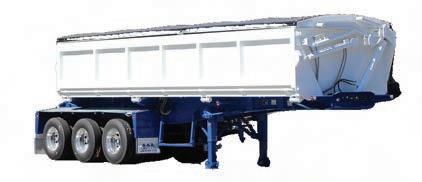









The Flygt Bartail 2125 (8kW) and 2151 (20kW) submersible pumps are continuing to lead the way in underground mine dewatering.
The Bartail duplex white iron and duplex stainless steel hydraulic end is engineered to best handle the highly erosive underground conditions whilst also being better suited for corrosive applications.
The Flygt aluminum drive unit coupled with the Bartail wetend delivers proven performance whilst increasing product longevity.

